
- Around China

2024 Xian Terracotta Warriors Visit: Your Ultimate Guide Unveiled
I recall watching a documentary about the Terracotta Warriors at home one year. In the film, the primary narrator, a photographer capturing the Terracotta Warriors, unexpectedly broke into tears. He recounted a moment when, up close, he noticed the craftsman’s fingerprints on a terracotta figurine’s mouth, left there 2,000 years ago during the creation of the warriors. In that poignant instant, it felt as if he had transcended time, with his camera revealing a craftsman shaping terracotta warriors right before him. The photographer was so moved that he exclaimed in astonishment.
While I couldn’t fully comprehend the photographer’s emotions at that moment, the scene planted the idea in me that I must visit Xi’an to witness the Terracotta Warriors and Horses in person. It sparked a desire to truly immerse myself in the weight and depth of their historical significance.
You might also be interested in: 🌟 The Ultimate Great Wall Travel Guide + The Best Sections To Visit 💛 The Forbidden City, Beijing: The Complete 2023 Guide
Table of Contents
🌟xi’an travel planning guide, 🌏where is terracotta warriors located.
- 📕The History of Terracotta Warriors
🚗How to Get to Terracotta Warriors from Downtown Xi’an
🎫visiting the terracotta warriors, 🔮the overview of terracotta warriors, 👑museum of terracotta warriors and horses, 🔱qin shi huang’s mausoleum site park, 🔔33 facts about the terracotta warriors, ⭕ pitfalls to be aware of when exploring the terracotta warriors, 🌸final tips on traveling to terracotta warriors, china travel planning guide&faq.
Disclosure: This article contains affiliate links. If you make a purchase after clicking one of these links, I earn a small commission at no extra cost to you. You can learn more about this in my disclosure policy.
⭐ Considering a last-minute trip to Terracotta Warriors? Customized Private Day Tour of Terracotta Warriors and Xi’an : Opt for a private driver to swiftly reach the Terracotta Warriors from Xi’an, bypassing tour crowds. Tailor your itinerary and skip unwanted detours or stops. 🇨🇳 Top Activities and Tours in Xi’an: 1. Xian’s Top Attractions Explored in a Small Group Day Tour : Explore Terracotta Army, City Wall, Pagoda and Muslim Bazaar 2. Xi’an Evening Food Tour by TukTuk : Discover Xian’s charming streets, dine at beloved local spots within the city walls, savor unlimited food and drinks, including beer. 🏨 Where to Stay: Sheraton Xi’an North City Hotel (⭐️ 4.7 luxury) Shangri-La Hotel, Xi’an (⭐️ 4.7 mid-range) Man Xin Hotel Xi’an Gate Tower South Gate (⭐️ 4.8 budget-friendly) 🌐Make sure to install ExpressVPN in advance for unrestricted internet access during your stay in China!
The Terracotta Warriors are located in the city of Xi’an, in the Shaanxi province of China. Specifically, they are housed in the Qin Shi Huang Mausoleum, which is situated about 1.5 kilometers east of the Emperor’s burial site. The mausoleum complex includes three main pits where the Terracotta Army is displayed.
Xi’an is a historically significant city and was the capital of several ancient Chinese dynasties, making it a cultural and archaeological hub. The Terracotta Army is a major attraction in Xi’an and draws millions of visitors from around the world to witness this remarkable archaeological find.
📕 The History of Terracotta Warriors
The Terracotta Army has a long history, going back more than 2,200 years. It was made between 247 BC or 246 BC and 208 BC to guard Emperor Qin Shi Huang in the afterlife. Skilled artists crafted thousands of life-sized clay soldiers, horses, and chariots just for him. In 1974, farmers near Xi’an found it by accident, revealing the incredible skills of ancient Chinese artists and warriors. The figures stand in organized groups in three pits, showing how smart the ancient Chinese were in planning their battles.
Beyond its original funerary purpose, the Terracotta Army serves as a cultural treasure, offering insights into Qin Dynasty aesthetics, technology, and military strategies. Designated a UNESCO World Heritage Site in 1987, it continues to captivate millions of visitors, revealing a vivid snapshot of China’s ancient past.
Right now, there’s no direct public transportation to the Terracotta Army from downtown Xi’an. So, the best choice is to join a Xi’an day tour that includes this site with a good service and price.
If you prefer to go on your own, here’s how:
- By Metro : Take metro line 1 to Fangzhicheng, the last stop. Then, catch tourist bus 5 (306) from a bus stop about 25-30 meters north, near Fangzhicheng Bus Station. These buses run from 7:00 to 19:00 and cost CNY 5. They’ll take you to the Terracotta Warriors Museum.
- By Taxi : If you opt for a taxi from downtown Xi’an, it’s about a 1-hour ride and costs around CNY 150.
- Private Car or Tour : If you prefer a more comfortable and private experience, consider hiring a private car or joining a guided tour . Many tour operators in Xi’an offer packages that include transportation to the Terracotta Warriors.
🌷Tips: The fee covers an all-inclusive ticket for Emperor Qinshihuang’s Mausoleum Site Museum, encompassing the Museum of Qin Terracotta Warriors and Horses, Qin Shi Huang’s Mausoleum Site Park (Lishan Garden), along with complimentary shuttle bus service between the two locations from 8:30 to 18:30.
Emperor Qin Shi Huang’s Mausoleum Site Museum was constructed based on the Qin Shi Huang Mausoleum. The museum consists of two main sections: the Museum of Terracotta Warriors and Horses of Qin Shi Huang and Qin Shi Huang’s Mausoleum Site Park (known as Lishan Garden).
Within the Museum of Terracotta Warriors and Horses, you can explore Terracotta Warriors Pit 1, 2, and 3. On the other hand, Qin Shi Huang’s Mausoleum Site Park currently features Pit K9901 – Acrobatics Figures, Pit K0006 – Civil Official Figures, the Museum of Bronze Chariot and Horse, and the Qin Shi Huang Mausoleum.
When you visit Emperor Qin Shi Huang’s Mausoleum Site Museum, you’ll have the opportunity to witness these remarkable thousand-year-old relics all in one go.
Terracotta Warriors Pit 1
Terracotta Warriors Pit 1 is a rectangular pit oriented east to west, spanning 230 meters in length, 62 meters in width, and with a depth ranging from 4.5 to 6.5 meters. Covering an expansive area of 14,260 square meters, it holds the distinction of being the largest pit within Emperor Qin Shi Huang’s burial complex.
To put its vastness into perspective, this area surpasses that of two football fields combined. When fully excavated, it is anticipated that more than 6,000 terracotta warriors and horses, along with over 50 chariots, could be unearthed. Presently, only a fraction of the terracotta warriors have been restored and are on display, yet they stand in impressive formation, even though they represent less than a third of the total ensemble.
Terracotta Warriors Pit 1 was unearthed by local villagers in March 1974 while they were in the midst of combating a drought and digging wells. Following its discovery, a substantial arched hall was constructed above the pit in 1976 to ensure its preservation. This remarkable site was then opened to the public on October 1, 1979.
What’s inside Terracotta Warriors Pit 1?
👍military formation.
A military formation refers to the structured arrangement of an army in battle or during stationing. The composition of the Qin Terracotta Warriors and Horses mirrors the military formation of the Qin army.
At the forefront of the pit, there were three rows of warriors adorned in armor and armed with bows and crossbows, serving as the vanguard of the entire military formation. Their primary role was to engage the enemy from a distance.
Following the vanguard were the main forces, which consisted of 38 long columns of infantry, cavalry, and war chariots.
To safeguard the south, north, and west boundaries of the pit, a row of warriors was strategically positioned facing outward, serving as the flanks and rear guards of the military formation. Their purpose was to thwart any potential enemy advances from the north, south, and rear, preventing surprise attacks.
👍Terracotta Warriors
Considering today’s criteria for regional and ethnic distinctions, these terracotta warriors represent a diverse mix, featuring individuals from the south, north, Han ethnicity, and various ethnic backgrounds.
Looking at their appearances, it’s clear that there are not only middle-aged individuals but also teenagers and even elderly figures with long beards among the terracotta warriors. This corresponds with historical records from the Qin State, where during times of conflict, men between the ages of 17 and 60 were required to serve in the military, and when the situation became particularly tense, 15-year-old boys were also called upon to go to the battlefield.
The younger warriors appeared quite innocent and inexperienced when it came to warfare, while the middle-aged ones were confident, courageous, and filled with aspirations, viewing war as a potential life-changing opportunity.
The older warriors, who likely endured numerous battles and witnessed the grim realities of warfare, adopted a more solemn and cautious demeanor.
What’s truly astounding is that over 1,000 restored terracotta warriors each possess their own unique features, making this an extraordinary achievement in the history of sculpture worldwide.
The Terracotta Warriors Pit isn’t just a treasure trove of art; it’s like stepping into an ancient armory.
When you see those terracotta warriors with their fists half-clenched, it’s pretty clear they once wielded weapons. In fact, archaeologists have uncovered over 40,000 bronze weapons in Pit 1, with more than 30,000 of them being bronze arrowheads.
These were the real deal, actual weapons used in battles during that era. They come in different varieties, including long weapons, short weapons, and long-range weapons. While the wooden handles have deteriorated over time, the bronze parts are remarkably well-preserved.
The color of the terracotta warriors adds an intriguing element of mystery. While they now appear uniformly gray, when you stand by the pit and gaze at the vast army, you can’t help but be imbued with a deep sense of ancient wonder.
Recent excavations have revealed that the terracotta warriors weren’t uniform in terms of hair color, skin tone, and clothing hues.
Their hair ranged from jet black to tanned. The exposed parts of their faces, hands, and feet displayed variations in skin tones, including shades of pink, flesh red, and white. Even the irises of their eyes differed, with some having dark red, pitch black, or light brown hues.
Although much of the clothing’s original color has faded over time, remnants found in the soil reveal a diverse palette, including red, green, blue, purple, and even snow blue. Upon comparing these color samples, archaeologists have identified a remarkable 17 different colors within the pit, with purple and blue being particularly precious.
What caused the burning and destruction of the Terracotta Warriors?
Shortly after the construction of the Terracotta Army, it suffered intentional damage when it was deliberately set on fire. This led to the collapse of the entire terracotta pit and caused significant harm to the terracotta warriors and horses.
The partially damaged terracotta warriors we see in the middle are how they appeared when initially unearthed. The fully intact terracotta warriors and horses in front of them were carefully restored and placed back in their original positions.
As for who was responsible for the destruction of the Terracotta Warriors, there are various theories. Most scholars believe it might have been Xiang Yu, a powerful figure during the West Chu Period (232 – 202 BC), who set fire to the pit. However, some scholars propose it could have been part of a funeral custom, while others suggest the possibility of spontaneous methane combustion.
Terracotta Warriors Pit 2
They discovered the Terracotta Warriors Pit 2 in April 1976 while constructing the Pit 1 exhibition hall. It has an L-shaped layout, measuring 96 meters from east to west and 84 meters from north to south, covering an area of approximately 6,000 square meters.
Excavation of Pit 2 commenced on March 1, 1994, and it opened to the public on October 1 of the same year.
To date, they have fully excavated only one-sixth of the pit, while the remainder has been partially unearthed, revealing the remnants of wooden shelters. These wooden shelters served as the roofs of underground structures during that era. Some of them were damaged by fire, while others deteriorated and collapsed naturally.
Test excavations have indicated that Pit 2 represents a military formation comprised of chariots, infantry, cavalry, and archers. If all the excavations are completed, it is estimated that more than 1,300 terracotta warriors and horses, along with 89 wooden chariots, can be unearthed.
What’s inside Terracotta Warriors Pit 2?
In contrast to Terracotta Warriors Pit 1, Terracotta Warriors Pit 2 distinguishes itself with a wide variety of military units and intricate battle formations.
It comprises four separate arrays tailored to various types of armies, which encompass chariots, cavalry, archers, and a mixed composition of chariots, infantry, and cavalry.
👍Chariots Array
Situated at the pit’s southern end is the chariot array, covering an area of 2,400 square meters. This formation consists of sixty-four terracotta chariots, organized into eight rows.
Each chariot is drawn by four terracotta horses, accommodating three occupants, including one driving the horses. A terracotta warrior on each side wields a long weapon.
These chariots are equipped with both long-range bows and arrows, as well as close-range weaponry like spears, dagger-axes, halberds, and various other arms.
Notably, there is no infantry following behind the chariots, which distinguishes this formation from the one found in Pit 1. This represents a new development not observed since the Yin and Zhou dynasties.
👍Infantry, Calvary, and Chariot Array
In the center of the pit, you’ll find a mixed formation consisting of 19 chariots, 264 infantry, and 8 cavalry units.
This army formation is characterized by the integration of chariots and infantry, with the chariots positioned at the forefront and the infantry following behind. The agile cavalry units are strategically placed at the rear of the formation, serving multiple roles, including mobility, communication, and the ability to accompany the chariots in raids against the enemy. This arrangement compensates for the limitations of a large formation and the challenges associated with movement.
👍Cavalry Array
In the pit’s northern section, you’ll find a formation of cavalry. This assembly consists of 108 cavalry units, grouped in sets of four, standing in an orderly rectangular arrangement, with riders positioned on the left side of their horses.
This discovery represents the earliest instance of a substantial number of terracotta cavalry found in China’s archaeological record, providing a genuine portrayal of the cavalry during the era of Qin Shi Huang.
👍Archers Array
At the furthest eastern end of the pit, you’ll find the archers array, which includes 172 standing archers dressed in combat attire and 160 kneeling archers outfitted in armor.
The standing archers are positioned along the corridor encircling the archer array, while the kneeling archers are situated within the four east-west passageways at the center. This configuration is designed to align with the tactical characteristics of archery.
This is essential because when archers take aim, they must have an unobstructed view without any standing soldiers in front of them, and loading the crossbow is a relatively slow process, allowing for the firing of at most three arrows before the enemy advances. To maintain a consistent rate of fire and timing, the archers alternate between kneeling and standing positions, preventing the enemy from mounting an effective offense and significantly increasing their lethality.
Exhibition Hall of Terracotta Warriors Pit 2
Furthermore, Pit 2 houses a spacious exhibition hall where visitors can closely inspect the details of the terracotta warriors, particularly notable among them are the kneeling archers, general warriors, and cavalry warriors.
The kneeling archers, with their shorter stature that protected them from significant damage during the pit’s collapse, stand out as the most intact among the unearthed warriors. Remarkably, the anti-slip prints engraved on the soles of their shoes are still visible.
The general warriors were attired in meticulously crafted scale armor embellished with painted patterns along the edges, featuring an upward-curved toe cap. The overall craftsmanship was of exceptional quality, and every detail reflected their distinctive noble rank. The number of general warriors within the Terracotta Army is exceedingly limited, with only nine discovered thus far.
The cavalry warrior represents the inaugural portrayal of ancient cavalry in Chinese archaeological history. Clad in a sleek and lightweight ensemble with tight sleeves, his attire incorporates the advantages of Hu clothing, rendering it more lightweight than that of other warriors. Adhering to Qin regulations prohibiting the use of uncastrated horses, the terracotta horses in this collection have tails trailing on the ground, resembling pigtails.
Terracotta Warriors Pit 3
The names of Terracotta Warriors Pits 1, 2, and 3 reflect the order in which they were discovered. Pit 3 was the latest to be uncovered, in May 1976, and it was made accessible to the public on September 2, 1989.
Pit 3 encompasses an area of 520 square meters, making it the smallest among the three primary pits. Its layout is designed in the shape of the Chinese character “凹,” which is divided into three sections: a chariot and horse chamber, a northern wing room, and a southern wing room. Within this pit, a total of 68 terracotta warriors, 4 terracotta horses, 1 wooden chariot, and 34 weapons were excavated.
The Terracotta Army’s Command Center?
Although Pit 3 is relatively small, its significance is substantial. Archaeological experts suggest it served as the command center for overseeing the military formations in Pits 1 and 2.
There are four key reasons supporting the idea that Pit 3 functioned as a command center:
First, the 42 terracotta warriors in the southern wing room and the 22 terracotta warriors in the northern wing room are strategically positioned to face each other along the passageways leading to the main hall. This arrangement suggests their role in guarding the officers or commanders.
Second, the 34 weapons discovered in Pit 3 are primarily made of bamboo and seem rudimentary, more suitable for self-defense rather than actual combat.
Third, the overall layout of Pit 3 differs from Pits 1 and 2. Copper rings and lintels were found at the boundaries of the southern, northern, and central areas, suggesting that curtains once separated these spaces. The southern wing room was likely used for meetings and deliberations.
Furthermore, in the northern wing room, there was a pile of animal bones and a piece of antler. Antlers were considered sacred objects used for communication with gods during sacrifices, indicating this space might have been used for divination and religious ceremonies.
The chariot found in the chariot and horse chamber is completely painted, and it is accompanied by four soldiers situated behind it. Their responsibilities encompass relaying military orders, engaging in combat, and aiding the commander in communicating signals for both marching and battle.
Fourth, when considering its location, Pit 3 is situated behind Pits 1 and 2, hidden and relatively secure.
Taking these factors into account, it’s plausible that Pit 3 served as the command center for the entire subterranean army. However, no high-ranking commander has been discovered within it.
Who could serve as the commander of Terracotta Warriors Pit 3?
Most experts suggest that Emperor Qin Shi Huang served as the commander of this underground army. This inference is drawn from the highly centralized nature of the Qin Empire, where there was no designated commander during peacetime, and Qin Shi Huang held the supreme authority.
Furthermore, the fact that the warriors in Pits 1 and 2 appear to be in a state of readiness suggests that the commander had not yet been designated, making it likely that Qin Shi Huang assumed this role.
Nonetheless, some experts hold a different perspective. Approximately 150 meters west of Pit 3, a tomb dating back to the Qin Dynasty was discovered. Certain experts speculate that the occupant of this tomb might have served as the commander-in-chief. However, as the tomb remains unexcavated at this time, this theory requires further verification.
Terracotta Warriors Pit 3 remained unburned
No evidence of burning was discovered in Pit 3. However, it was observed that prior to the pit’s collapse, extensive human-induced damage occurred, resulting in numerous terracotta warriors without heads and significant harm to the terracotta warriors and horses.
Upon excavation, the terracotta warriors displayed vibrant paint, as depicted in the accompanying photos in the light box. Unfortunately, due to the lack of preservation technology at the time, almost all the colors were lost.
Bronze Chariots and Horses
In December 1980, archaeologists unearthed a pair of large painted bronze chariots and horses positioned 20 meters west of the Qin Shi Huang Mausoleum, buried at a depth of 7.8 meters from the earth’s surface.
These two bronze chariots and horses were originally placed in a wooden box. Due to the decay of the wooden box, the upper part’s filling collapsed, causing the bronze carriages and horses to be crushed before excavation. However, since they remained undisturbed, there was minimal alteration in their original positions, and their components are largely intact. These findings represent the earliest, largest, and best-preserved bronze carriages discovered in China.
Adorned with cloud, geometric, and dragon patterns, the two bronze chariots and horses exhibit intricate craftsmanship. The welds on the horses’ necks are so fine that they can only be discerned under a 24-fold magnifying glass. Despite the current dimmed coloration, historical records suggest that the horses were originally white, and the entire carriage possessed a bright and dazzling appearance.
No. 1 Bronze Chariot and Horses and No. 2 Bronze Chariot and Horses
These two chariots and horses are miniature replicas, half the size of the actual ones from the Qin Dynasty. They served as the mode of transportation for Qin Shi Huang’s soul during his journeys in the underworld. Crafted from bronze and cast bullion, they also feature substantial amounts of gold and silver pieces, totaling around 14 kilograms (30 pounds) in weight. The material value is significant, and their historical importance should not be overlooked.
In the order of their discovery, they were designated as No. 1 Bronze Chariot and Horses and No. 2 Bronze Chariot and Horses. The former features an open design with a large umbrella on top for shade, where the driver stands beneath it. The latter, No. 2 Bronze Chariot and Horses, is enclosed with an umbrella-shaped roof symbolizing the expansive sky. It is divided into two spaces, with the front area for the driver and the rear space for the master.
Sophisticated manufacturing techniques
Qin craftsmen employed a variety of exceptional techniques such as casting, soldering, and riveting in the manufacturing of bronze chariots and horses. These artifacts comprise over 7,500 individual and independent components, posing a significant challenge in their creation. Let’s delve into the manufacturing process by examining the roof of the No. 2 Bronze Chariot and Horses.
While traditional utility carriage roofs were made of silk, Emperor Qin Shi Huang’s bronze carriage featured a bronze roof. Despite the shift in material, craftsmen skillfully conveyed the thickness, texture, and pattern of silk on the bronze roof. This thin and smooth bronze roof, adorned with delicate patterns on both sides, presented a formidable challenge. The oval roof on the No. 2 Bronze Chariot and Horses spans 2.3 square meters and measures a mere 1 to 4 millimeters in thickness.
Contemporary attempts to replicate the original bronze chariot and horse, involving foundry experts simulating the Qin Dynasty’s manufacturing process for roof production, have not succeeded. The technical challenges overcome by Qin craftsmen over 2,000 years ago remain unsolved. The roof, just one of many components, underscores the intricate nature of the manufacturing process. Crafting such an exquisite “bronze crown” proves to be a formidable task.
Remarkably, the various chains on the chariots and horses still move smoothly, and doors and windows open and close freely. Despite the passage of more than two millennia, these artifacts maintain their functionality, capable of carrying people and being driven.
The significance of the Bronze Chariots and Horses
Beyond their impressive appearance, the Bronze Chariots and Horses hold greater significance. Prior archaeological findings of chariots were wooden and had decayed upon discovery. The unveiling of the bronze chariots and horses allowed us, for the first time, to witness Emperor Qin Shi Huang’s chariot and holds immense value for studying the smelting, bronze manufacturing technology, and vehicle structure during the Qin Dynasty in China.
Pit K9901 – Acrobatics Figures
The southeast region of the Qin Shi Huang Mausoleum houses Pit K9901, also recognized as Acrobatics Figures Pit. Shaped like the Chinese character “凸,” the pit spans approximately 40 meters from east to west and 15 meters from north to south, boasting a total area of around 880 square meters. Test excavations were conducted on Pit K9901 by the archaeological team in 1999 and 2002, with another round of excavations occurring on June 4, 2011. The site has since been thoroughly cleaned.
1999: The initial excavation of Pit K9901
👍bronze tripod.
In 1999, archaeologists conducted a localized test excavation covering an area of less than 70 square meters. During this excavation, a sizable bronze tripod was discovered atop the wooden shelter within the pit. The bronze tripod boasts a caliber of 70 centimeters, a height of 61 centimeters, and a weight of 212 kilograms. It is recognized as the inaugural tripod found in the Qin Shi Huang Mausoleum.
👍11 Acrobatics Figures
Furthermore, 11 terra-cotta figurines were unearthed, all exhibiting damage, particularly to their heads. Following restoration efforts, their bodies were successfully returned to their original state. These figurines were characterized by the absence of armor or battle robes; instead, they wore lower-body clothing while leaving the upper body bare and muscular.
They assumed various poses and gestures, including sitting upright, standing, lunging with two legs, lifting with one hand, breaking objects with both hands, featuring one with a distinctive “beer belly” and a small skirt tied around the waist—typical attire for juggling during that historical period. These findings clearly demonstrate the unmistakable characteristics of ancient acrobatics and music.
2011: The second time excavations of Pit K9901
In June 2011, the second archaeological excavation of Pit K9901 commenced. This excavation yielded the discovery of over 30 new terracotta figurines, surpassing previous finds in terms of diversity in color, patterns, as well as postures and gestures.
Notably, one of the figurines stood out for its exaggerated dimensions, measuring 2.2 meters tall without its head, and featuring a foot length of 0.32 meters.
Among the more than 30 figures discovered, only 2 had upper body clothing, adorned with circular decorations measuring 3.5 centimeters in diameter. The painted depictions of these figures emphasized skin tones and clothing, with the garments featuring decorative elements in red, purple, black, and red hues. The predominant skin tone was pink.
Reports suggest that these terracotta figurines bear similarities to those first unearthed in 1999, indicating a connection to the art and entertainment culture within the royal court of the Qin Dynasty.
Pit K0006 – Civil Official Figures
Situated in the southwest corner of the Qin Shi Huang Mausoleum, Pit K0006 boasts a layout resembling the Chinese character “中” (zhōng), comprising a slope gateway, a front pit, and a back pit. Covering a total area of 410 square meters, it functions as a basement structure with a civil engineering design.
On July 12, 2001, archaeologists conducted an extensive excavation and cleaning of the pit, unveiling civil officials’ figures that had been concealed for over 2,200 years. The slope gateway is located at the west end, leading to both the front and back pits, with the front pit having a larger area. In the front pit, 12 standing terracotta figurines were discovered, arranged neatly on the floor, some with their bodies separated from their heads.
Terracotta Figures of 4 Charioteers
The 12 terracotta figurines exhibit two distinct categories based on their posture and attire. Among them, four figures are recognized as Yushou Figures, assumed to be charioteers. These figures extend their arms with semi-clenched fists, suggesting they once held bridle reins, indicative of their role as chariot drivers in ancient times.
When compared to the chariot warriors in the Museum of Qin Terracotta Warriors and Horses, these Yushou Figures share similarities in clothing, including shoes and crowns, despite the absence of armor. Their status titles are presumed to be at a comparable level.
Terracotta Figures of 8 Civil Officials
In Pit K0006, eight civil official figures, also known as Xiushou Figures, feature distinctive accessories: a yue axe and a small cloth bag hanging on the right side of their belts. These unique ornaments mark a departure from previous discoveries of terracotta figurines.
The importance of the “yue axe” lies in its connection to ancient bamboo slip writing. As per cultural relics experts, in ancient times, the yue axe was employed to scrape off inaccurately written words on bamboo slips before they were rewritten using a brush.
The small cloth bag adjacent to it is speculated to have functioned as a holder for a knife stone. As the yue axe’s edge dulled through repeated use, the knife stone proved valuable for sharpening.
Additionally, a 3×9 cm oval gap between the left arm and the body of the Xiushou Figures is believed to have accommodated a bamboo slip used for recording information.
These civil official figurines, the first of their kind unearthed in the Qin Shi Huang Mausoleum, display unique facial expressions and temperaments. In contrast to the resolute and powerful demeanor of the terracotta warriors, the civil official figures convey an impression of gentleness, elegance, humility, and courtesy.
Other discovery
Furthermore, the front pit yielded remnants of a wooden chariot, while the back pit revealed the burial of 20 horse bones and the unearthing of four bronze battle axes. Archaeologists infer that chariots and horses held symbolic significance as status symbols. The excavation of the Civil Official Figures pit presents valuable material for delving into the study of the funeral system within the Qin Shi Huang Mausoleum and the civil official system of the Qin Dynasty.
1. How did the Terracotta Warriors discover?
The prevailing belief attributes the discovery of the Terracotta Warriors to local peasants who initiated well-drilling activities in 1974 at Xiyang Village in Lintong District, situated around 40 km (25 mi) to the east of Xi’an.
However, archaeological findings have demonstrated numerous instances in earlier historical periods where individuals encountered fragments of terracotta warriors through various means. Certain experts in archaeology reconstructed these terracotta fragments into warriors and horses, leading to the realization that these constituted the army buried alongside the Qin Shi Huang Mausoleum. This, in essence, marks the authentic discovery of the Terracotta Warriors and horses.
2. How long is the history of the Terracotta Warriors?
The Terracotta Army, constructed over 2,200 years ago, was built from either 247 BC or 246 BC to 208 BC. According to the historical account in the Shih Chi, Emperor Qin Shi Huang, who ascended to the throne at the age of 13 in 259 BC, ordered the construction of his mausoleum shortly after becoming the king of the Qin State. This directive is believed to have been given around 247 BC or 246 BC. The extensive construction project concluded in 208 BC, just two years after the death of Qin Shi Huang.
3. What prompted Qin Shi Huang to choose Mount Li for his mausoleum?
The choice of Mount Li as the location for the mausoleum is linked to the burial of Qin Shi Huang’s ancestors at the western foot of Mount Li. However, due to insufficient space in the western foothills to accommodate a large-scale mausoleum, the decision was made to construct the Qin Shi Huang Mausoleum at the northern foot of Mount Li. This location allowed proximity to the tombs of his ancestors while also adhering to the ritual practices of the time.
Moreover, the positioning of the Qin Shi Huang Mausoleum at the northern foot of Mount Li adheres to traditional Chinese Feng Shui principles for selecting burial sites. According to these principles, an ideal site should be nestled under a mountain and near a river, symbolizing blessings for future generations.
4. What is the size of the Qin Shi Huang Mausoleum?
The Qin Shi Huang Mausoleum is a comprehensive concept centered around the tomb but extending beyond its confines. The tomb is thought to comprise an inner city and an outer city.
Based on current findings, the Qin Dynasty mausoleum measured approximately 220,000 square meters, while the present mausoleum covers about 122,500 square meters. The tomb enclosed by the larger inner city has an area of nearly 800,000 square meters, and the tomb enclosed by the outer city has a total area of 2,180,000 square meters.
5. Has the Qin Shi Huang Mausoleum experienced fire or theft?
Historical accounts document incidents of the Qin Shi Huang Mausoleum being set ablaze and plundered. Modern archaeological findings reveal the aftermath of a fire throughout the entire mausoleum, with terracotta warriors’ pits and surface structures displaying clear signs of fire damage and intentional destruction. Nonetheless, there is no current archaeological evidence indicating that the primary burial chamber of the Qin Shi Huang Mausoleum was subjected to burning or robbery.
6. Is there a plan for ongoing archaeological protection of the Qin Shi Huang Mausoleum?
Since the late 1980s, the State Administration of Cultural Heritage has consistently underscored stringent control over the approval and management of active archaeological excavation projects through official documents and meetings. The fundamental principle of refraining from actively excavating the Qin Shi Huang Mausoleum has been explicitly stated.
Currently, comprehensive research is being conducted on the excavation and preservation of various sites and tombs. This includes non-destructive survey research prior to initial excavation, on-site protection, and retrieval of cultural relics during excavation, as well as the preservation and restoration of various types of cultural relics after their excavation. In essence, specialized research is being conducted across all aspects of archaeological work.
7. Were those involved in the construction of the Qin Shi Huang Mausoleum buried alive?
According to historical records, following the burial of Emperor Qin Shi Huang, it is said that the craftsmen who had constructed the machinery were privy to the numerous and valuable treasures concealed within the tomb. Fearing the potential leakage of this information, after the elaborate funeral and the placement of treasures, the innermost and outermost doors of the tomb were sealed shut. Subsequently, all the craftsmen involved were enclosed within the tomb, and none of them emerged again.
8. How far has the Terracotta Warriors excavation progressed?
Currently, three pits are open for public exhibition at the Terracotta Warriors site. Terracotta Warriors Pit 1, covering approximately 14,260 square meters, has revealed one-third of its area. While the exact number of terracotta figurines is unclear, based on the density of the excavated section, there are believed to be over 6,000 terracotta figurines and pottery horses in total. Among them, more than 2,000 terracotta warriors and horses and over 20 chariots have been unearthed.
Terracotta Warriors Pit 2 spans an area of over 6,000 square meters and represents a military formation with chariots, infantry, cavalry, and archers. If fully excavated, it is estimated that more than 1,300 terracotta warriors and horses, along with 89 wooden chariots, could be unearthed. Currently, one-sixth of this pit has been excavated.
Completing the excavation of these two pits is anticipated to require another century or even longer. Terracotta Warriors Pit 3 has already been fully excavated. On the other hand, Terracotta Warriors Pit 4 is subject to controversy, and recent exploration data suggests that it may not actually exist.
9. Why do the Terracotta Warriors remain well-preserved over time?
The terracotta warriors and horses were crafted through a molding process using clay. The molded combination underwent firing in kilns at temperatures ranging from 950 °C to 1050 °C. The resulting terracotta bodies are characterized by thickness (2-6 cm) and a hard texture.
Furthermore, the construction of the terracotta warriors and horses was an extensive, intricate, and massive undertaking. It involved the implementation of advanced technologies, including an underground drainage system and a support structure. These innovations not only fortified and concealed the mausoleum but also laid a robust foundation for subsequent preservation efforts.
10. What are the Terracotta Warriors made of?
The Terracotta Warriors are made primarily of clay. The clay used for their construction is a type of fine-grained, high-quality material. The artisans molded the figures by hand, and each warrior was individually crafted. After shaping, the figures were fired in kilns, which helped harden the clay and make the statues more durable. The use of clay as the primary material allowed for intricate details and realistic representations of the warriors.
11. Were the Terracotta Warriors buried before or after firing?
12. where were the kilns located for firing the terracotta warriors.
The kilns were discovered south of Xiahe Village, just a few hundred meters away from the Terracotta Warriors and Horses site. Given the large size of the terracotta warriors and horses, it is presumed that they were challenging to transport over long distances for firing. More than ten terracotta figurines have been uncovered in the vicinity of the kilns, though the count is relatively modest. It is anticipated that additional kilns may be unearthed in the future, shedding further light on the production processes and scale of terracotta figure manufacturing in the area.
13. How many terracotta warriors and horses have been discovered?
As of the last knowledge update in January 2023, it is estimated that over 8,000 terracotta warriors and horses have been discovered in the archaeological pits near the mausoleum of the first Emperor of Qin Shi Huang. However, please note that ongoing excavations may have revealed additional figures, and the total count may have changed since then.
14. How many types of terracotta warriors?
The terracotta army consists of various types of warriors, each serving a specific function within the burial complex. The main types include:
Infantry : These are the standard soldiers armed with weapons like bows, crossbows, and spears. They make up the majority of the terracotta army.
Archers : A significant portion of the terracotta warriors are archers. They are equipped with bows and arrows, ready for long-range attacks.
Cavalry : The cavalry units are warriors mounted on terracotta horses. They played a crucial role in ancient Chinese warfare.
Generals and Officers : Some terracotta figures are identified as high-ranking officers or generals. They often have distinct armor and more elaborate headdresses.
Charioteers : These figures represent warriors driving horse-drawn chariots, showcasing the importance of chariot warfare in ancient China.
Acrobats and Musicians : There are also terracotta figures depicting entertainers, such as acrobats and musicians, providing a glimpse into the cultural aspects of the time.
15. What are the weights of individual terracotta warriors and horses, and which one is the heaviest?
The weight of individual terracotta warriors and horses can vary depending on their size and specific features. Typically, a life-sized terracotta warrior may weigh around 136-181 kg, with the heaviest being the terracotta horse, exceeding 300 kg. However, larger figures like chariots and generals can weigh considerably more.
Among the terracotta warriors, the heaviest are the general warriors, weighing about 250 kg, while the lightest is the kneeling archer at approximately 100 kg. These variations in weight highlight the diversity in size and design among the different figures within the terracotta army.
16. What is the value of a single Terracotta Warrior?
It is challenging to assign a specific monetary value to a single terracotta warrior, as these artifacts are invaluable in terms of historical and cultural significance. The terracotta army is considered one of the most important archaeological discoveries of the 20th century, and the figures are regarded as priceless artifacts.
17. Are the Terracotta Warriors vulnerable to damage from fire or flood?
The Terracotta Warriors are indeed vulnerable to specific environmental factors, and extensive measures are taken to shield them from potential damage.
Cultural relics protection constitutes a comprehensive system that encompasses various aspects. This includes considerations ranging from the microenvironment, such as the display cabinet and site hall where the cultural relics are housed, to the macroenvironment of the museum area, the entire protection zone, and even the surrounding vicinity. The management of these factors falls within the purview of conservation research, necessitating careful consideration and control.
18. Have the Terracotta Warriors been stolen post-excavation?
In the 1980s in China, there was a notable occurrence of theft involving terracotta warriors. Thanks to the full cooperation between public security and cultural relics departments, the stolen cultural artifacts were successfully recovered. In an effort to combat the widespread criminal activities targeting cultural relics, the individuals involved in the theft were legally sentenced to death as a deterrent measure.
19. Are the exhibited Bronze Chariots and Horses original or replicas?
Currently, the museum showcases the authentic No. 1 Bronze Chariot and Horses, while the No. 2 Bronze Chariot and Horses are undergoing three-dimensional digital acquisition for research purposes. During this process, a sizable replica is temporarily on display.
20. How effective is the Terracotta Army in combat compared to Western soldiers from the same era?
In contrast, each possesses its own set of strengths and weaknesses. Simply put, there are distinct differences as follows.
First, the military objectives vary. The Qin army aimed to inflict casualties, harm, and destroy the enemy, while the Western army primarily sought victory.
Second, the organization of the military differs. The Qin army predominantly employed diverse military formations, including infantry, cavalry, chariots, and archers, engaging in coordinated warfare. Conversely, the Western army typically employed attrition tactics to diminish the adversary’s combat capabilities.
Third, the methods of combat vary. The Qin army utilized long-range weapons like bows and crossbows for distant encounters and employed spears, halberds, swords, and similar arms for close combat. In contrast, the Western army favored shields, spears, and other weapons for close-quarter engagements.
21. What is the reason behind some terracotta warriors having the “general belly”?
The distinctive feature known as the “general’s belly” is observed in terracotta warriors across different ranks, and it refers to a noticeable bulging abdomen. Importantly, this characteristic doesn’t imply that the warriors were overweight or had a paunch, and it had no impact on their combat effectiveness.
The presence of the “general’s belly” is thought to mirror the dietary habits of the Qin people. Historical accounts suggest that the Qin army had a tradition of consuming considerable amounts of corn wine before and after battles. The distinctive abdominal characteristic is likely a result of the prolonged practice of alcohol consumption within the Qin military culture.
22. Do the Terracotta Warriors and horses bear inscriptions?
Since 1974, the discovery of the Terracotta Warriors Pits 1, 2, and 3 on the east side of the Qin Shi Huang Mausoleum has been a significant archaeological find. These pits house nearly 8,000 terracotta warriors and horses. Throughout the excavation and restoration process, researchers have identified carved words and seals on some of these terracotta figures.
The inscriptions on the terracotta warriors are primarily located in concealed areas such as under the arms, the bottom of clothing hems, shorts, necks, chests, arms, and abdomens. Similarly, characters on the bodies of the horses can be found on the hips, necks, abdomens, tails, and other areas.
The seals exhibit relatively regular handwriting, while the handwriting of the carved words is more haphazard, with varying word diameters and the prevalent use of official scripts. These inscriptions include names of places and individuals, providing valuable insights into the historical and cultural context of the Qin Dynasty.
23. How much do the Terracotta Warriors resemble modern Chinese people?
In terms of similarities to modern Chinese people, there isn’t a direct resemblance because the Terracotta Army figures were not modeled after specific individuals. They were mass-produced using molds, with some variations to create a sense of diversity among the soldiers. The hairstyles, clothing, and armor depicted in the sculptures reflect the styles of the Qin Dynasty.
Modern Chinese people, like any other population, exhibit a wide range of physical features, hairstyles, and clothing styles that have evolved over the centuries. While there may be certain cultural elements that have persisted, direct comparisons between the Terracotta Warriors and contemporary Chinese individuals wouldn’t be accurate or meaningful. The Terracotta Army is more of a historical and artistic representation of the past rather than a detailed portrayal of specific individuals or a specific era.
24. What is the highest rank within the Terracotta Army?
Among the higher-ranking officers in the Terracotta Army, there are generals. These generals are distinguished by their unique armor, clothing, and poses. They typically wear a square-based hat with a flat top, which is one of the indicators of their higher rank. Some of the generals are depicted standing in a commanding posture, while others are mounted on horses.
25. Do the Terracotta Warriors include women, and is there a potential for their discovery in the future?
As of the last knowledge update in January 2022, the majority of the Terracotta Warriors are male figures, representing soldiers and officials of the Qin Dynasty’s army. The ancient Chinese military was predominantly male during that period, and the Terracotta Army reflects this historical context.
While the vast majority of the figures are male, there is evidence of the inclusion of female figures in some of the pits associated with the Terracotta Army site. These figures are believed to represent palace servants or entertainers rather than soldiers.
Whether more female figures will be found in the future depends on archaeological discoveries and ongoing research.
26. What are the additional burial pits at the Qin Shi Huang Mausoleum?
According to preliminary statistics, more than 180 burial pits of various kinds have been found around the Qin Shi Huang Mausoleum. Besides the main three pits of Terracotta Army, the experts also discovered civil official figures, bronze aquatic birds, stone armor and helmets, and acrobatics figures in these accessory pits, as well as others like builders’ graveyards, slaughter pits, and stable pits. All of these accessory pits reflect the Emperor Qin Shi Huang’s idea of treating death as afterlife, who wanted to bring anything he had when alive to the afterworld so he could continue his luxurious life, and this idea was gradually adopted by emperors in later dynasties.
27. When was the Terracotta Warriors and Horses designated as a World Heritage Site?
The Terracotta Army and the Mausoleum of the First Emperor of Qin were inscribed as a UNESCO World Heritage Site in December 11, 1987. This recognition acknowledges the outstanding universal value of the site and its significance in the history and cultural heritage of humanity.
28. Were the terracotta warriors and horses originally colored, and what caused them to turn gray?
The original Terracotta Warriors and Horses were brightly colored when they were first created over two millennia ago during the Qin Dynasty (221–206 BCE). The figures were painted in vivid colors, including reds, blues, greens, and other hues. However, over time, exposure to environmental conditions, including air, moisture, floods, and fires, resulted in the gradual fading and decay of the original paint.
When the warriors were unearthed in the 1970s, the vibrant colors had largely disappeared, and the figures appeared in the natural color of the terracotta clay—gray or earth-toned. The restoration and conservation efforts focused on preserving the integrity of the terracotta sculptures, but the original colors could not be fully restored due to the fragility of the remaining pigments.
Modern technologies like multispectral imaging and 3D scanning have revealed the original colors on the Terracotta Warriors. Identified traces of ancient pigments offer insights into the original painting techniques. While the displayed warriors are in their natural terracotta color, exhibits and virtual reconstructions often employ artistry to convey the vividness of the ancient figures.
29. What steps were taken to preserve the colors of the Terracotta Warriors and Horses after excavation?
The craftsmanship of the Qin Dynasty involved a meticulous process for preserving the terracotta warriors. Craftsmen applied a layer of lacquer to the fired terracotta warriors, followed by the application of mineral pigments. However, the lacquer layer is highly sensitive to changes in water content. The underground burial environment, which tends to be relatively humid, contrasts sharply with the drier conditions upon excavation. Consequently, the lacquer layer is prone to violent deformation, leading to warping and detachment of the entire painted layer.
Therefore, the key to protection lies in stabilizing the lacquer layer. Currently, a highly effective protective measure involves carefully wetting the terracotta figurine bodies post-excavation. This process is complemented by the application of chemical reagents, such as polyethylene glycol, for moisturization. Additionally, emulsion reinforcement materials are utilized to enhance and safeguard the painted surfaces. As of now, this painting protection technology stands as the most advanced and effective method for the preservation of these historical artifacts in China.
30. Did the technology for producing Terracotta Warriors originate in China or the West?
These sculptures were not crafted as portraits of real people; instead, they are generalized depictions of soldiers and horses that would have been part of the imperial army during the Qin Dynasty (221–206 BCE).
Though lacking models of specific individuals, the Terracotta Army’s creators drew inspiration from actual Qin Dynasty soldiers, aiming to depict the diversity of the imperial forces in a generalized manner. The sculptures represent characteristics rather than exact replicas of individuals.
31. Did the technology for producing Terracotta Warriors and horses originate in China or the West?
There is no evidence to suggest that the production methods for the Terracotta Army were influenced by or borrowed from the West.
The Qin Dynasty was known for its significant contributions to various fields, including art and craftsmanship. The construction of the Terracotta Army is considered a remarkable achievement in ancient Chinese sculpture and ceramics. The production involved local artisans and craftsmen who developed the necessary skills to create the life-sized terracotta figures.
The technology used for crafting the Terracotta Army, including the use of molds and assembly-line production, was an innovation of its time and is indicative of the advanced artistic and engineering capabilities within ancient China. The production of the Terracotta Army is a testament to the craftsmanship and ingenuity of the Qin Dynasty, and it stands as a unique cultural and historical achievement within the context of Chinese civilization.
32. Does tourism development exert pressure on the excavation and preservation of the Terracotta Warriors?
The rapid growth of tourism has undeniably placed considerable stress on the excavation and preservation efforts for the Terracotta Warriors and Horses, resulting in challenges related to the conservation of cultural relics and alterations in the exhibition environment. The Museum of Qin Terracotta Warriors and Horses has responded to these challenges by implementing measures such as enhancing the museum’s interior and surrounding environment and implementing visitor limitations to alleviate the strain.
However, safeguarding cultural relics involves multifaceted considerations, and the associated issues are notably intricate. Effective protection and restoration extend beyond the responsibilities of relic preservation professionals; they necessitate the understanding and support of society at large. Only through widespread awareness and collaboration can cultural relics be adequately preserved.
1. Fake Terracotta Warriors Museum
Beware of a fake Terracotta Warriors Museum near the real one, run by a local business. Some travelers have been tricked into touring this imitation. To ensure you see the authentic Terracotta Army and avoid scams, use a trustworthy travel agency. If going solo, take public transport like tourism bus line 5 (306) or an official taxi from Xi’an. Ignore people in the parking area offering to guide you. Knowing the real Terracotta Warriors’ look and size in advance is essential.
2. Fake Tourist Bus or Unauthorized Taxi
If you find yourself at Xi’an Railway Station, intending to take a bus to the Terracotta Warriors, be cautious if, upon reaching Lintong, the bus halts and the driver insists on transferring you to another seemingly free private car for a direct journey to the Terracotta Warriors. This is often the initial stage of a scam, involving middle-aged, unemployed individuals in Lintong. These drivers might divert you to fake Terracotta Army sites, various Lintong scenic spots, or coerce you into patronizing jade shops to extract money from you.
It’s worth noting that Tourism Bus No. 5 (306), previously operating between Xi’an Railway Station and Terracotta Army, has relocated to Fangzhicheng Bus Station and no longer makes a stop at Xi’an Railway Station.
If opting for a taxi, consider taking one from downtown Xi’an to steer clear of potential scams prevalent at the railway station.
3. Fake Tour Guide
Upon your arrival at the Terracotta Warriors, be cautious if a tour guide approaches you, offering guide services and claiming to provide discounted tickets. They may assert a long-standing collaboration with museums. However, if you hand over money and request them to purchase tickets on your behalf, beware of potential fraud. There have been instances where the guide takes the money and disappears, leaving you unable to locate them again.
To avoid such unfortunate situations, it is advisable to purchase your tickets through official channels. Do not trust offers of discounted or low-cost tickets, as they may be part of scams or unauthorized schemes.
4. Fake Jade Shops
In Lintong, two primary types of jade are available for purchase: Lantian jade, due to its proximity to Lantian, and Hetian jade. It’s worth noting, however, that Lantian jade, overall, is not considered high-quality, so it’s advisable to refrain from making purchases of this type.
5. Beware of Opportunistic Individuals near the Terracotta Army Parking Lot
Upon reaching the parking lot near the Terracotta Army, you may encounter local villagers attempting to offer discounted entrance tickets. Some individuals might falsely claim that the museum lacks authentic terracotta figurines and horses, insisting that their services provide access to the genuine site. Alternatively, they might assert that there’s no available parking but encourage you to park in their yard. It’s advisable to disregard such solicitations. If there’s a standard tour group nearby, consider following them. Walk approximately 500 meters (550 yards) to locate the legitimate entrance gate to the authentic Terracotta Army.
Use Authorized Tour Services: Opt for reputable tour operators or guides to ensure an authentic and informative experience at the Terracotta Army.
Verify Tickets: Purchase tickets only from official counters or the museum’s website to avoid falling for fake ticket scams.
Beware of Counterfeit Souvenirs: Buy souvenirs from reputable stores to ensure authenticity and quality.
Compare Prices: Research and compare prices for transportation and guiding services to avoid overcharging.
Stick to Official Transportation: Use official taxis or public transportation to reach the site and avoid unofficial, potentially overpriced services.
Guard Against Pickpocketing: Stay vigilant and secure your belongings to prevent pickpocketing in crowded areas.
Ignore Unauthorized Guides: Avoid individuals claiming to be guides near the entrance; rely on official guides or your own research.
Prior Knowledge: Familiarize yourself with the appearance and scale of the real Terracotta Warriors to distinguish them from imitations.
Visit During Off-Peak Times: To avoid crowds, consider visiting during weekdays and avoiding Chinese public holidays.
Stay Informed: Keep yourself updated on the latest information and reviews to make informed decisions during your visit.
🎫Do I need a visa for China?
Yes. Most visitors to China will need a visa to enter the country. The type of visa you need will depend on the purpose and duration of your trip, as well as your nationality. If you are a resident of the US, you must apply for a Chinese visa at the Consular Office in the country. On the other hand, inhabitants of countries like Japan, Canada, and the UK can request a visa through the Chinese Visa Application Service Center .
🤔 Why is it necessary to install a VPN in China?
In China, the government has strict regulations on internet access, leading to the blocking of popular websites and social media platforms such as Facebook, Twitter, Google, and YouTube. To access these sites, a VPN is suggested as a means of bypassing the restrictions. It is important to choose a reputable VPN provider and use caution while doing so. ExpressVPN has been historically deemed the most reliable VPN for this purpose, despite being heavily targeted by China’s censors. Nevertheless, it is still a widely preferred option owing to its ease of installation and user-friendliness.
📲 Is it necessary to have a Chinese SIM card while in China?
Yes. It is crucial to acknowledge that accessing the internet in China may pose limitations due to certain websites being prohibited or filtered. To ensure uninterrupted connectivity while staying in China, purchasing a local SIM card is advisable. For optimum results, acquiring SIM cards from either China Unicom or China Mobile is recommended. While China Mobile has the most comprehensive coverage in China and is a market leader, China Unicom is more compatible with foreign phones, enabling 3G and 4G services. Or you can purchase a SIM card online .
🔮 Should I buy China travel insurance?
Yes. Although China is generally a safe country for travel, it is still possible to encounter accidents or other unexpected occurrences. Therefore, obtaining travel insurance can provide a sense of security and financial protection. In my research, I have found that World Nomads is a reputable travel insurance provider that covers a wide range of activities and is recommended for the average traveler. Nevertheless, I advise you to compare insurance quotes from various providers before making a decision.
🚙 Can you rent a car in China?
Unfeasible . Obtaining a Chinese driver’s license to rent a car and self-drive may seem like an option, but it is not a practical choice for most foreigners. Therefore, many prefer to opt for a driver or public transportation when navigating China, as it proves to be more convenient.
✈️ What’s the best site to purchase flight tickets for China?
I suggest using Trip for affordable flights to China. As a China-based company, they often offer lower prices compared to foreign companies. Additionally, they offer English-speaking phone support in case of any issues.
🏡 What is the best way to book hotels in China?
Not only does Trip offer a wider range of flight options, but it also provides a greater selection of hotels to choose from. Moreover, Agoda is a reliable resource for hotels throughout Asia.
🎒What do I pack for China?
Travel adapter and converter: China uses a different electrical system than many other countries, so it’s important to bring a travel adapter and converter if you plan to use electronic devices such as phones, cameras, and laptops. Sunscreen: The UV index in China can be high, particularly during the summer months, and prolonged exposure to the sun without protection can cause skin damage and increase the risk of skin cancer. Deodorant: It should be noted that finding deodorant in China may not be a simple task.
📚 Can a guidebook for traveling to China be useful?
Yes . If you’re planning to travel to China for the first time, a travel guidebook can be a valuable resource, and Lonely Planet is one of the most reputable guides available globally. Its comprehensive itineraries and recommendations take into account your personal preferences and can save you both time and money. The insider tips are also extremely helpful in navigating China’s unique cultural landscape like a local.
Enjoy these related articles

Leave a Reply Cancel Reply
Your email address will not be published. Required fields are marked *
Name *
Email *
Add Comment *
Save my name, email, and website in this browser for the next time I comment.
Post Comment

- [email protected]
- 86-773-286-5632 (Intl rates apply)
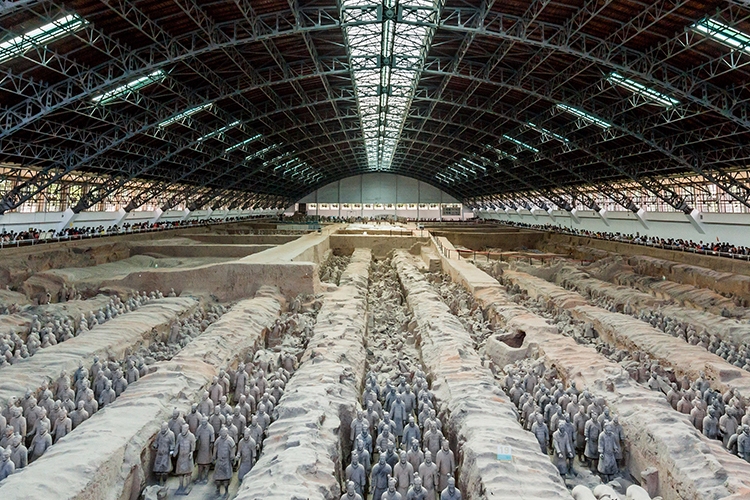
Terracotta Army in Xi'an
The Terracotta Army (officially named Emperor Qin's Mausoleum Site Museum) is a large collection of statues of warriors and horses located in Lintong District, 40 km northeast of Xi’an. There are more than 8,000 terracotta warriors, 130 chariots, 520 horses, and 150 cavalry horses.
Contact us via WeChat
for any inquiry
Scan ChinaTravel QR Code
Most Important Terracotta Army Facts
- Who built It : Emperor Qin Shi Huang
- Why it was built: to protect the emperor and his mausoleum
- How many years to build it: 39 years, between 247 and 208 BC.
- How many warriors are there: about 8000
- Height of soldiers : the height of generals is between 1.8 meters and 1.97 meters (between 5.9 feet and 6.4 feet). The height of a terracotta soldier is around 1.7 meters (5.5 feet).
15 Interesting Facts About the Terracotta Army You Didn't Know
Why and When Was the Terracotta Army Built
The terracotta army was built to protect Emperor Qin Shihuang in his afterlife. The tomb started to build when Qin Shihuang ascended the throne when he was 13 in 247 BC .
The construction of the Emperor Qin Shihuang Tomb lasted 39 years and was completed in 208 BC .
Complete guide of Terracotta Army - Why and When it was Built .
What to See - Exhibit Vaults Inside the Terracotta Army Museum
There are four highlights in the museum, including three pits and the Bronze Chariots and Horses Exhibition Hall . All are about 1.5 km east of the tomb of Emperor Qin. Pit 1 is the biggest and most crowded. Warriors and horses were designed and stationed as if to safeguard the tomb, facing east toward enemies.
The military organization is in accordance with ancient tactics. Every warrior differs in facial expression, clothing, hairstyle, and gestures. The position in which they are standing shows rank and level.
Vault 1 – More than 2,000 Warriors
As the largest and most impressive vault , vault 1 covers an area of 14,260 square meters, 230 meters long from east to west, 62 meters wide from north to south, and 5 meters deep. It’s assumed that vault 1 contains more than 8,000 terracotta warriors and horses, of which only 2,000 have been unearthed.
Vault 2 - The Greatest Variety of Warriors
Covering an area of about 6,000 square meters, warriors in pit 2 are in complex combat formations, consisting of cavalrymen, archers, chariots, horses, infantry, general warriors, standing archers, and kneeling archers. There are over 1,300 terracotta warriors and horses, about 80 chariots, and thousands of bronze weapons . It can be divided into the following four sections.
Vault 3 – A Command Center and the Best-preserved
Vault 3, the smallest, covers only 50 square meters. It’s a command center , consisting of high-ranking officers and a war chariot .
There is one chariot, along with 4 horses and 68 warriors . The battle formation here is different from in the other two pits, with 68 warriors lining the corridor.
Bronze Chariots and Horses Exhibition Hall
There are two large-scale bronze chariots and horses here, discovered in 1980. They were encased in large wooden coffins for over two thousand years, without any corrosion. In October 1983, the exhibition hall was opened for visitors. The Bronze Chariots and Horses are the biggest ancient items of bronze-ware ever found in the world.
What Is the Story Behind the Terracotta Warriors?
There are some popular stories in ancient China about building the grand underground Terracotta Amy for Emperor Qin Shihuang. It is said that he is the first emperor to substitute actual human sacrifices with pottery figures in feudal society, he ordered his subordinates to build a large-scale mausoleum to perfect his afterlife .
The son of Emperor Qin - Qin Ershi was afraid that the artisans would reveal the secrets of the tomb, the workers were buried alive and become funerary objects.
Here are Stories About the First Emperor of China .
How to Make the Terracotta Warriors
The production of terracotta warriors and horses is basically divided into 6 steps . Pottery figurines are made of molds. After the clay sculpture is completed and dry in the shape, carved in detail with ears, mustaches, hair, clothes, and weapons, then fired in a kiln, Glazing, and colored with different pigments.
During the excavation of the Terracotta Warrior figures, archaeologists found there were many names carved on the bodies of pottery figures . Until now, there 85 names have been discovered and recognized. We can distinguish them as Gong Bing, Gong Jiang, etc.
This great discovery proved that the terracotta warriors were made by craftsmen with certain skills, recruited from all over the country. They engraved their names on their works for evaluating the quantity and quality.
Learn 6 Steps to Make Terracotta Army
Popular Terracotta Army Trips
Want to get to know the history of China? Go to Xi'an. Want to get to know about Xi'an? Not miss Terracotta Army! Please see our more popular trips to explore this ancient wonder:
- 4 Days Xi'an Highlights with Mt. Hua Experience Trip -- cycling around Ancient City Wall get views of the sunset, taste local snacks at Muslim Quater, and Walk along the cliffside on the Mt. Huashan
- 2-Day Xi'an Highlights Trip : Experience more of Xi'an — the capital of 13 ancient dynasties — to explore China's ancient culture.
- China Essence Experiences (Beijing, Xi'an, and Shanghai) — Visit China's classic sights in this 8-day tour — our BEST-SELLER.
We have developed some special activities in Xi'an, including discovering a mysterious place to have a close experience with a Terracotta Warrior. Contact us if you want to add these activities to your itinerary.
How to Get to Terracotta Army and Travel Tips
1. Transportations: A. Take direct Bus No. 306 from Xi’an Railway Station (no English-speaking steward on the bus) and get off at the Terracotta Warriors (Bing Ma Yong) stop. The bus runs from 07:00 to 19:00 and it takes about an hour to get to the destination. B. Take Bus No. 307 at the South Gate of the Tang Paradise, Big Wild Goose Pagoda, or Banpo stop and get off at the Terracotta Warriors stop. C. Book Private Xian to Terracotta Warriors Transfers.
2. Suggested visiting time : 2-4 hours
3. To avoid the crowds, you are advised to begin your trip at 08:30 . It’s highly recommended not to visit in July or August , for that is summer vacation and the site will be crowded with students on holiday.
4. You are highly recommended to rent an audio guide if you visit Terracotta Army Museum by yourself, which can help you understand the history. (Rent: CNY 40 per person; deposit: CNY 100)
More Articles about Terracotta Army
- Why the Terracotta Army was Built
- How the Terracotta Warriors Was Made
- 15 Interesting Facts about the Terracotta Army
- Terracotta Army History
Request a custom itinerary today and get one step closer to your personalized trip
Create Your Trip
- Find a Tour
- China Tours
- Student Tours
- MICE Travel
- Destinations
- Virtual Tours
- Terracotta Army Travel Tips & Tours, Xi'an

Terracotta Army
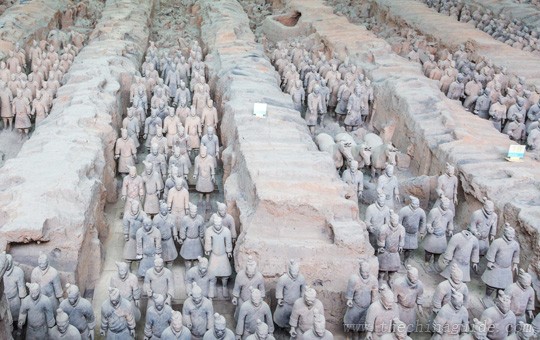
About a one-hour drive outside the ancient capital of Xi'an lies one of China's most impressive claims to fame, the Terracotta Army, also known as the Terracotta Warriors and Horses. This underground, life-size terracotta army was constructed by China's first emperor, Qin Shi Huang, in the 3rd century BCE to serve as his guardians during the afterlife.
The buried army remained undisturbed underground until its accidental discovery in 1974 by a local farmer. Since then, it has become known as one of the most important archaeological finds of the 20th century and has been designated as a UNESCO World Heritage Site. The Terracotta Army, officially named Emperor Qin Shi Huang's Mausoleum Site Museum, is no doubt a must-see for all visitors to Xi'an.
Highlights and Travel Tips
The Qin Emperor's terracotta figures, remarkably well-preserved despite being over 2,000 years old, testify to the power of the man for whom they were molded to protect. This site is a stunning archaeological find of monumental scale, an amazing display that every visitor to China should see. Although the tomb complex itself where the emperor is believed to be interred is largely unexcavated, the thousands of surrounding warriors, horses, and chariots alone are a wonder to behold.
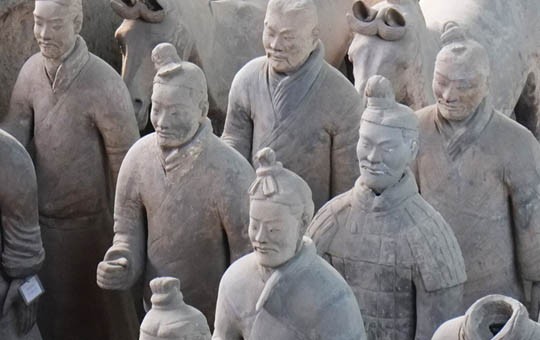
The Museum of Qin Terracotta Warriors and Horses consists of three main pits that are very close to each other. Pit 1 is the largest and composed of several corridors crowded with thousands of imposing, life-sized statues, each with their own individual faces, hairstyles, and uniforms. Northeast of Pit 1 lies Pit 2, which is smaller but contains a variety of figures, including infantry, crossbow team, cavalry, and chariots, that once guarded the emperor's tomb. Northwest of Pit 1 lies Pit 3, which contains the intricately designed statues of higher-ranking officers and a chariot led by four horses.
After passing through the main entrance (remember to keep your ticket, since you will be asked to show them when you entering the pits later), there is a 15-minute walk to the main pits. While there are golf carts to take you there for a small added cost, we suggest you walk since the path winds through a beautiful and shady green park and there are no stairs involved.
Once you arrive at the main pits, we suggest visitors follow this sequence of visiting: Pit 2 - Pit 3 - Pit 1, so that you can save the most massive pit for last. The Terracotta Army Museum is one of the most popular attractions in China, so be prepared for long lines and crowds when visiting, although the lines move quickly. We suggest you go early to avoid the crowds. (Read more tips for avoiding the crowds when traveling in China here .)
Excavation is still undergoing, so while you are visiting, you may see some half-restored figures and ruins with broken parts, as well as workers in the process of restoring statues. A zoom lens is a must if you want to take close-up photos of the warriors in the pits, since you will be kept at some distance from the pits.
All signs have English descriptions, providing some basic information about what you are seeing, but it is advisable to hire a professional guide since the place is large and full of history beyond the basic descriptions provided.
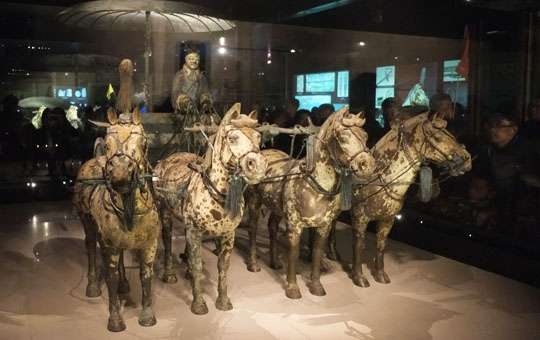
After finishing you visit, there is no tram service back to the parking lot. You have to walk about a kilometer through a commercial area with many restaurants and souvenir shops and stalls. Be careful when buying expensive or valuable things, since some shops could be commission-based.
Accessibility Information
The path from the entrance to the main pits is flat with optional golf cart rides available. Ramps can be found at most places where there are steps. Restrooms are also accessible to wheelchair users. There might be some steps inside the museums but they are manageable with a little help.
Opening Hours and Ticket Prices
Opening hours: 8:30am - 5:00pm (March 16 to November 15) / 8:30am - 4:30pm (November 16 to March 15) Entrance fee: 120 CNY Average time for this activity: 2 hrs
How to Get There
The site of the Terracotta Army Museum is approximately 40 km from Xi'an city center but can easily be reached by bus or car. There is an affordable tourist bus that leaves from Xi'an Railway Station at regular times throughout the day; the bus costs 7 CNY and takes about an hour to reach the museum site. You can also take a taxi from Xi'an for about 150-200 CNY. If you have a tight schedule, then a private car or an organized tour is recommended.
How to Reserve a Ticket Online
The official ticket booking site for the Terracotta Army Museum is: http://order.bmy.com.cn:88/ticket/index.htm . Please note that the online booking system only accepts Chinese ID cards. Passport holders must buy tickets upon arrival at the site of the Terracotta Army Museum.
Explore Further
Around 1.5 km to the west of Terracotta Army Museum lies the Qin Shi Huang's Mausoleum Site Park (Lishan Garden) where the actual tomb of Qin Shi Huang is located. While most visitors skip this park, it is included in your Terracotta Army ticket and can be reached by the free shuttle bus from the Terracotta Army Museum.
This park consists of several smaller pits (filled with civil official figures, bronze birds, stone armor, acrobatic figures, etc.) and the Exhibition Hall of Historical Relics of Emperor Qin Shi Huang's Mausoleum, which showcases some relics excavated from the nearby pits. Be aware that some of the pits are not open to the public. These pits together with the exhibition hall normally take another two hours to visit.
Nearby the Terracotta Army Museum, there are some shops that make and sell replicas of the terracotta warriors as well as other souvenirs. Some shops allow people to mold their own idol-sized clay warriors, which can be an interesting activity for children.
Popular Tours
- Warriors and City Sights - 1-day Xi'an tour
- Xian Silk Road Food Culture - 2-day Xi'an tour
- The Ancient Capitals - 5-day Beijing, Xi'an tour
- Golden Triangle of China - 9-Day Beijing, Xi'an, Shanghai tour
- The Classic China Tour - 13-day Beijing, Xi'an, Guilin, Yangshuo, Shanghai tour
- More Xi'an tours...
Customize a tour that includes a visit to this attraction
Inquiry form.
The Terracotta Army: A Complete Guide with Pictures & Infographics
The Terracotta Army was constructed to accompany the tomb of China's First Emperor as an afterlife guard. There are thousands of detailed life-size terracotta soldier models represent the guard troops of the first emperor — Qin Shihuang. They were molded in parts, fired, then assembled and painted.
The Terracotta Army Museum in Xi'an is a must-see. It is considered one of the greatest archaeological sites in the world , and one of the greatest discoveries of the 20th century. Find out all about the Terracotta Army: facts, how and why they were made, museum location, tours...
Content Preview
Quick facts about terracotta army, what to see inside the terracotta warriors and horses museum, why and how were the terracotta warriors made, how was terracotta army discovered, the history of the terracotta army, terracotta warriors' categories, terracotta army's facial shapes, terracotta army's hairstyles, terracotta army's dressing.
- Did Terracotta Warriors Hold Weapons?
How to Book Terracotta Army Tickets?
- 1-DayXi'an Highlights Tour
- 3-Day Beijing to Xi'an by High-Speed Rail
- Attraction name: The Qin Tomb Terracotta Warriors and Horses
- Chinese: 秦陵兵马俑 Qínlíng Bīngmǎyǒng /chin-ling bing-maa-yong/
- Features: hundreds of life-size terracotta soldiers, horses, and chariots in battle array
- Construction: 246–206 BC. With the tomb of Emperor Qin Shihuang it took 720,000 builders.
- Time needed: half a day
- Suited for: history and Chinese culture enthusiasts
- Physical requirements: indoor sightseeing; wheelchair-accessible lifts and corridors are provided
The museum mainly consists of three vaults and an exhibition hall: Vault One, Vault Two, Vault Three, and The Exhibition Hall of the Bronze Chariots. (Vault one is usually crowded with tourists. According to our experienced guide, the best views are from the front of the vault around the corners . See the Terracotta Army Tourist Map below.)
The vaults are arrayed as the buried army was in strict accordance with the ancient directives on the Art of War: facing east towards the ancient enemies of Qin State (and towards the entrance), with Vault One on the right flank, Vault Two on the left flank, and Vault Three a command post at the rear.
Pit 1 - 2,000 Warriors Displayed
Pit 1 is the largest and most impressive - the size of an airplane hangar. It is believed to contain over 6,000 terracotta figures of soldiers and horses , but less than 2,000 are on display. All the most impressive Terracotta Army pictures were taken in Pit 1.
All soldiers and horses face east in a rectangular array, each one either armed long spear, dragger or halberd. The vanguard appears to be three rows of infantry who stand at the easternmost end of the army. Close behind is the main force of armored soldiers holding weapons, accompanied by 38 horse-driven chariots.
On the southern, northern, and western side there stand one row of figures serving as the army's defense wing. Standing in front of such a grand ancient army array, one would feel the ground shake to the footsteps of the advancing soldiers.
Every figure differs in facial features and expression , clothing, hairstyle, and gestures, providing abundant and detailed artifacts for the study of the military, cultural, and economic history of that period.
This vault opened to visitors in 1979. It measures about 210 meters long and 62 meters wide and the bottom of the pit varies from 4.5 meters to 6.5 meters below ground level. Ten earthen walls were built at intervals of 2.5 meters, forming 9 circling corridors.
Pit 2 - Uncovers the Mystery of the Ancient Army Array
Excavation and restoration is still ongoing at vaults two and three.
Excavated in 1976, Pit 2 stands about 20 meters north to Pit 1. As the highlight of the whole mausoleum, it uncovers the mystery of the ancient army array . It consists of four units, measuring 94 meters east to west and 84 meters south to north and 5 meters deep., forming a 6000 sq. meter built-up area.
The first unit contains rows of kneeling and standing archers; the second one is a chariot war array; the third unit consists of mixed forces with infantry, chariot and trooper standing in rectangular array; and the last one includes numerous troopers holding weapons. The four units form a rigorous battle array.
Pit 3 - Represents the Command Post
Vault Three is the smallest one. There are only 68 terracotta figures, many of which are without heads. It's obvious that Vault Three represents the command post, as all the figures are officials .
The Exhibition of Bronze Chariots
The two bronze carriages displayed in the hall were discovered 20 meters from the west side of the Tomb of Qin Shihuang in December 1980, and were elaborately restored before exhibition.
The carriages have about 3,400 parts each and were driven by four horses. The second one is 3.17meters long and 1.06 meters high. The bronze horses vary from 65 cm to 67 cm high and 120 cm long. Each weighs 1,234 kg in total.
They were mainly made of bronze, but there were 1,720 pieces of golden and silver ornaments, weighting 7 kg, on each carriage. The carriages were so well-made, and so vivid, that they boast being the best-preserved and having the highest rank among the earliest known bronze relics in China. These chariots are the biggest pieces of ancient bronzeware ever found in the world.
First Emperor Qin (/chin/), from whom China gets its name, ordered the creation of this army of terracotta statues.
- 3-Day Essence of Xi'an Tour
- 12-Day When Your Summer Vacation Meets Chinese Culture
How to Make a Terracotta Warrior
You will find that some terracotta figures are without heads, but their bodies are complete. Studies of their portions have revealed that the heads, arms, and torsos of the figures were created separately and then assembled .
It is believed that most warriors' heads and arms were produced in molds as separate modules. After assembly, clay was applied to the surface of the sculptures so that artists could model the faces and hairdos individually.
Then, the figures were fired in kilns to make the clay hard and durable. Afterwards, they were painted with bright colors.
As a result, every figure looks different and unique, just like real people do. After 2,000 years of erosion and humidity, most figures have lost their original vivid color.
The Terracotta Army figures' excavation is regarded as one of the greatest discoveries of the 20th century . It had lain underground for more than 2000 years before farmers digging a well in 1974 uncovered what is now considered one of the greatest archaeological sites in the world.
The first part of the Terracotta Army site to be discovered was named Vault One. In 1976, two other vaults were uncovered about 20 meters away, and were named Vault Two and Vault Three.
The tomb is a treasury for the Chinese people and for the whole world. In December 1987, UNESCO selected the Tomb of the First Emperor (including the Terracotta Army Vaults) as a World Cultural Heritage Site .
- 4-Day Xi'an and Huashan Mountain Tour
- 14-Day China Natural Wonders Discovery
The excavated terracotta figures fall into three major categories : infantry, cavalry, and charioteers.
In the three pits, approximately 8,000 life-size, vivid in battle formation were revealed in the course of excavation - a whole army, which would accompany its emperor into immortality.
The infantry can be further divided into subcategories, including officers of high, middle, and low rank, light-armed and heavy-armed foot soldiers, and standing and kneeling archers.
The charioteers can be further divided into two subcategories: chariot drivers and chariot warriors.
Every figure differs in its facial features and expression, clothing, and hairstyle in accordance with its rank.
Analyses show that the facial shapes of the terracotta figures can be roughly classified into eight types , and each shape resembles a Chinese character: 目, 国, 用, 甲, 田, 由, 申, and 风. For example, '目'-shaped faces look relatively narrow and long, and have small features.
Hairstyles in ancient times were not only part of people's lifestyles but also a reflection of their social status. The hairstyles of the terracotta warriors are different based on their ranks and arm of the services.
The hairstyles of the figures can be roughly divided into two types. The first type includes figures wearing their hair in a bun on the right side of the head. The other type depicts figures wearing their hair in a plait and forming a bun at the top of the head that was then covered with a cloth cap.
Bands, ribbons, or pins were used for typing up their hair.
The clothing of the terracotta figures is different. You can tell the rank and arm of military service of each figure from its dressing. Let us take some figures as examples:
The general wears two layers of robes beneath an armored tunic that protects his chest, back, and shoulders. He wears square-toed shoes, which are lightweight and curve upwards at the front. Only one general was found in Pit 1 and two in Pit 2.
Armored warriors wear robes covered by turtleneck, heavily armored capes designed to protect their chests, backs, and shoulders.
Cavalrymen wear pillbox hats, neck scarves, and light body armor to the front and back. Their shoes are soft and round at the toes so as not to injure their mounts.
Chariot drivers have extra protection for their outstretched arms and hands that need to control the horses'reigns. They wear helmets to protect the back of their necks.
Did Terracotta Warriors Hold Weapons?
Yes . Many of the figures originally held real weapons of the time, such as bronze swords, longbows, arrows, spears, dagger-axes, and other long-shafted weapons. The weapons were treated to make them resistant to rust and corrosion, so that, even after being buried for over 2,000 years, they are still sharp.
The Terracotta Army Museum has carried out real-name ticketing to control tourist traffic. People can book a ticket through its offical website.
According to the epidemic prevention and control requirements, the maximum number of visitors to the Terracotta Army each day is no more than 8,000.
Tickets are in high demand. If you want to visit it, booking in advance is recommended.
We have developed some beyond ordinary activities in Xi'an, including to discover a mysterious place to have a close experience with a Terracotta Warrior. Contact us if you want to add these activities to your itinerary.
- 1-Day Xi'an Highlights Private Tour
- More Xi'an tours
More Popular Terracotta Army Tours
No visit to Xi'an, or even China, is complete if you don't visit the Terracotta Army. See our more popular tours to explore this ancient wonder:
- One-Day Xi'an Highlights Private Tour
- 3-Day Xi'an Tour with Must-see Attractions and Unique Experiences
See more our Xi'an tours or contact us to tailor-make a tour to meet your requirements.
Further Reading
- FAQs About the Terracotta Warriors
- Who Built the Terracotta Army and Why - the First Emperor's Army
- The Original Colors of the Terracotta Army
- How the Terracotta Army Was Made and Its Composition
- How to Get to the Terracotta Army from Xi'an
- How to Visit Terracotta Army )
- 10 Amazing Facts You Probably Don't Know about the Terracotta Army
Get Inspired with Some Popular Itineraries
More travel ideas and inspiration, sign up to our newsletter.
Be the first to receive exciting updates, exclusive promotions, and valuable travel tips from our team of experts.
Why China Highlights
Where can we take you today.
- Southeast Asia
- Japan, South Korea
- India, Nepal, Bhutan, and Sri lanka
- Central Asia
- Middle East
- African Safari
- Travel Agents
- Loyalty & Referral Program
- Privacy Policy
Address: Building 6, Chuangyi Business Park, 70 Qilidian Road, Guilin, Guangxi, 541004, China

Terracotta Warriors and Horses Museum – One of the Eight Wonders in the World
Terracotta Army, aka Terracotta Warriors and Horses Museum, is a complex of thousands of life-sized terracotta statues of soldiers, chariots and horses . An important part of the Mausoleum of Qin Shi Huang , it is the mirror of the real troop of the Qin Dynasty and was constructed to guard Qinshihuang (the first emperor in Chinese history) in his afterlife .
These terracotta sculptures in the pits are so vivid that you may feel they were created by uncanny workmanship. Terracotta Army was listed as a World Cultural Heritage Site by UNESCO in December 1987. It was also praised to be the Eighth Wonder of the World and one of the great discoveries in archaeological history in the 20th century, making it a must-see for any Xian tours .
Quick Facts
- Type: World Cultural Heritage, Historical Site, Specialty Museum
- Period: Qin Dynasty (221-207 BC)
- Time Needed: about 3 hours
- Opening Hours: March 16th–November 15th (Peak Season): 8:30-17:00; November 16th–March 15th the next year (Off Season): 8:30-16:30
- Ticket: RMB 120 per person in low season (Dec. 1 – Feb. 28), CNY150 per person in high season (March 1 – Nov. 30)
- Highlights: the Eighth Wonder of the World; vivid life-size terracotta warriors; exquisite bronze chariots and horses
- Best Seasons : All Seasons
- Commended for: history lovers, Chinese culture lovers
- Location: in Lintong District, Xi’an, Shaanxi Province; about 40 kilometers (24.9 miles) northeast of Xi’an downtown
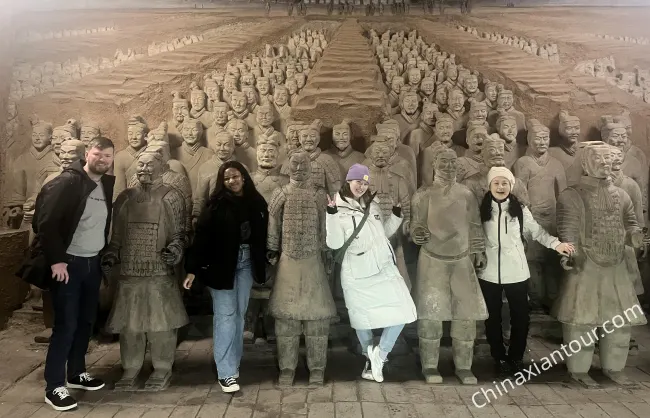
What to See in the Terracotta Warriors and Horses Museum
There are three major pits for the Qin Terracotta Army, covering over 20, 000 square meters (5 acres) in total. Nearly 8,000 pieces of terracotta warriors are unearthed from the three pits, all being the same size of a real man and horse. Meanwhile, the bronze chariots and horses, and Qin weaponry are also very stunning to see. Usually, 3 hours is recommended to explore the four main exhibition areas , which are the Exhibition Hall of the Bronze Chariots, Pit 1, Pit 2, and Pit 3.
- No.1 Pit – the largest of the three pits
In No.1 Pit, apart from the life-size t erracotta w arriors , chariots and horses, bronze swords, hooks, crossbow machines, halberds and so on have also been unearthed . At the east end of this pit, there are 210 terracotta warriors in different facial expressions, dress styles, and hairstyles, lining up in three rows, like the forward force on standby. Behind that, it is the main part composed of 6000 armored terracotta soldiers, holding long weapons such as a spear, dagger-ax, and halberd. They lined up with 35 chariots in a 38 rows. On both north and south sides, there is a row of terracotta guard warriors to prevent the side from being attacked. The warriors and horses in this pit are neat with complete equipment, which are the expressive representation of the mighty army of Qin Shi Huang.
- No.2 Pit – with more kinds of warriors
On the northeast side of the No.1 Pit is the No.2 Pit, 96 meters (105 yards) long from east to west and 84 meters (92 yards) wide from north to south. The layout of the terracotta troop is more complicated and the types of terracotta warriors are more complete, including standing terracotta archers, kneeling terracotta archers, terracotta warriors leading the horses, terracotta infantry, and cavalry. Totally, there are more than 1,300 terracotta warriors and horses, more than 80 chariots, and tens of thousands of bronze weapons in No.2 Pit.
- No.3 Pit – the smallest, constitutes command post
No.3 Pit is 25 meters (27 yards) from the west end of No.1 Pit, with an area of about 520 square meters (622 square yards). It’s the smallest out of the three pits, but it hadn’t been completed. There is a chariot in front of the door with 68 terracotta soldiers inside. Judging from the layout, No.3 Pit seems to be the general headquarters, commanding the whole army.
- Bronze C hariots and H orse s E xhibition H all
If you want to see more about the chariots and horses, the Exhibition Hall next to No.2 Pit will feast your eyes. You can witness the bronze chariots, bronze horses, and various Qin weapons in a close distance.
In December 1980, archaeologists excavated two large painted bronze chariots with horses on the west side of the Mausoleum of Emperor Qin Shi Huang. This is an earlier discovery of the large and well-preserved bronze chariots. There are four horses driving in front of each chariot, and a terracotta figurine that drives the chariot. The chariots and horses were lifelike and beautifully decorated, and a large number of gold and silver items were used as ornaments and components. They are known as the Best of Bronzes.
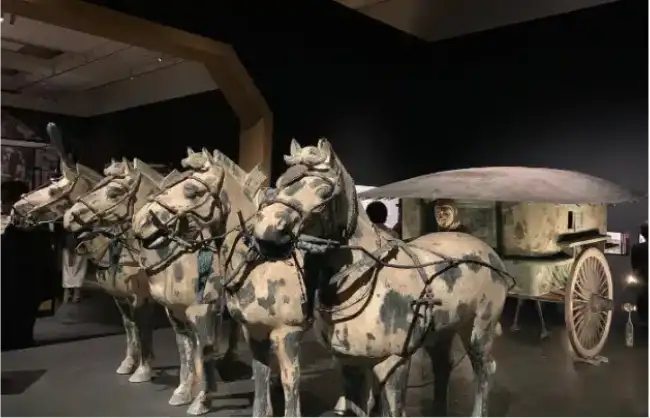
How Many Terracotta Warriors are There? How Tall are They?
As of 2007, there are over 8,000 terracotta warriors have been unearthed from the tomb of the first Qin emperor, together with 130 chariots with 520 horses, and 150 cavalry horses, represesting the armies of Qinshihuang. All the warriors are in life-size, vary in height, hairstyle, and facial features. Generally, most warriors are 180-190 cm in height, the highest ones can reach to 200 cm. But, these height data are measured with their base at the foot and hairdressings included. The net heights of these warriors are similar to the modern people, ranging from 170 cm to 180 cm.
Recommended Xian Tours including the Terracotta Warriors and Horses:
For most people who travel in Xian , no matter the duration of their planned trip, visiting the Terracotta Warriors and Horses Museum should top their Xian tour bucket list. Below are 5 of our most recommended Xian Tours with the Terracotta Warriors and Horses :
- 3 Days Xi’an Private Trip: History Exploration & Tang Costume Experience
- 4 Days Xian Classic Tour with Mt. Huashan
- 7 Days Xian In-depth Culture Tour
Interesting Facts about Terracotta Warriors and Horses
- The construction lasted for 39 years
The Mausoleum of Emperor Qin Shi Huang, including the terracotta warriors and horses, had been constructed for around 39 years since the he took the throne of the Qin State when he was 13 years old. More than 100,000 people were recruited from various places for the construction. To the unification of China and even his death, it hadn’t been completed. It was forced to stop in 208 BC because of the peasants’ uprising.
- I t was once damaged at the end of the Qin Dynasty
At the end of the Qin Dynasty, it was wartime with endless battles and uprisings. In that period, the terracotta army was buried after being flooded. There are some traces in the pits to prove what it suffered. Xiang Yu, the leader of one most powerful forces, was suspected of setting the fire. He captured the capital of the Qin Dynasty and fired the Epang Palace. But some scholars think it isn’t him who did that.
- E ach terracotta soldier is not the same
Each of the terracotta warriors and horses is unique. In particular, every terracotta warrior has a unique face with different facial features. How amazing it is! Thus, the terracotta army was doubted to be made with real men; but it’s not true. The incredible workmanship deserves its great honor and reputation.
- T he T erracotta W arriors and H orses used to be colored
Do you know the terracotta warriors and horses turned out to be colorful? It is reported that the terracotta warriors and horses were in bright colors when they were made. However, due to the fires, floods, and natural erosions underground in the about 2,200 years, more than 95% of them have fallen off. Some colorful ones lost their colors only a few minutes after being unearthed and exposed to air. The technologies during the excavation time could not solve this problem, which is one of the reasons why the Mausoleum of Emperor Qin Shi Huang has not been excavated on a large scale.
- T here is a No.4 Pit
A few people know that there is also a No.4 Pit between No.2 and No.3 Pits. However, there is no terracotta warrior or horse but the backfilled soil. It is supposed that this is because the construction was forced to shut down for the turmoil of uprisings and wars.
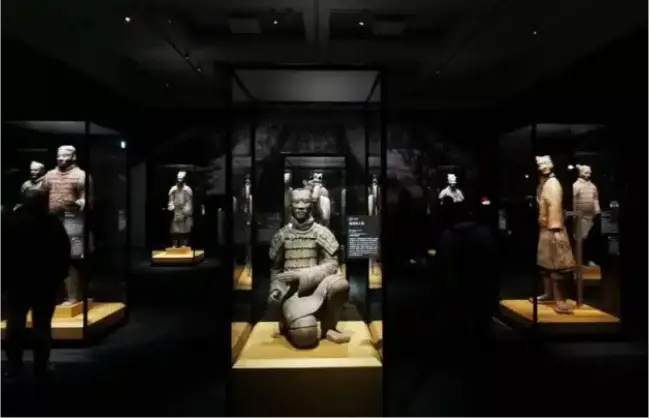
History of the Terracotta Army
When were the Terracotta Warriors made?
This underground army was designed to guard the mausoleum of China’s first emperor – Qin Shi Huang, who unified China in 221 BC. According to archaeological data, these warriors were made from 246 BC to 208 BC, and the construction of the mausoleum involved over 700,000 conscripted workers, and lasted for about 40 years.
Why the Terracotta Army was made?
The terracotta soldiers were related to the change and development of the burial rites in ancient times. In slave society, the rulers wished to live a luxurious life after their death in another world as much as they enjoyed during their lifetime, so sacrificial offerings and some other articles for use were buried for the dead. Burying a lot of living slaves was also in great vogue among the royal families and lords. In the Spring and Autumn Period (770-476 BC), the living slaves were replaced by the terracotta figures gradually. Later in the middle and late Warring States Period (about 475-221 BC), terracotta figures came to be rife for the burial objects.
The Terracotta Warriors and Horses is not only a component part of the Qin burial system but reflects an aspect of the Qin culture as well. Such a Terracotta Army showed the power and strength of the country at that time.
How the Terracotta Warriors were made?
Of course, these warriors are not made of real people. The material for the making of terracotta warriors and horses was the yellow soil and white quartzite gravel taken from the northern foothills of the Lishan Mountain. After sieving and washing, something impure was removed and the soil was then ground into fine granules. After mixing up with a suitable amount of water and yellow earth, it was churned and pounded into a mold-clay of neither soft nor hard. Then molding was the main step in the making process. The makers and sculptors combined molding and sculpting together, made them part by part, and then fixed them up into a whole piece. Afterward, they were put into the kiln to be fired and painted when taken out of the kiln. With regard to the minute parts of the terracotta figures, methods like sculpting, molding, kneading, patching, carving, painting, and so on were used in turning them out.
To make the terracotta warriors morn stable for better safekeeping, the lower parts of the figures were made solid and heavier while the upper parts hollowed and lighter. For instance, the feet and legs of terracotta figures were made solid with the belly and arms hollowed. The terracotta horses were made in the same way. Particularly, every figure was made on a square board so that the space contact with the ground was widened; thereby the center of gravity as well as the figure was more stable.
Establishment of the Museum
To protect and preserve these rare relics, the Terracotta Warriors and Horses Museum was built on the very site of the No. 1 Pit as approved by the State Council in 1975. The museum was brought to completion in 1979 and opened to visitors on October 1st the same year.
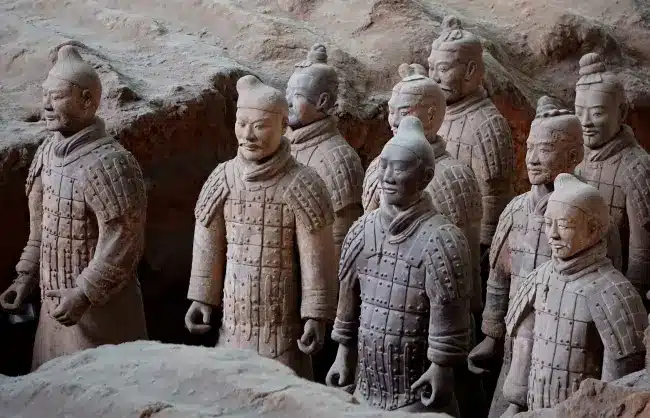
When and How Were the Terracotta Warriors and Horses Discovered?
In March 1974, a farmer of the Xiyang Village, Yanzhai Township, Lintong District dug a well in the south of the village, and several broken terracotta warriors in life-size were found. After the excavation by the Shaanxi Provincial Archaeological Team, the terracotta warriors and horses have reappeared. This is how the No. I Pit was discovered. Later in 1976, No. 2 and 3 Pits were excavated one after another.
How to get to Terracotta Army ?
- Metro Line 1 + Metro Line 9 + Lintong Tourist Bus 613
From Xi’an downtown, you can take the Metro Line 1 first to the terminal Fangzhicheng Station, then transfer to Metro Line 9 to get off at Huaqingchi (Huaqing Palace) Station. Coming out from the Exit C and walking forward, you’ll the bus stop to transfer to Lintong Tourist Bus 613, which will take you to the Terracotta Army.
- Metro Line 1 + Tourist Bus Line 5/Bus 306
Take Xi’an Metro Line 1 to Fangzhicheng Station. Come out from the Exit B, walk north for a few distance to the Fangzhicheng Bus Station. You can find the getting-on spot of Tourist Bus Line 5 or Bus 306 in front of the bus station, which will take you to the Terracotta Army directly.
- Airport Bus Lintong Line + Tourist Bus Line 5/Bus 306/Bus 307
From Xi’an Xiyang International Airport, you can find the bus Lintong Line at T3 Terminal. Take the bus and get off at the Lintong Campus of Xi’an University of Science and Technology. Then transfer to Tourist Bus Line 5/Bus 306/Bus 307 to the destination.
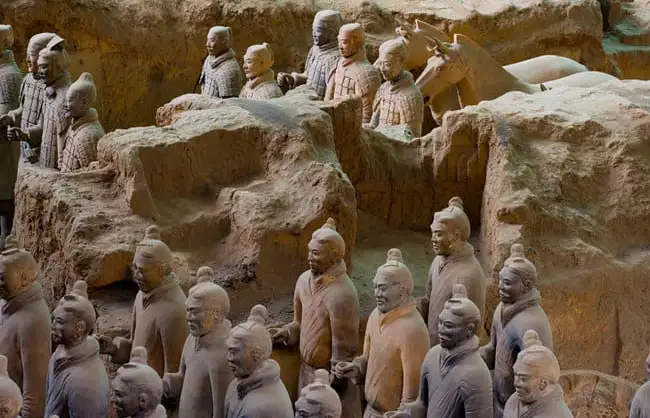
Terracotta Warriors and Horses Visiting Tips
- The guide service in Chinese, English or Japanese are available with an extra expense.
- To protect these relics, don’t touch them. No flash when you take pictures.
- You cannot step into the pits. Remember to take a telescope or telephoto lens for your camera to watch the Terracotta Warriors and Horses more clearly.
- At the entrance of the site, there are sometimes enthusiastic people who will lead a wrong way for you. These men are the frauds, and you would be instructed to take the so-called shuttle bus to a false “terracotta warriors and horses pit”. Stay away from these persons and ignore them.
- In the East Square of Xi’an Railway Station or near the Fangzhicheng Bus Station, there are some fake Tourist Bus Line 5. The staffs of the real buses wear uniforms with armbands, and you need to line up in front of a sign to board the bus.
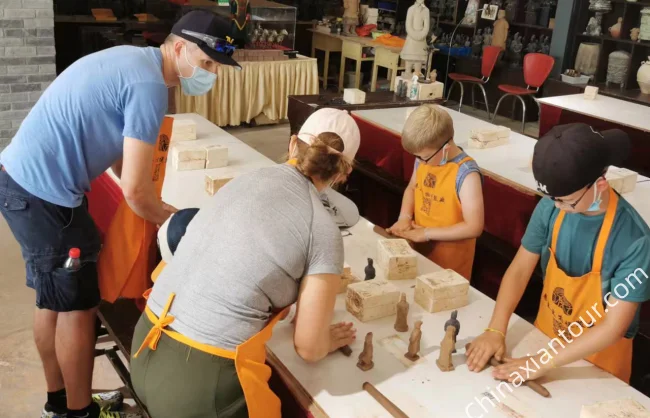
More Tours including Terracotta Warriors and Horses:
- 2 Days Xian Terracotta Warriors Exploration Tour
- 1 Day Beijing Xian Tour by Flight
- 2 Days Shanghai Xian Tour by Air
Find more related Xian Terracotta Warriors Tours .
Popular China Tours including Xian:
- 10 Days Great China Tour of Beijing-Xian-Guilin-Shanghai
- 8 Days Beijing – Xian – Shanghai Highlights Tour
Related Reading:
- Best Time to Visit Terracotta Warriors
- Why The Terracotta Warriors Have Single-edge Eyelid
- Master of Terracotta Warriors and Horses May Not be Qin Shihuang?
Destinations
Popular tours, travel blog.
Top 15 Things to Do in China 2024/2025 11/10/2022 07:53
Chinese Zodiac 04/14/2022 09:29
Why Visit Dunhuang and Top Things to Do in Dunhuang 03/29/2022 09:33
We are member of:
Email: [email protected] [email protected] WeChat/Whatsapp: 86-15129005119 Call: (+86)18792910029 (08:00-21:00 Beijing Time)
2002-2022 © All Rights Reserved.
Username or email *
Send us a quick inquiry
* Tell us your travel requirements/questions here.
I prefer to be contacted via:
Email WeChat WhatsApp Phone call
Your travel consultant will reply within 24 hours.
A TripAdvisor award-winning China travel agency organizing diverse private and mini-group China tours. We offer in-depth experience, free cancellation, flexible & safe trips.
[email protected] [email protected]
WeChat/Whatsapp
86-15129005119
(+86)18792910029 (08:00-21:00 Beijing Time)
How to Visit Terracotta Warriors | Plan Visit to Terracotta Warriors
Few sights on Earth can rival the grandeur and historical significance of China's Terracotta Warriors . Discovered by chance in 1974, this remarkable army of life-sized clay soldiers has become a symbol of China's rich cultural heritage and the centerpiece of one of its most famous archaeological sites.
If you're planning to visit the Terracotta Warriors , Our Visitor’s Useful Guide is designed to provide you with comprehensive and valuable insights and practical tips. Whether it's choosing the best time to visit , how to get from Xian , and how to visit the various pits and exhibits , we've got you covered.
Together, we'll delve into the heart of ancient China and unearth the secrets of the Terracotta Warriors. Let's get started!
Terracotta Warriors Brief Facts
Chinese Name: 兵马俑 (Bīng Mǎ Yǒng)
English Translation: Terracotta Army, Terracotta Warriors and Horses
Features: Thousands of life-size terracotta soldiers, horses, and chariots in battle array
Type: World Heritage Site, Historical Site, Museum, Cultural Landmark
History: Constructed in 246–206 BC, discovered in 1974
Construction Purpose: To accompany and protect the first emperor of China - Qin Shi Huang in the afterlife
Opening hours: Peak Season (March 16 to November 15): 08:30-17:00\ Low Season (November 16 to March 5): 08:30-16:30
Location: Emperor Qin Shihuang's Terracotta Army Museum, 25 miles (40 km) northeast of Xian
Time needed: Half Day
Suited to: History and Chinese culture enthusiasts
Physical requirements: Indoor sightseeing, moderate walking, wheelchair accessibility available.
Content Preview
Best Time to Visit Terracotta Warriors & How to Avoid Crowds
The Terracotta Warriors is an indoor attraction , making it accessible year-round without being affected by weather conditions. However, the Terracotta Warriors Museum is one of the must-see attractions in China, and its popularity among tourists can lead to crowding, especially during peak travel seasons.
Choosing Right Season for Your Visit
Peak tourist season in Xian typically falls during the national holidays, namely the Spring Festival (Chinese New Year), which usually occurs in late January or early February, Labor Day Holiday from May 1st to 3rd, and the National Day holiday in the first week of October. The summer vacation , from June to August, is another peak period.
The best time to visit the Terracotta Warriors tends to be during the shoulder seasons, which fall from March to May and from September to early November . During these periods, the weather in Xian is comfortably mild, and the site is less crowded than in peak season. Visiting during the off-peak winter season can also be an excellent time for those who prefer a quieter experience.
Choosing Right Timing for Your Visit
The Terracotta Warriors site generally opens at 8:30 AM and closes at 5:00 PM . As most tour groups tend to arrive mid-morning, planning your visit for right when the site opens can help you beat the crowds. If you're not an early bird, another option is to visit around noon , when most tour groups left for a lunch break. Regardless of when you decide to visit, keep in mind, you'll need to manage your time well to ensure you can fully explore the site before closing time.
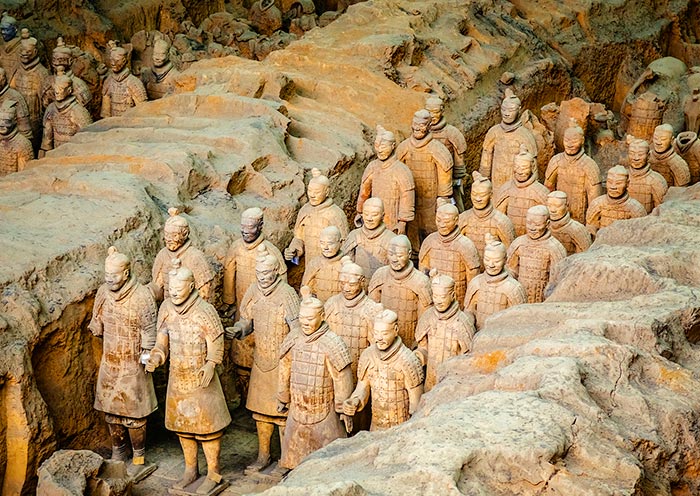
3 Days Xian Essence Tour: Terracotta Warriors, City Wall & Tang Dynasty Everbright City Xian Highlights Day Tour: Terracotta Warriors, City Wall, Muslim Quarter
How to Get to Terracotta Warriors
The Terracotta Warriors is situated in the Lintong District of Xian City, Shaanxi Province.
By Public Transport - The Most Economical Way but May Be Crowded
One of the most economical ways to reach the Terracotta Warriors Museum is by taking the public bus from Xian. It's worth noting that these buses can be quite crowded, especially during peak tourist seasons.
By Organized Tour - The Most Convenient Option
Taking an organized tour is the most convenient option. A guide and driver will pick you up directly from your hotel or train station, or airport and escort you to the Terracotta Warriors. Wit our private tour, you'll enjoy personalized service, the comfort of private transportation, and the advantage of a knowledgeable guide who can offer valuable insights about the site.
How to Book Terracotta Warriors Tickets
To visit the Terracotta Warriors, it's essential to book your tickets in advance due to the museum's maximum daily capacity of 65,000 people. Once this limit is reached, ticket sales will be stopped for the day.
The E mperor Qinshihuang's Mausoleum Site Museum (秦始皇帝陵博物院) has implemented a real-name reservation system. This means that all visitors (including those who are entitled to policy-free tickets and visitors from Hong Kong, Macao, Taiwan, and foreign countries) must book their tickets under their real names. Booking can be done through the official website or the WeChat public account of the museum.
It's recommended to book your tickets well in advance, especially during peak tourist seasons, to ensure you won't miss this incredible historical site. Alternatively, you might consider attending a guided tour for a more enriching and hassle-free experience. Tours typically include the reservation process in their service, allowing you to focus on the incredible history and legacy of the Terracotta Warriors.
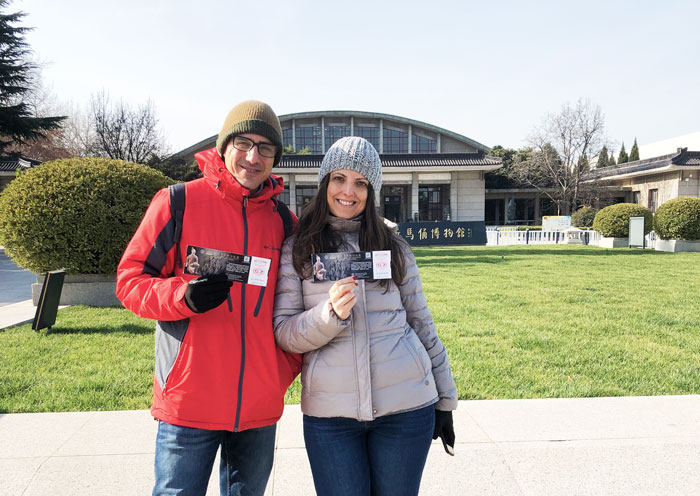
How to Visit Terracotta Warriors
Emperor qinshihuang's mausoleum site museum layout.
The Emperor Qinshihuang's Mausoleum Site Museum is composed of the Terracotta Warriors and Horses Museum and th e Emperor Qinshihuang's Mausoleum Archaeological Park (Lishan Garden) .
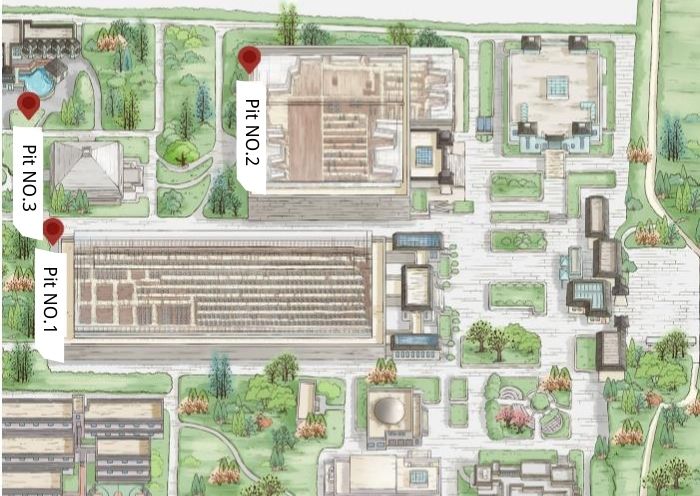

Terracotta Warriors and Horses Museum Layout
The T erracotta Warriors and Horses Museum , which houses the main pits containing the warriors, is divided into three sections: Pit 1, Pit 2, and Pit 3 .
Pit 1: The largest and most impressive of the three pits, Pit 1, houses the main army formation, with over 6,000 figures (2,000 are currently on display). The pit covers an area of approximately 14,260 square meters, equivalent to the size of an airplane hangar.
Pit 2: This pit is notable for its complex layout and variety of military figures, including standing and kneeling archers, cavalry, charioteers, and infantry. Despite being smaller than Pit 1, Pit 2 offers a richer diversity of the army, providing further insights into ancient military strategy and the mysteries of the army array.
Pit 3: Known as the command center, Pit 3 is the smallest but considered the most important pit due to its perceived role as the army's "headquarters."
Our Recommended Visiting Route: Pit 1 – Pit 3 – Pit 2 - Exhibition Hall
Begin with Pit 1 as it's the largest and most stunning, offering a grand first impression. Spend ample time here observing the soldiers' intricate details and formations. Next, move on to Pit 3, where you will see the army's "headquarters." Then, proceed to Pit 2, where you will encounter a more diverse array of military figures. Finally, conclude your visit at the Exhibition Hall, where you can marvel at the history of the Terracotta Warriors and Horses.
Suggested Visiting Time: 2-3 hours
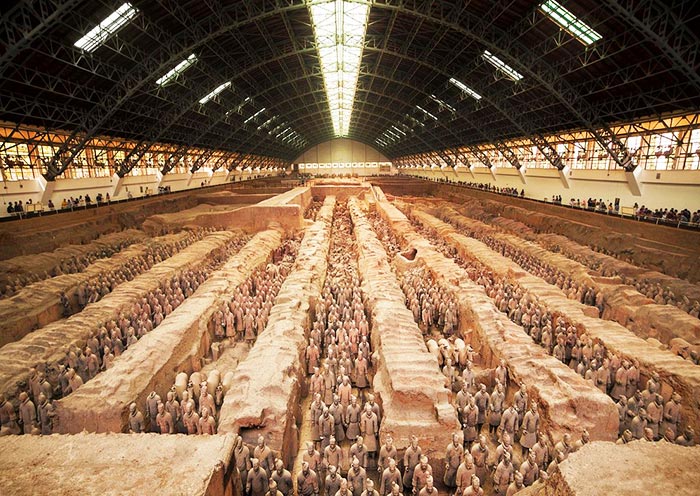
Emperor Qinshihuang's Mausoleum Archaeological Park Layout
The Mausoleum Site Park of the First Qin Emperor , also known as Lishan Garden , is an archaeological park situated on the core area of the First Qin Emperor's mausoleum.
Visiting the Lishan Garden primarily involves seeing the Mausoleum of Emperor Qin Shi Huang , the relics in the burial pit site 9901 (the Hundred Plays figurines pit), the burial pit site 0006 (the Civil Official figurines pit), and the Bronze Chariots Museum.
Suggested Visiting Time: 1-1.5 hours
For history buffs, exploring both the Terracotta Warriors and Horses Museum and Emperor Qinshihuang's Mausoleum Archaeological Park provides a comprehensive understanding of Emperor Qinshihuang's historical significance and the scale of his burial complex. If you have sufficient time and interest, you can visit both sites. These two locations are approximately 2200 meters apart, and free shuttle buses are available for convenient transportation between the two sites.
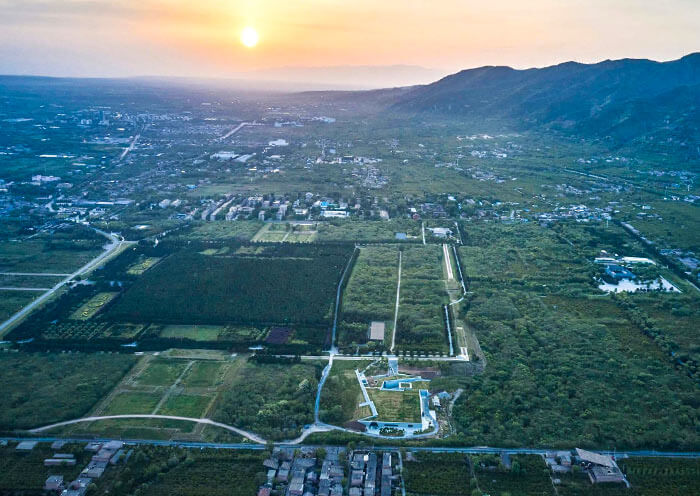
1 Day Xian Cultural Tour with Terracotta, Family Visit & Calligraphy 2 Days Xi’an Historical Tour: Terracotta Warriors & Hanyangling 3 Days Xian Family Tour with Chinese Calligraphy & Hanfu Experience 4 Days Xian World Heritage Tour with Culture Experiences 4 Days Xian Panorama Tour with Mount Huashan Hiking
Travel Tips for Visiting Terracotta Warriors
1. Book the Entrance Ticket In Advance:
Given the daily limit of 65,000 entrance tickets, it's essential to secure your entrance ticket in advance to ensure your visit to this world-renowned site.
2. Plan Your Visit:
A typical visit to the Terracotta Warriors can take 2-3 hours. Spend time researching and planning in advance to make sure you get to see all the aspects of the site that interest you.
3. Consider Hiring a Guide:
Hiring a guide can significantly enhance your visit. Guides can offer valuable insights into the history and significance of the site and answer any questions you may have.
4. Arrive Early or Late:
The Terracotta Warriors site can get quite crowded, especially during peak tourist season. To avoid large crowds, consider arriving as soon as the museum opens or in the late afternoon when most tour groups have left.
5. Beware of Scams:
Upon your arrival at the parking lot outside the Terracotta Warriors, you may be approached by local villagers claiming to sell souvenirs or offering to guide you to the "real" Terracotta Army. It is recommended to ignore these offers as the items sold are often fake and overpriced.
6. Wear Comfortable Shoes:
As the site is expansive, expect a considerable amount of walking. Wearing comfortable shoes will help you explore the site with ease.
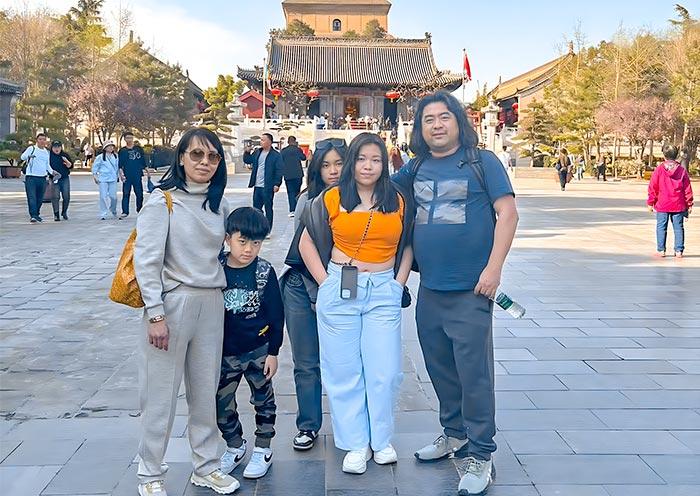
3 Days Xian Essence Tour: Terracotta Warriors, City Wall & Tang Dynasty Everbright City Xian Highlights Day Tour: Terracotta Warriors, City Wall, Muslim Quarter 2 Days Xi'an Historical Tour: Terracotta Warriors and Hanyangling Museums
Nearby Attractions Around Terracotta Warriors
Aside from the Terracotta Warriors, there are several other nearby attractions that you could consider including in your itinerary.
Huaqing Pool and Lishan:
Huaqing Pool, also known as Huaqing Hot Springs , is just 10 kilometers east of the Terracotta Warriors. This historic site was a popular royal retreat for Chinese emperors throughout history, famous for its natural hot springs. The site is particularly known for the romantic legend of Emperor Xuanzong and his concubine, Yang Guifei . Dating back to the Tang Dynasty, the Huaqing Pool offers a serene environment adorned with traditional pavilions, corridors, and towers, set against the beautiful backdrop of Lishan Mountain. Lishan Mountain offers a relatively easy climb. From its summit, you'll be able to look over the structures below, providing a breathtaking view of the surrounding area.
The Song of Everlasting Sorrow:
"The Song of Everlasting Sorrow " is a grand outdoor performance held at the base of Lishan Mountain, near Huaqing Pool. This spectacle of lights, music, and dance tells the heartbreaking love story of Emperor Xuanzong and his concubine Yang Guifei, which has been passed down in Chinese literature and folklore. The show uses the natural landscape and modern technology to create an unforgettable spectacle. The stage settings include a real water stage, a dry stage, and a sky stage, making the performance a magnificent and immersive experience. The stunning visuals, coupled with the poignant tale, make this show a highly recommended cultural experience.
In-depth History And Culture Exploration Route:
This route is perfect for history buffs, culture seekers, and explorers who desire to delve deep into the stories and traditions that have shaped China over thousands of years.
In the morning, depart from the city center and head to Lintong to visit the Emperor Qinshihuang's Mausoleum Site Museum and Lishan Garden . Experience the artistic allure of the Terracotta Warriors, where each figure has a unique face. In the afternoon, you can visit Huaqing Palace to see the Begonia Soup Pool where Yang Guifei once bathed, and then ascend Lishan Mountain to take in the view of Lintong. If your time allows, watching the live performance of " The Song of Everlasting Sorrow" at Huaqing Pool in the evening is also a wonderful experience.
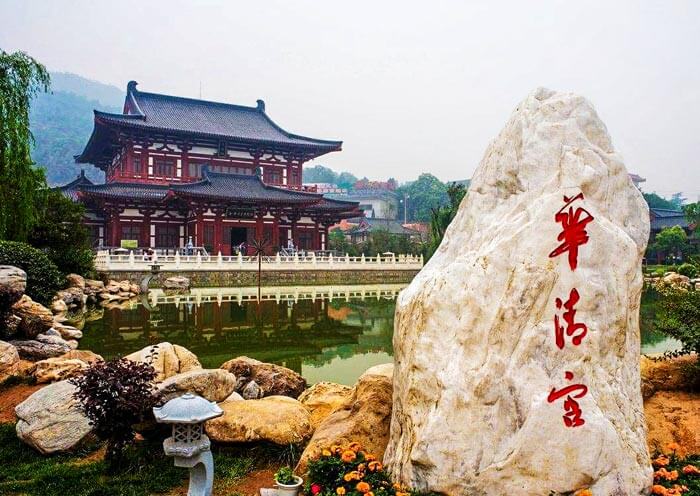
Explore Terracotta Warriors with Asia Odyssey Travel
For a complete, immersive experience of the Terracotta Warriors , touring with a reputable travel agency like Asia Odyssey Travel can be an excellent choice. Asia Odyssey Travel offers guided tours that not only take care of the reservation process but also provide you with knowledgeable guides to enlighten you about the historical and cultural significance of this unique archaeological site.
If you're looking to extend your stay in Xian into a longer vacation, Asia Odyssey Travel also offers a range of inspiring ideas through our China tours from Xian . Our professional travel consultants are ready to assist you in customizing a tailor-made Xian Tour at the best local price.
Book your tour today and prepare to be awed by the grandeur and splendor of the Terracotta Warriors.
If you have any questions about this article, please contact us by submitting the following form and we'll immediately get back to you.
Ask Us for More Information
Recommended Related Trips

Visitor's Guide to the Terracotta Warriors Museum in Xi'an
:max_bytes(150000):strip_icc():format(webp)/EBC_pose-591232dc5f9b586470fb3268.jpg)
Emperor Qinshihuang's Mausoleum Site Museum
Emperor qin's army.
It has been said that going to China and missing seeing the Terracotta Army is like going to Egypt and missing the Pyramids . Viewing Emperor Qin Shi Huang's terracotta army guarding his burial site and protecting his entry to the afterlife from the earthen side of a continuing archeological project is certainly one of the most memorable parts of any trip to China. The site was made a UNESCO World Cultural Heritage Site in 1987.
A visit to the terracotta army is made from Xi'an (pronounced She-ahn), the capital of Shaanxi province. Xi'an lies to the southwest of Beijing . It is approximately a one-hour flight, or an overnight train ride from Beijing, and is easy to add on if you are already visiting Beijing. Xi'an is China's first historic capital, made a primary city by the first emperor, Qin Shi Huang.
The Qin Shi Huang Terracotta Warriors and Horses Museum is located about thirty to forty-five minutes outside Xi'an by car.
The story goes that the terracotta army itself was discovered in 1974 when some farmers were digging a well. Their shoveling began the unearthing of a huge burial pit belonging to the tomb of Emperor Qin Shi Huang, the founding Qin Dynasty emperor who unified China into a central state and also laid the foundation for the Great Wall .
It is estimated that the tomb took 38 years to build, between 247 BC and 208 BC, and utilized the labor of over 700,000 conscripts. The emperor died in 210 BC.
The museum site is divided into three parts where one can view the three pits where ongoing reconstruction of the army is taking place.
- After paying at the entrance, you will watch a 360-degree movie about the site and how the army was discovered.
- You'll then visit the sheds that house Pits 1-3 (named in order of discovery). Pit 1 is the largest and has had the most restoration done. It is here you can see the columns of soldiers followed by war chariots. Carry on to Pits 2 and 3.
- There will also be plenty of shopping opportunities built in. If you missed picking up your replica of the terracotta warriors in any of the markets you saw them in from Shanghai to Kashgar, then now's your chance to get them from their original location.
Getting There
- Most visitors go on group or private tours. Group tours can be booked out of your hotel or even made from other cities, such as Beijing, or in your home country. Private Tours can be booked in the same way but will cost more. However, private tours will give you the luxury of taking your time.
- On your own, you can take Bus #306 from the parking lot just east of the Xi'an train station. Ask your hotel for directions.
- Opening hours: 8:00am to 6:00pm
- Recommended time for visit: three hours
- Guide or Self-Guide?: if you're visiting on your own, you can hire a guide outside the gates of the museum. You'll be approached by English-speaking guides and asked if you want their services. Negotiate and agree on the price up-front. The nice thing about having a guide is that they are good at navigating the crowds and always know the best spot for a photo. But hiring is really up to you. You can visit the museum without a guide very easily.
Tips for Visiting
- Don't buy your copies of the terracotta warriors on the way in! You'll have to lug them around, so buy them on the way out. There will be hawkers willing to make you a good deal.
- You can buy books about the history and discovery of the terracotta army in the museum bookstore. Usually one of the "farmers" who was digging the well on that fateful day in 1974 is there signing books. (He's probably not really one of the original farmers. Maybe a cousin? Maybe from the same village?)
- Websites quote it is not possible to take photos but we had no trouble during our visit. Just remember not to use the flash.
Asia's 12 Most Amazing Holy Temples and Sacred Pilgrimage Sites
Top UK Destinations for Stone Circles and Ancient Sites
Viking River Cruises - China Land Tour and Yangtze River Cruise
Pyramid of Djoser, Egypt: The Complete Guide
Great Activities for Kids Visiting China
Westminster Abbey
A Short History of Hangzhou
How to Visit Saqqara, Egypt: The Complete Guide
Top UNESCO World Heritage Sites in Southeast Asia
Your Trip to Shanghai: The Complete Guide
Essential Ancient Sites to Visit in Rome
Dordogne Travel Guide and Maps
14 Famous Forts and Palaces in India that You Must See
Jaipur's Amber Fort: The Complete Guide
Beijing Guide: Planning Your Trip
Herculaneum: The Complete Guide

Flying Fluskey
Sharing our travel stories to inspire yours, your guide to visiting the terracotta warriors of xian.
The Terracotta Warriors of Xian are one of the most important sights in China , and possibly the most important archaeological discovery of the 20th century. So if you are staying in Xian , how do you go about visiting? This handy guide is everything you need to know about visiting the Terracotta Warriors of Xian.
Staying in Xian for a couple of days? Check out our Xian itinerary HERE!
A Little Terracotta Army History
Visiting the terracotta army, what to see in the terracotta army site, information for visiting for the terracotta warriors, final thoughts on visiting the terracotta warriors, how was the terracotta army discovered.
The spring of 1974 was a hard one. A drought was parching the land and an order came through to dig wells. Farmers in a small village near Xi’an began doing just that but after digging down a small way, they struck something hard. Chunks of clay, formed into faces, arms, arrowheads emerged from the ground. They realised that this could be something special and reported it. Slowly archaeologists started to uncover the site and as clay soldiers emerged one after the other, they realised that it was going to be vast.
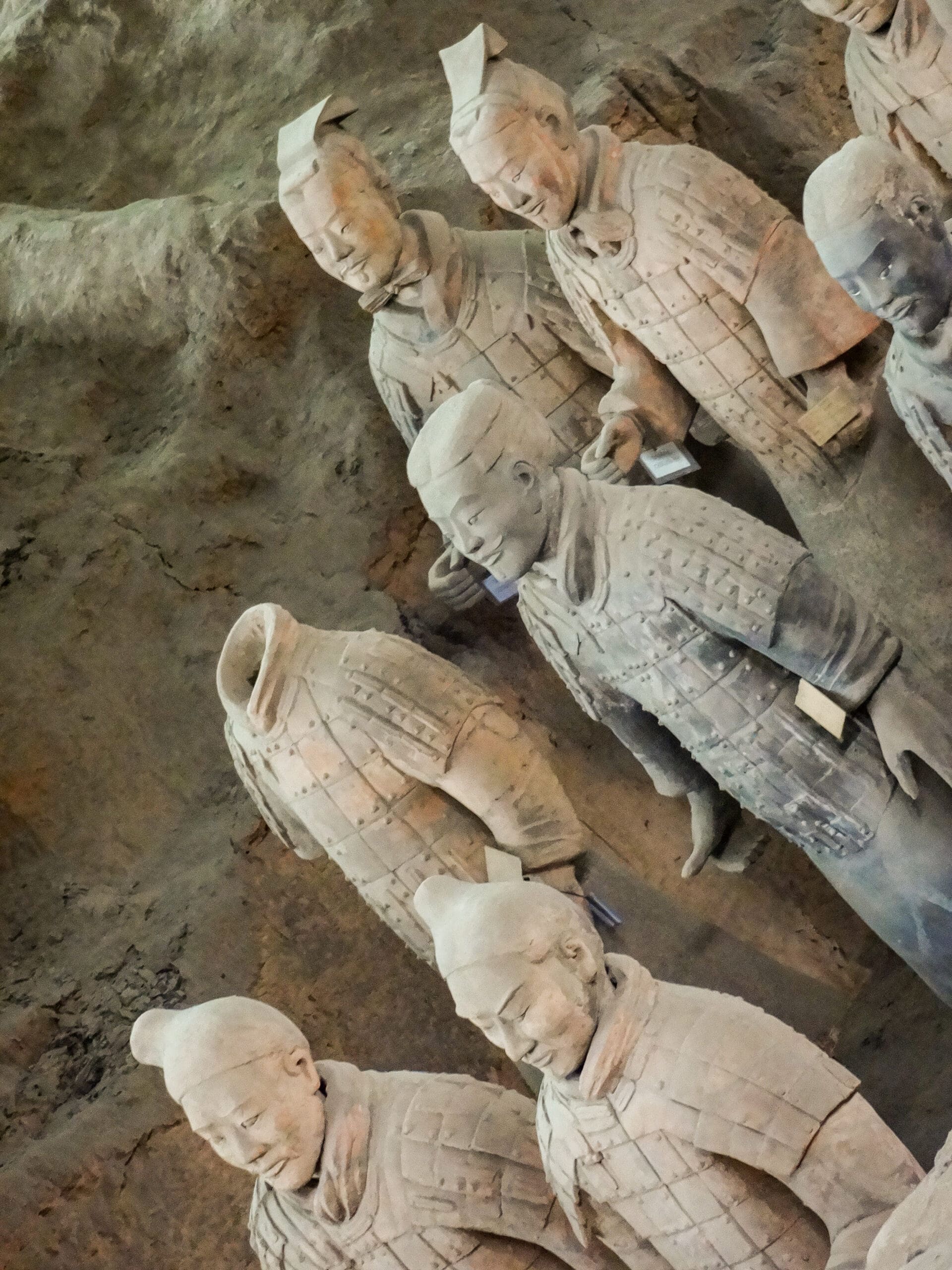
Qin Shi Huang’s Dream
A mile away from this new site, the burial compound of Qin Shi Huang was known to exist. Qin Shi Huang was the first ruler to unify the disparate kingdoms of the landmass we now call China. (It wasn’t a peaceful series of coups, there was considerable bloodshed). Qin Shi Huang became the first emperor of China and he really wanted it to stay that way.
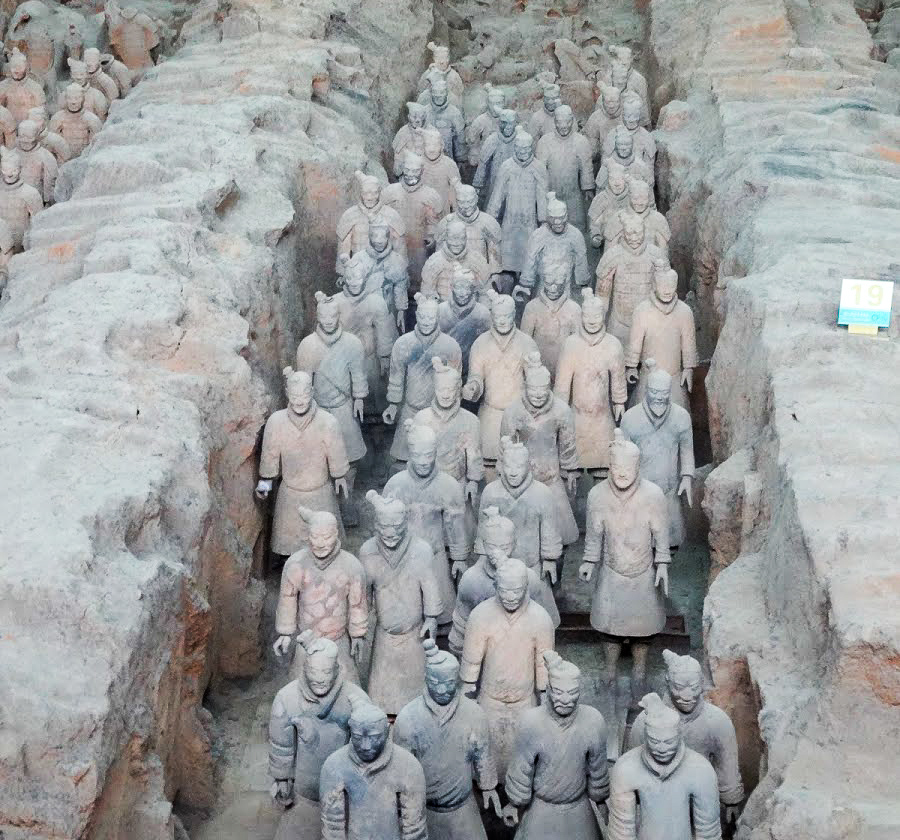
Qin Shi Huang loved being emperor so much that he decided he was going to live forever. However, just to be on the safe side, he created a huge complex full of things he would need to rule in the afterlife. Prior to this, concubines, servants and family members may have been buried alive along with the dead ruler. The clay facsimiles of an army changed all that. Subsequent emperors had these armies made too…but in miniature.
We know that there is a vast underground palace complex, complete with river and lakes, but it cannot be excavated. That is partly because archaeologists don’t want to expose it to the ravages of air, and partly because to stop the water in those rivers and lake from draining away, they filled them with mercury! Infact, it was the mercury Qin Shi Huang was given for his health that finally did him in.
Sadly, his concubines were never transformed into terracotta figures so they still suffered their grizzly fate.
Most people have seen the famous pictures of rows of warriors, shoulder to shoulder. but it can’t prepare you to see it in the flesh…so to speak. Throughout the site, not only do they expect to find over 8000 soldiers, but over 500 horses and over 100 chariots.
As you explore the site, try to remember that these statues, date back over 2000 years. Work began in 246 BC when the 13 year old Qin Shi Huang took the throne and work continued solidly for 36 years.

This was the first area to be excavated and it is the biggest yet discovered. Over 1000 warriors stand in neat rows. On entering you are face to face to with them. The figures face away from the burial ground in order to protect it which is why they are all looking directly at you.

The walkway is raised so you look down upon them. World leaders and often invited down to get up close and personal but us mere mortals are guided around the high-level gangway.
Most soldiers stand at around 6 foot (1.8m) and each of these grey figures is totally unique. Some faces hold a slight smirk, whilst others scowl. Eyes, hairstyles, noses and ears are all individual. There is a mix of uniform combinations and their different size hands are gripping a variety of long eroded wooden weapons. As you pass around the site, you will notice plenty of soldiers missing heads and/or hands. These were modelled separately and so detach more easily. The figures, although now a ghostly grey, were once painted in bright colours; blue, green, red and black. There is also evidence that some had leather armour on but this has also disappeared with time.
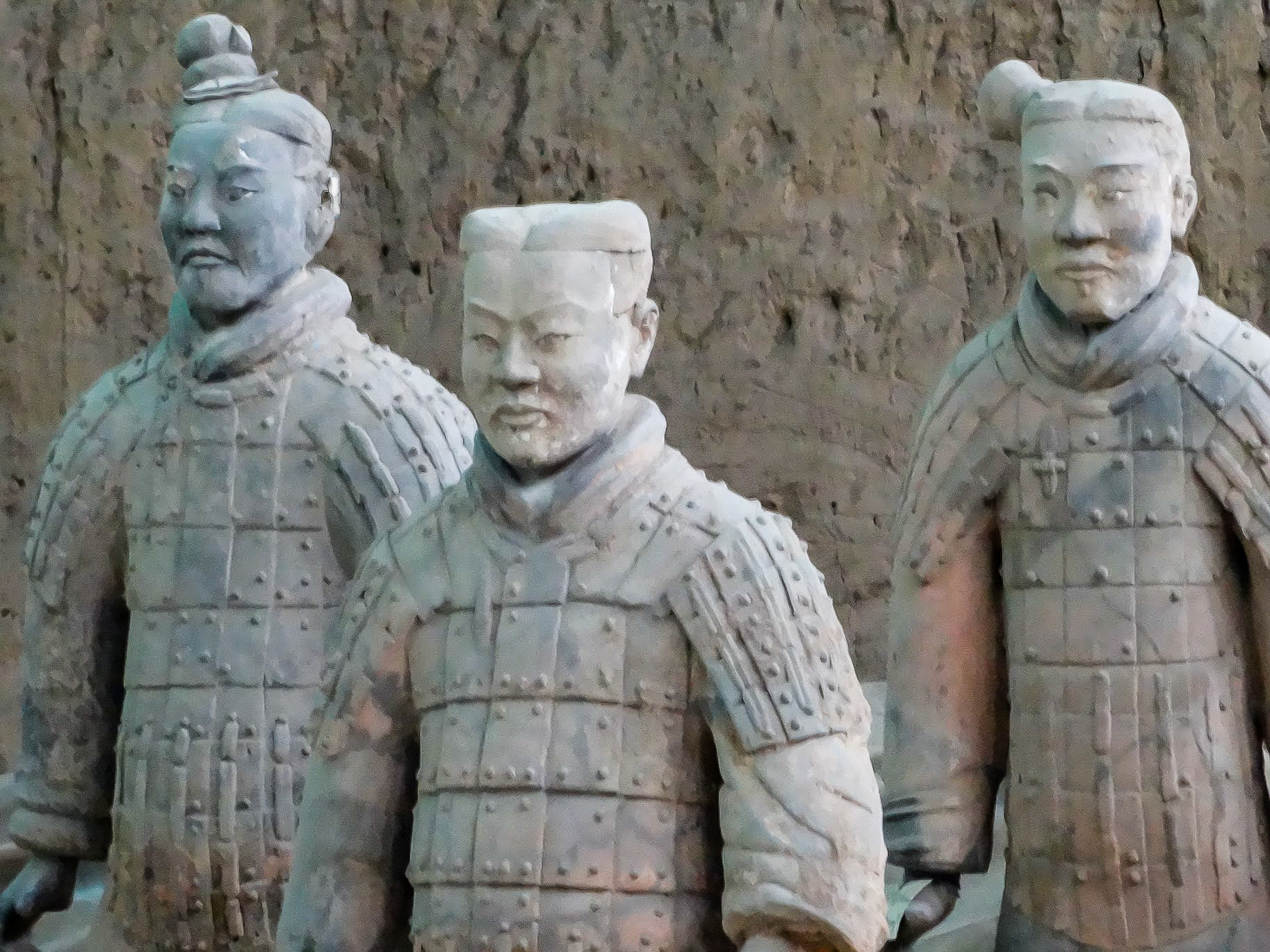
In one corner, archaeologists are still excavating, studying and reconstructing new soldier figures.

Pit Two holds a variety of forces. The four depicted are archers, calvary with their horses, charioteers and more infantry (as seen in pit one). This variety makes it the most interesting of the three. Although it is smaller at the moment, it is thought it is actually bigger than Pit One, with more figures in it so come back in 50 years and check out the progress!
Along the side, you will see four special figures behind glass. These are unusual figures in both their detail and their stances.
The General is a large chap, standing at 2m and wears special feathers in his cap. These represent those of a special kind of partridge known for its aggression. They fight to the death!
The cavalrymen , leading his horse is interesting as Qin Shi Huang was one of the first major rulers in this area of the world to appreciate the flexibility of horseback warfare. Horses can go where chariots cannot so he massively increased his calvary.
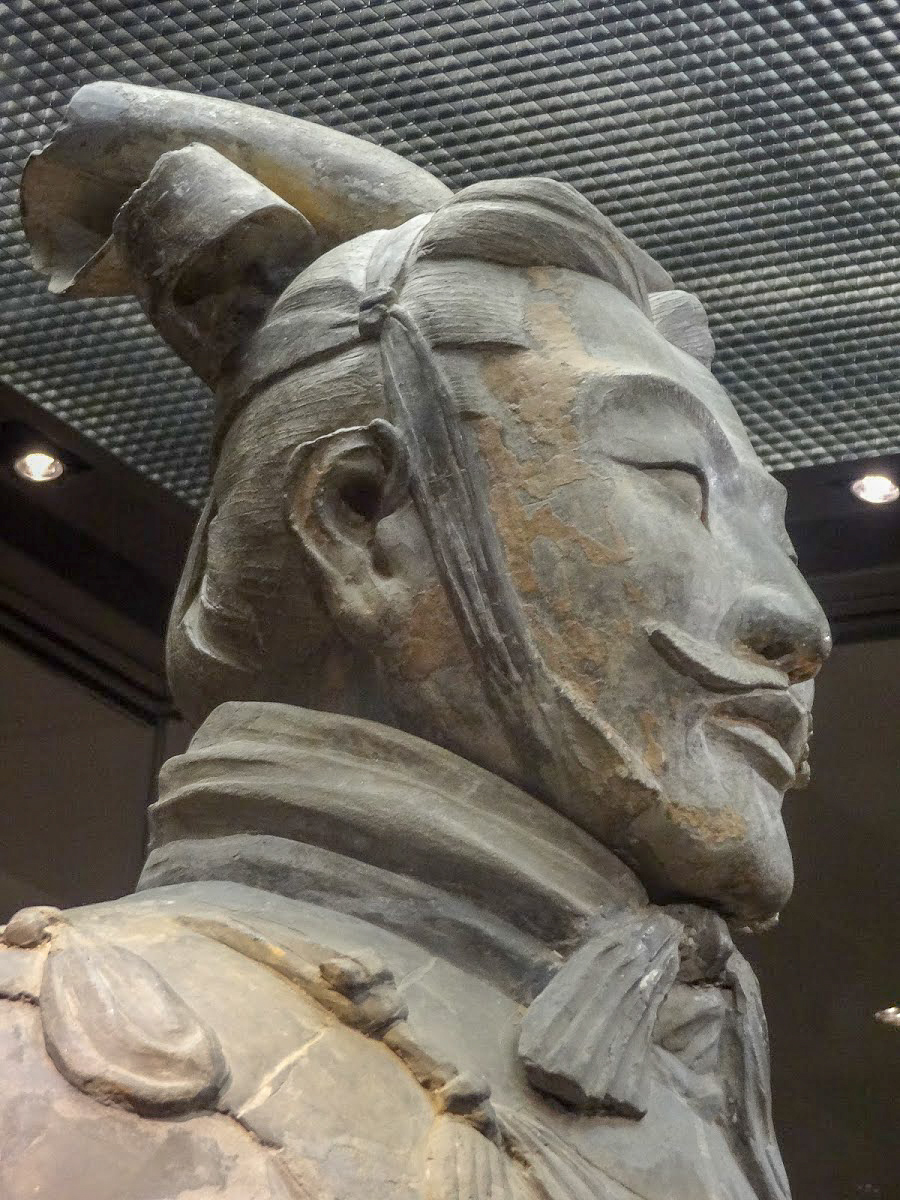
The smallest of the three pits, the statues here represent a command post. It is set behind the largest section of army and tucked to the side of the other. This indicates that it too is being protected by the foot soldiers.
The soldiers and horses below were once part of an ornate wooden chariot that has sadly deteriorated to the point that only soil testing reveals its secrets.
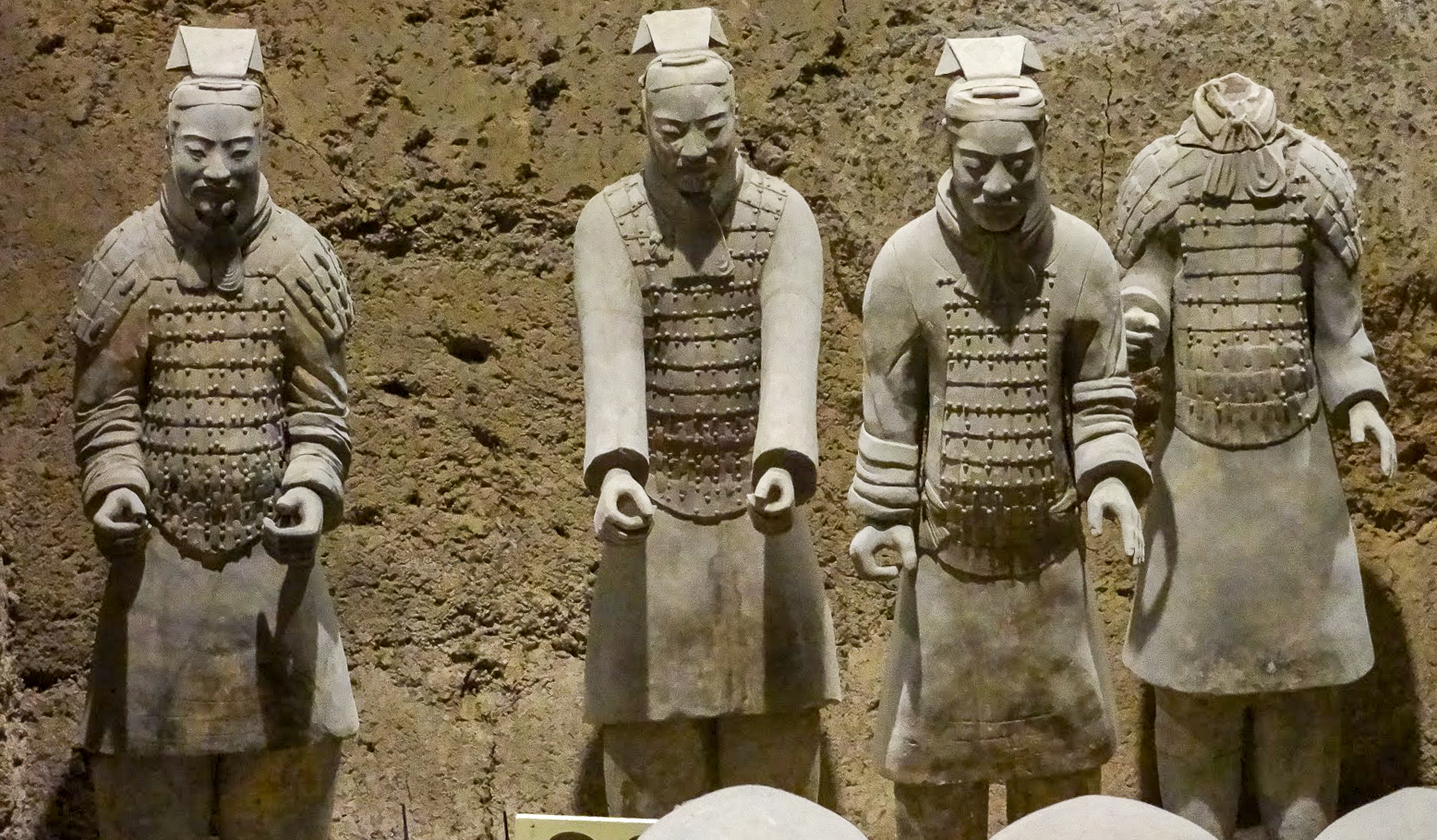
Exhibition of Bronze Chariots and Horses
In this dedicated exhibition hall, you will find the two stunning bronze chariots that have been discovered so far. Made from bronze, lead and decorated with gold and silver, they would have been super shiny when first made. Both are pulled by gorgeous horses (sadly, our photos were too blurry but at least we won’t spoil the surprise for you). One chariot is enclosed and has a kneeling driver. The other (below) has a coachman sitting under a large parasol.
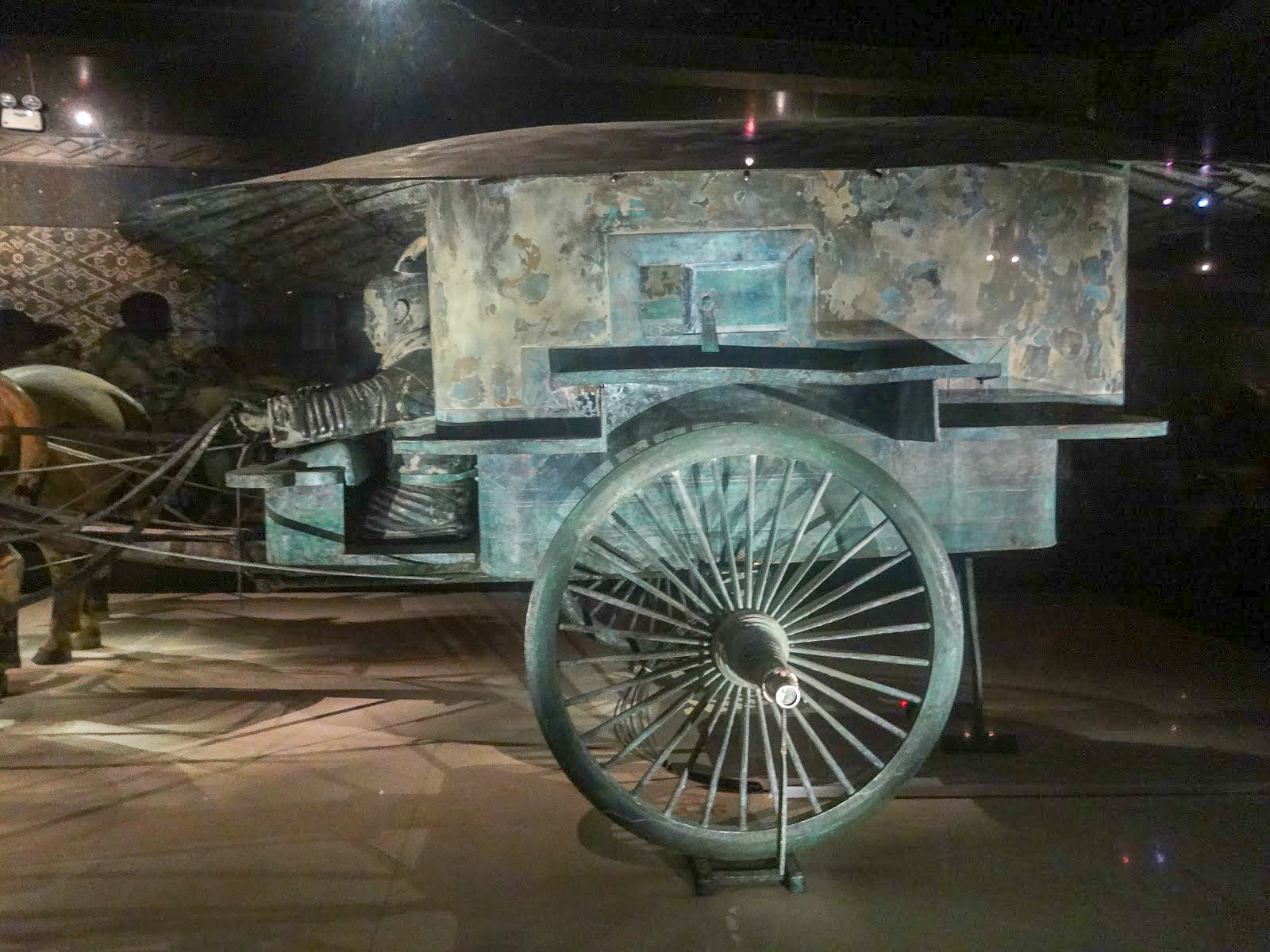
Qin Shi Huang Mausoleum
A short, free bus ride away there isn’t a great deal to see here. It cannot be excavated (remember all that mercury) but there are two pits to see. One contains civil servants (those faceless cogs in the government machine) whilst the other is more an entertainment pit. They have discovered musicians and acrobats in this one.
Getting to the Terracotta Warriors by Bus
Get yourself to Xian’s main train station and hunt out the green bus 306 from the east square. The journey takes around an hour and costs just 7RMB We did this and it was incredibly easy.
Getting to the Terracotta Warriors by Taxi
You can hire a taxi from Xi’an for the whole day but this is quite an expensive option if you are solo or in the couple. The advantage is that you can plan an itinerary to suit you perfectly. Bargain a price for the whole day including the waiting time rather than just for each journey.
Joining a Terracotta Warrior Tour
If you are really interested in learning about the warriors we recommend booking on to a Terracotta Warrior Tour . Think carefully about what kind of tour you require. Do you want:
- A guide to take you around and explain it all?
- To see any additional sights en route?
- Food included?
- A morning, afternoon or all-day tour?
The advantage of finding a tour that includes a guide rather than hiring one at the entrance is the chance to read reviews ahead of time. If you want to learn all about the history of the Emporer but they are interested in the building of the structure around the pit, it would be good to learn that before you book!
Opening Times
Opening times don’t vary all that much throughout the year. The site just closes slightly earlier in the coldest time of the year.
- Mid- March to Mid-November – 08:30 – 18:00
- Mid-November to Mid- March – 08:30 – 17:30
Try to time your visit first thing in the morning or over lunch if you can as it will be ever so slightly less busy.
If you are not a Chinese citizen you have two options for buying your tickets:
- Buy it on the door – You can go to the counter or use the self-service machines. (You will need your passport for ID)
- Book ahead with a travel agent – Pick someone reputable like ChinaDiscovery.com
The tickets will cost you:
- 120RMB – December to February
- 150RMB – March to November
Entering The Terracotta Army Site
Depending on where you arrive, you could be up to 1km away from the entrance. There are golf buggies ferrying tourists but you will need to queue for these and pay 5RMB each way It is only a 15 minute walk.

Pass across the large square surrounded by gift shops and restaurants and round to right until you come to the entrance proper. The souvenirs in these shops are overpriced and books signed by the farmers that “discovered the warriors” are of “questionable origin”. The restaurants are pretty average so why not just head to the KFC, at least you won’t be paying above the odds and you know what you’re getting.
You need to decide how to discover the site. You can either:
- Hire an audioguide – This costs ¥40 but you’ll need another ¥200 for a deposit. The guide is a little dull and rather limited.
- Hire a guide at the entrance – There are plenty of English speaking guides available and thy charge a variable rate, but usually, it is around ¥150. Chat to a few to find out if you like them.
- Stick with the guide included in your tour .

This ever-evolving, ever-increasing archaeological dig is the most astonishing sight in China. Beating out the Forbidden City in our opinion, we could spend hours getting in and around the statues (if we were allowed). If you are planning a trip to China you must make the journey to Xian and see it for yourself. You will not regret visiting the Terracotta Warriors!
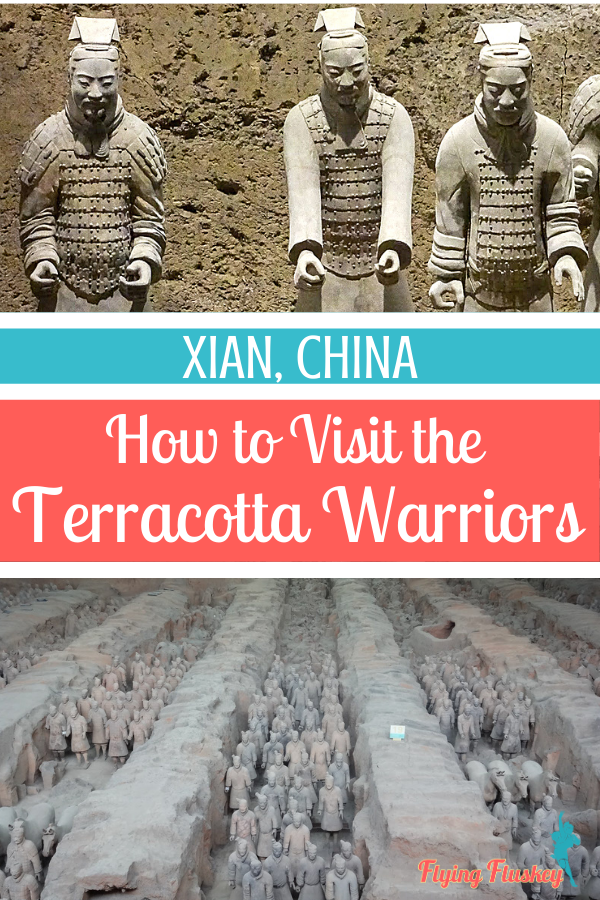
2 thoughts on “ Your Guide to Visiting the Terracotta Warriors of Xian ”
Great info! Is there a place to store luggage at the museum?
Leave Us A Comment Cancel reply
To respond on your own website, enter the URL of your response which should contain a link to this post's permalink URL. Your response will then appear (possibly after moderation) on this page. Want to update or remove your response? Update or delete your post and re-enter your post's URL again. ( Learn More )
Privacy Overview
- Travel Guides Plan your adventure
- Destinations Our favourite places
- Tours Book a trip
- Travel Companies Independent specialists
- Travel Guides
- Destinations
- Travel Companies
How to see the Terracotta Warriors at Xi'an
Visiting the terracotta army and beyond in xi'an.
Megan Eaves
- In this guide
The Terracotta Warriors
- A brief history
How to visit the Terracotta Warrior Army
- What else to see in Xi’an
- Alternative historical sights
As the ancient end of the Silk Road and one of China’s historical capitals, Xi’an is a mesmerising mix of history, architecture, culture and food. Travellers come to see the Terracotta Warriors, which were unearthed just outside of town in 1974, but are often surprised at how large and cosmopolitan the city is.
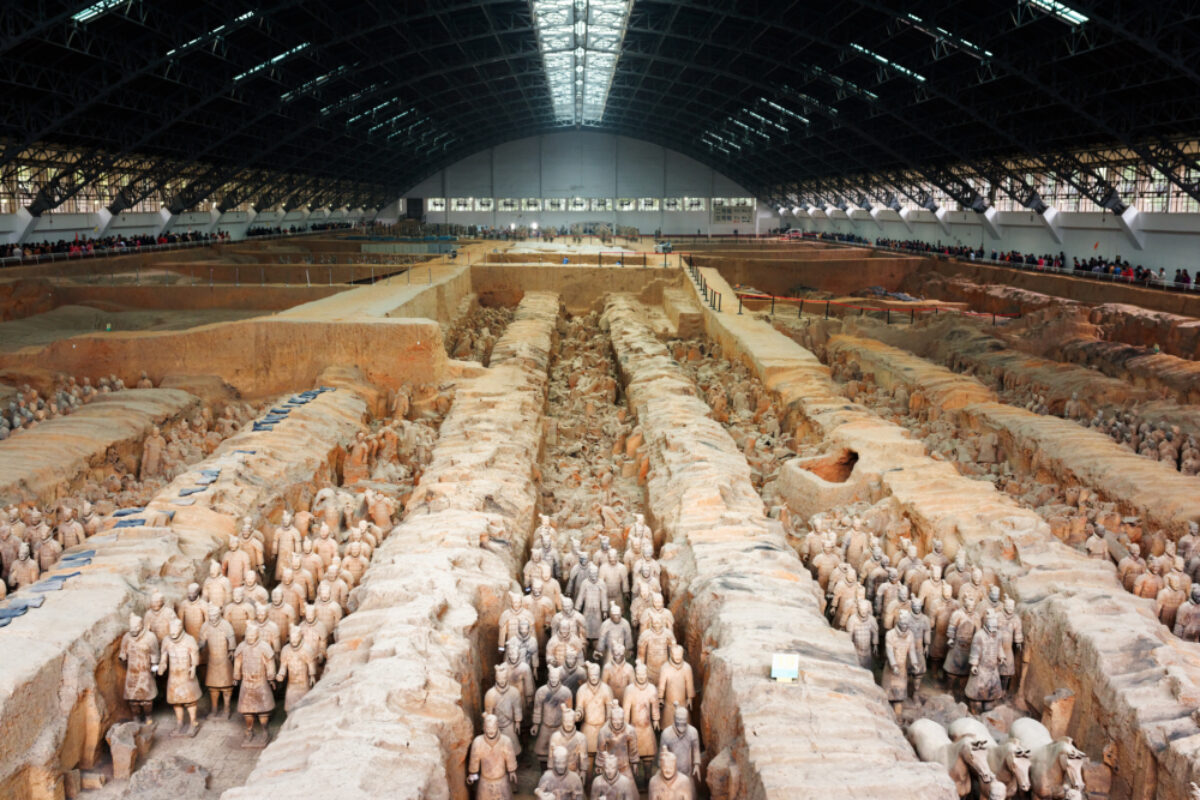
Terracotta Warrior Army: a brief history
One of the most astonishing archaeological sites in the world, the Terracotta Warrior Army is a massive collection of fired-clay soldiers, chariots and horses. The army was commissioned by China’s first emperor, Qinshihuang, at the end of the third century BC. He was to be buried with the army as protection in the afterlife.
The Terracotta Warrior site was discovered by local farmers in 1974. The farmers were drilling a well not far from the known tomb of the Qin Emperor at nearby Mount Li. They’d dug about a metre down into the ground when they encountered pottery figures and arrowheads. The site was excavated and eventually, a terracotta army of 8,000 figures, all standing in battle formation, were revealed.
In 1976, two additional pits of soldiers were uncovered, and the site opened as a museum and tourist attraction in 1979. Unesco declared the Terracotta Warrior Army a World Heritage Site in 1987 and work continues to expand the site and protect the archaeology today.
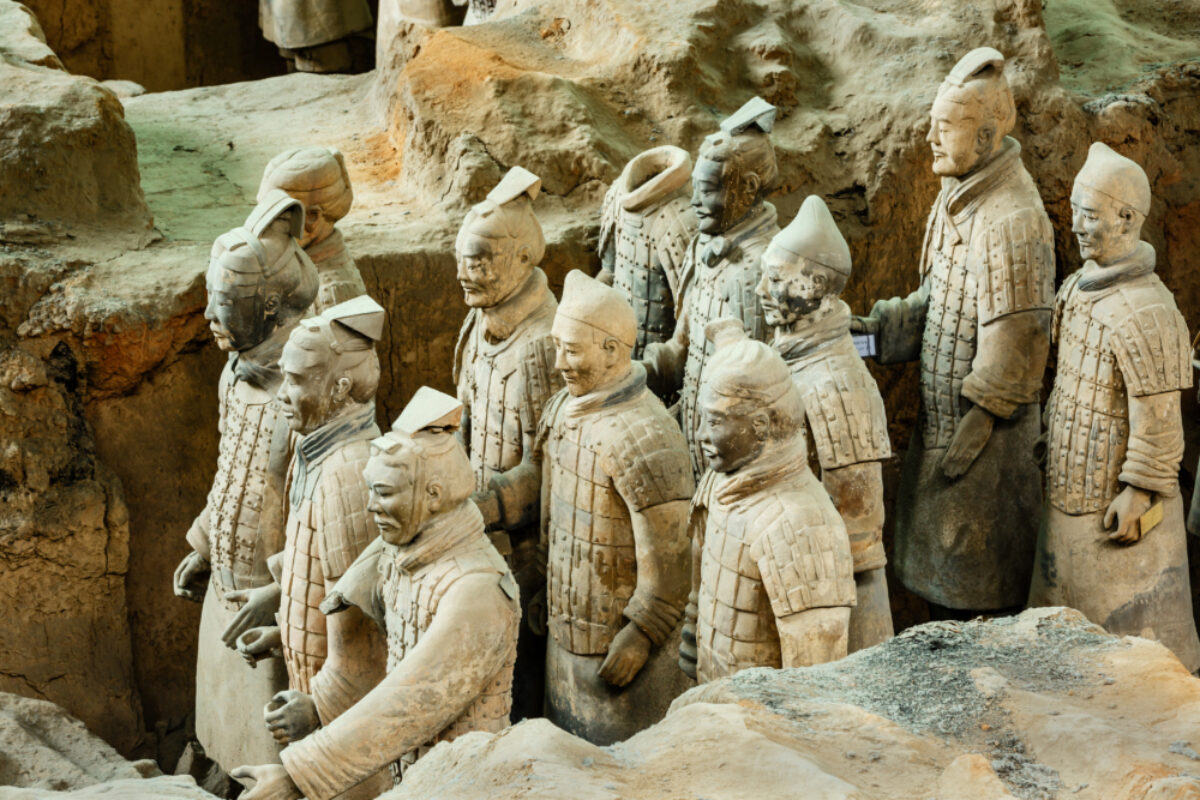
What strikes you most when visiting the Terracotta Army is its sheer scale. The sculptures, which are all life-size or bigger, have been excavated where they were buried and still stand in perfect rows. There are three excavation pits, the largest of which is protected by a vast warehouse the size of an aeroplane hangar. A walkway leads around the edges, allowing for close-up viewing, where it becomes clear that each horse and soldier has a unique facial expression, hairstyle and clothing. The best viewing points are at the corners of Pit 1 (the largest pit), where you are able to get as close as possible to the warriors and take in the expanse and scale of the site.
An onsite exhibition hall showcases bronze chariots and a few of the most interesting sculptures and allows for closer inspection of the figures’ lifelike features, as well as the incredible detail put into the horses and chariots.
Visitors to the Terracotta Warrior Army need at least 3-4 hours to see the entire site, including the exhibition hall. A day trip will often incorporate a morning visit to the Terracotta Warriors with an afternoon at the Huaqing Hot Springs, a geothermal hot spring and palace used by Tang emperors and featuring in Bai Juyi's poem Song of Everlasting Regret. The Huaqing Palace was also the site of the 1936 ‘Xi’an Incident’ , when Kuomintang political leader Chiang Kai-shek was kidnapped during the Chinese civil war.
The Terracotta Warrior Army site is located about 50km from the centre of Xi’an. Many visitors opt to take a guided tour of the site, which offers in-depth insights about the culture, history and archaeology of the site. There are also city buses that run from Xi’an Railway Station to the site, taking about an hour, and official tour guides can be hired at the ticket windows.
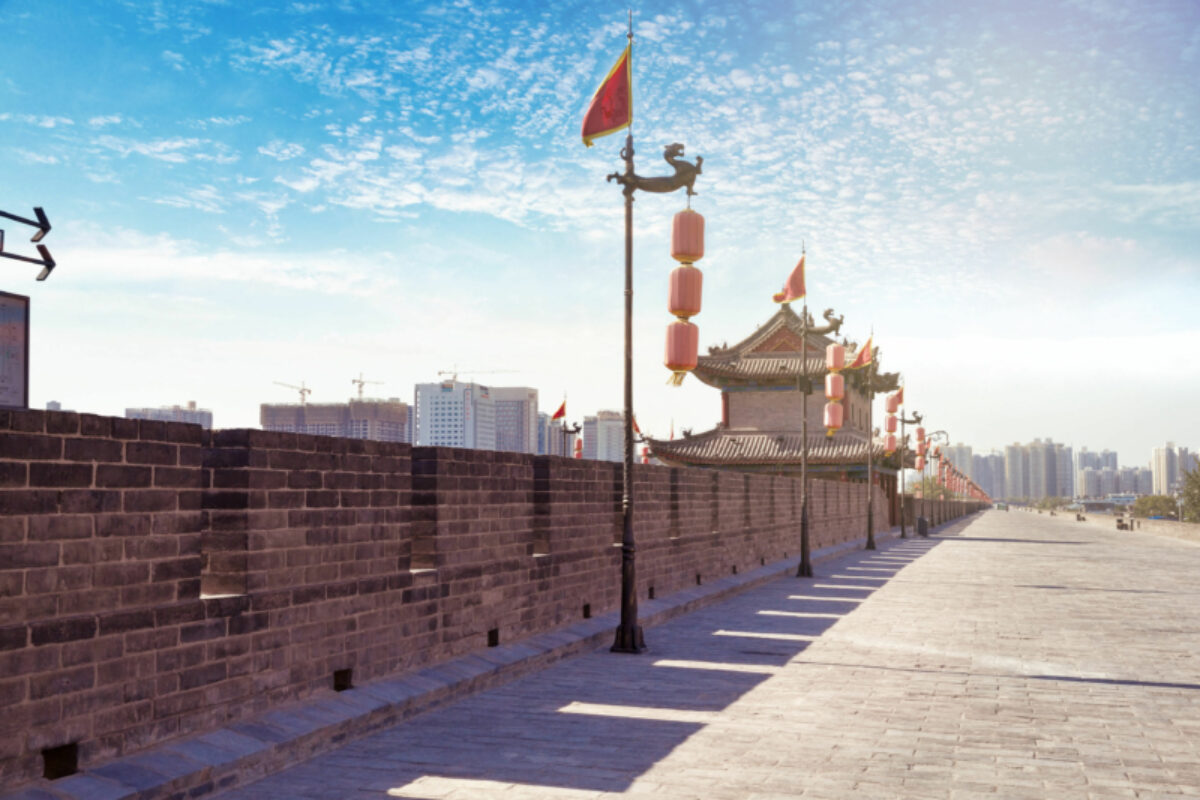
Xi'an beyond the Terracotta Warriors
Beyond Xi’an’s Terracotta Warriors lies a treasure trove of culture, history and artefacts waiting to be discovered.
Xi’an city wall
Xi’an’s fortifications were built in the 14th century and have been well maintained and restored over the succeeding eras, leaving the most completely preserved ancient city wall in China. The wall surrounds the old town and its ramparts are made of stone brickwork not unlike that of the Ming Great Wall , with wide ramparts large enough for walking, cycling, and excellent vantage points from which to view the city. Bikes can be all along the wall, which is a very manageable 13.7km long.
Seing Xi'an's Big Wild Goose Pagoda
Dating to the Tang dynasty (618-907), this striking pagoda nods to Xi’an’s history as a punctuation mark on the Silk Road. It’s brick build and plain, square design draws inspiration from the desert citadels of Central Asia and Persia, brought by monks and traders travelling to and from India and Europe.
Visiting Xi'an's Muslim Quarter
Xi’an is home to a huge community of Hui people, a Muslim ethnic minority group primarily from China’s northwestern provinces. The Hui are known for their amazing cuisine, particularly lamian, a type of hand-pulled noodle served in spicy beef broth. The back streets surrounding Xi’an’s drum and bell towers form traditional Hui neighbourhoods. These winding alleys house the Grand Mosque, surrounded by markets, bookshops, restaurants and food stalls operated by the Hui. Be sure to sample the local baked goods, as well as paomo, a type of lamb-broth stew eaten with torn pieces of steamed bread.
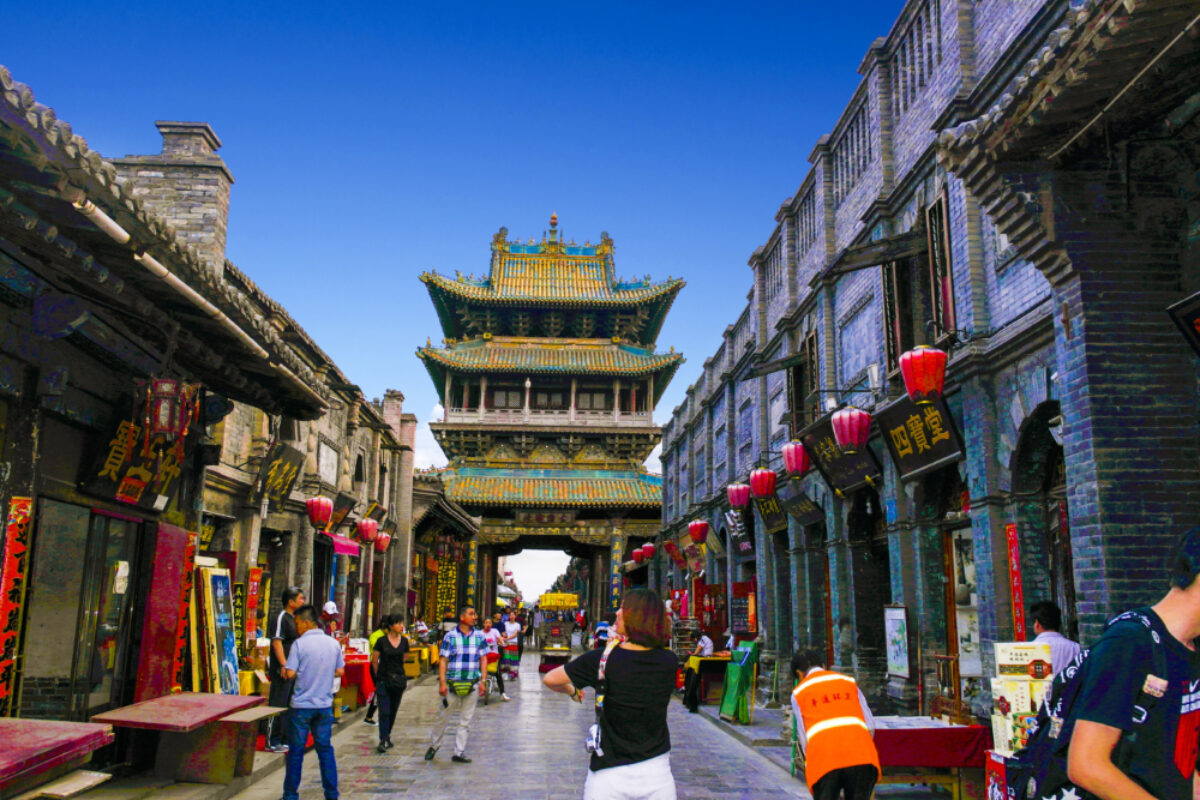
On the Shanxi trail: Alternative historical sights near Xi’an
Visiting pingyao.
About halfway between Beijing and Xi’an in Shanxi province, Pingyao is considered one of the most well-preserved ancient towns in China. The draw here is the completeness of the old town, with its serene courtyards and towering walled fortifications. It’s worth staying overnight to take in the atmosphere of historic alleyways lit by swaying red lanterns.
Exploring Datong and Yungang caves
Also in Shanxi, Datong offers a similar experience to Pingyao’s romantic lantern-lit streets and impressively restored ancient walls, with the addition of Yungang caves just outside of town. One of China’s premier Buddhist art sites, the caves comprise a collection of Silk Road grottos carved from the 5th century and drawing influences from across Central Asia, Persia and even Greece. Add a day or two in Datong to incorporate a visit to the Hanging Monastery, a Buddhist temple built on a cliffside on precarious stilts. Nearby are also a number of wild, unrestored remains of the Great Wall best explored with a guide.
About the author
Megan Eaves first visited China in 2004 with her Mandarin-language class and got hooked on Nanjing’s spicy weather and food. She’s lived in China twice and visited countless more times, travelling the length of the country from Guangdong to Qinghai and Guizhou to Beijing. She has written on China for Lonely Planet, CNN, The Independent and Atlas by Etihad , and is the author of This Is China: A Guidebook for Teachers , Backpackers and Other Lunatics . If lost, she is likely to be found scarfing down beef noodles in remotest Gansu province, or guzzling craft beer in a Beijing hutong.
Other guides you might like
The five stans, where to go and what to do in central asia.
Steven Hermans
The great wall of china, the great wall's best and less crowded sections, historical rajasthan, the historical sites of rajasthan, india's 'land of kings'.
Lakshmi Sharath
Petra and beyond, how to explore jordan's archaeological highlights.
Lauren Keith
Historical peru, how to visit peru's famous ruins and hidden gems.
Heather Jasper
Historical uzbekistan, where and how to see uzbekistan's historical cities, maya mexico, an essential guide to visiting mexico's maya archeological sites.
Susannah Rigg
Trekking in bhutan, an expert guide to the best treks in bhutan.
Bradley Mayhew
Why horizon guides.

Impartial travel guides
Our guides are written by the leading experts in their destinations. We never take payment for positive coverage so you can count on us for impartial travel advice.

Expert itineraries
Suggested itineraries and routes to help you scratch beneath the surface, avoid the tourist traps, and plan an authentic, responsible and enjoyable journey.

Specialist advice
Get friendly, expert travel advice and custom itineraries from some of the world's best tour operators, with no spam, pressure or commitment to book.
Our guides are 100% impartial and are written by independent, professional travel journalists. We make money by charging carefully-screened travel companies to list their business on our website. Our advertisers have no influence on our editorial content and we never accept payment for positive coverage.
Read more about how we work and what we believe in here .
- Travel guides
- Work with us
Sitemap , Privacy Copyright © 2024 Horizon Guides
Going Awesome Places
Detailed itineraries + travel guides
14 Day Terracotta Warriors Itinerary – Shanghai, Xi’an, Luoyang, and more
Last Updated March 2, 2023 William Tang
You are here: Home » Travel Itineraries » 14 Day Terracotta Warriors Itinerary – Shanghai, Xi’an, Luoyang, and more
It’s always been a dream of mine to see the fabled Terracotta Warriors in the legendary city of Xi’an. On this trip to China, I’ll be able to make that a reality as the family starts in Shanghai before hopping up to Luoyang and then Xi’an. Every time I go to China, there are a lot of twists, turns and surprises so make sure you follow along the live blog episodes throughout the 2 week journey from big city lights to mountain tops, temples, and Ming-era glory.
In this post also get an inside look into the planning for this trip and what the full itinerary is going to look like.
Read more about travel in China
- 144 Hour In-Transit Visa for China
- Essential China Travel Tips
- 2 Day Xi’an Itinerary
- See all of our China articles
How can you save money on travel?
- Hottest deals – Bookmark the travel deals page .
- Car rentals – stop getting ripped off and learn about car rental coupon codes .
- Hotels – Use corporate codes or get Genius 2 tier with Booking.
- Flights – Have you ever heard of the “Everywhere” feature ?
- Insurance – Make sure you’re covered and learn more about where to buy the best travel insurance .
In This Article
Read all the episodes of our trip
14 day itinerary, luoyang guide, xi’an guide, glimpse of what’s to come, tips and lessons learned.
Throughout the two week trip, I’ll be compiling a few live blogging posts about my experiences and journey up to Xi’an.
- Episode 1: Back to Shanghai we go!
- Episode 2: Shaolin Temple – Birthplace of Kung Fu
- Episode 3: Yuntai Mountain Geo Park
- Episode 4: Luoyang – Peony, Temples and Grottoes
- Episode 5: Xi’an – Terracotta Warriors Museum
- Episode 6: Mount Hua and Plank Walk
- Episode 7: Xi’an – 2 Day Itinerary in the City
- Episode 8: Xi’an – Tomb of Emperor Jingdi and Yuan Jia Cun
Planning the road to the terminus of the Silk Road
I’m always a bit apprehensive about travelling in China because I always come out of it with mixed feelings. On one hand, the landscape, culture, history and food is one of a kind but in a lot of ways tourism in China is still in its developing phases and there are many places that are still very raw. It’s hard to describe but for those that have been to China, you will know what I mean. You really have to go into China with a different set of expectations and go in with an open mind to accept whatever comes your way.
So with this being a family trip I had to find a fine balance between being guided and having the freedom to explore on our own. The one thing I told my parents up front was that I absolutely did not want to do a Chinese bus tour. Sure they’re incredibly cheap but I just can’t stand the shopping stops, cheap food and ridiculously short photo stops. That is why we planned this trip on our own, identifying all the major spots we wanted to hit up but do it with the help of local private drivers.
Here’s a look at all the spots we’ll be going to on this trip:
[Day 1 – 5] Accilimate in Shanghai
- Spend time exploring Shanghai
- Take advantage of the affordable tailors
- Check out the Shanghai markets
- Eat good food
[Day 6] Kung Fu Mecca (with Lisa)
- Flight from Shanghai to Luoyang
- Shaolin Temple
- Stay in Dengfeng
[Day 7] Yuntai Mountain (with Lisa)
[Day 8] Impressive Grottos (with Lisa)
- White Horse Temple
- Peony Garden (we’re there just in time for the Peony Festival in Luoyang)
- Longmen Grottoes
- Bullet train to Xi’an
[Day 9] Terracotta Warriors (with Michael)
- Terracotta Warriors & Emperor Chin Shi Huang’s Tomb
- Banpo Neolithic Village
- Big Wild Goose Pagoda
[Day 10] Mount Hua
[Day 11] Exploring Xi’an on our own
- Walk to East Gate from the hotel
- Explore East Gate
- Bike the City Wall from 10:45AM – 1:30 PM
- Lunch at a local noodle shop
- Roam around Shuyuanmen Cultural Street
- Small Wild Goose Pagoda
- Big Wild Goose Pagoda markets
- Dinner at a Chinese fast food restaurant
- Watch musical fountain show at Big Wild Goose Pagoda
[Day 12] Exploring Xi’an on our own
- Shaanxi Museum
- Big Wild Goose Pagoda
- Muslim Quarter
- Lunch in the Muslim Quarter
- Dinner at a dumpling restaurant
[Day 13] Countryside of Xi’an (with Michael)
- Tomb of Emperor Jingdi
- Yuan Jia Cun Village
- Overnight train back to Shanghai
[Day 14] Back Home
Local guides in China
This was probably one of the hardest things when planning the trip. There really is no central resource to find good reputable English speaking guides. In the end I relied purely on the TripAdvisor forums to see what others had posted about good guides.
Here’s how to search for a guide on TripAdvisor:
- Go to Tripadvisor.com

- Do a search for the term “guide”
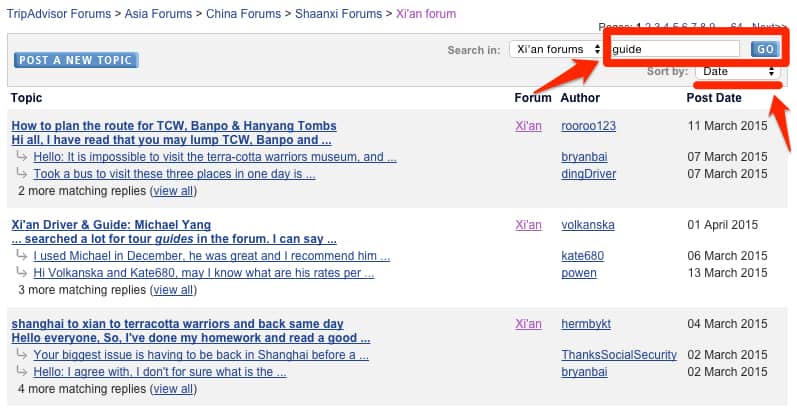
- Start reading
Here are the two guides we’ve selected for our trip.
Name: Lisa
E-mail: [email protected]
Price: 3600 RMB total
- Guide 400 RMB x 3 days = 1200 RMB
- Van 2200 RMB
- Accommodation for driver and guide for one night 150 RMB x 2 persons = 300 RMB
- 100 RMB discount (she would not negotiate any lower)
TripAdvisor forum thread: Lisa, An Excellent Tour Guide for Luoyang and Shaolin (I’ll be honest I looked pretty hard to find alternatives but Lisa’s really done an excellent job at being pretty much the only player in town. Did she wipe out the competition some how? :O)
Pre-trip feedback: Compared to Michael, Lisa was a little slower to respond and not as easy to communicate with. We were also a bit puzzled by the need to pay for both a guide and a van but after doing some research it looks like that’s how most guides are in Luoyang. Guides just do the talking but not the driving. Strange that it varies so much from city to city. In the end, we were able to negotiate something that worked for us but as you can see her prices are a lot higher than Michael in Xi’an.
Post-trip feedback: As our first guide of the trip, I thought Lisa was pretty good throughout the trip. She was quite knowledgeable about everywhere we went to and was incredibly accommodating in terms of our (really my) pace and what we wanted to see. Typically before getting to each place she’d give us a detailed rundown of the history of the location and from there she’d answer any questions that we had.
Driver wise, he was quiet throughout but he efficiently got us from place to place, dropping us as close to the entrance as possible and picking us up on time. One of the nice things was that our van was stocked with water although they had this strange tasting soda water that I just couldn’t get used to. There was also never any expectation to pay for dinner as it felt like they much preferred eating on their own but we did end up treating them to a few meals.
Now where Lisa could’ve improved I thought was that often times while at a certain site, she wasn’t that great with being proactive about continuing the conversation about where we were at and diving a little deeper. There was less from Lisa in terms of anecdotes and I even caught her a few times taking photos of info plaques to presumably memorize for later. There were also a few times where there was definitely a small gap in English. A lot of times I’d say something and she’d just look puzzled and that resulted in my parents jumping in to translate to English. That’s not to say her English was bad but overall her command of the language was mainly just around her talking points along the tour.
Overall, I’d definitely recommend Lisa to anyone heading down to Luoyang and is looking for a private guide.
Photos of Lisa:
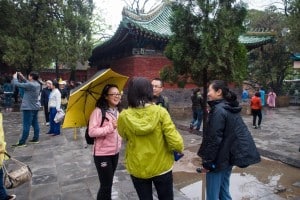
Name: Michael Yang
E-mail: [email protected] or [email protected]
Phone number: 13991917258
Price: 1950 RMB total
- Day 1 (Terracotta Warriors day) 450 RMB
- Day 2 (Hua Shan mountain day) 800 RMB
- Day 3 (Explore country side and Yuanjia Cun) 700 RMB
TripAdvisor forum thread: Tour guide Michael Yang (there are more if you search)
Pre-trip feedback: Michael’s been really easy to communicate with via e-mail to coordinate everything. His e-mails are clear. What I love about Michael is that he understands that we don’t want to go to any tourist traps, shopping spots and how we want to eat at local authentic restaurants. His pricing structure was also made a lot of sense for us as it seems that he is both the driver and the guide.
Post-trip feedback: I thought Lisa was awesome until we got Michael in Xi’an. For one, it just made that much more sense that he was driver and guide. That meant we didn’t have to pay extra like we did in Luoyang. Michael’s command of English was also way better. We later found out that he actually taught English at a university in the city. What really set Michael apart from Lisa was the fact that he was constantly aware of giving us the best experience throughout which was most prominent when we were at the Terracotta Warriors and he made sure we stayed away from the big hoards of tour groups and gave us proactive tips on not buying the warriors at the “official store”.
Comparing to Lisa, Michael was just a lot better at thoroughly explaining everything to us and in English all the way through. I loved how he’d throw in anecdotes and fun stories in there too that really provided us better context of what we were seeing and experiencing. Overall he just seemed that much more confident and knowledgable about EVERYTHING.
His style was definitely different as well. Where Lisa was very laid back and relaxed, Michael was much more up tempo and more regimented in terms of really guiding us through each spot of a site step by step. While strange at first, I ended up loving the fact that he’d always go “Hey William! Come over here.” and pull us aside to a specific area to give us an explanation and point out things that we’d never even notice.
Oh yeah and his car was stocked with regular water. That was incredibly helpful because we could just drink from his stash and even after the day was over he’d give us a bunch to take back to the hotel.
There’s nothing more that I can say other than, Michael’s your guy in Xi’an. He’s a fine gentleman and really knows how to provide quality guide service to his customers. He books up quickly so I would recommend reaching out to him as soon as you have details locked down.
Photos of Michael:
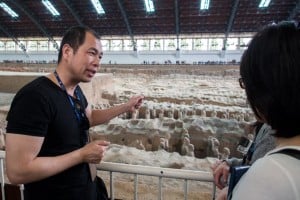
Voice recording of Michael: While I didn’t get to do this for Lisa, this little excerpt of his explanation inside the Terracotta Warriors museum gives you an idea of his excellent English. (Sorry if the player widget below is a little wonky)
Here’s a little photo journey through some of crazy wicked cool things we’ll be seeing on this trip.
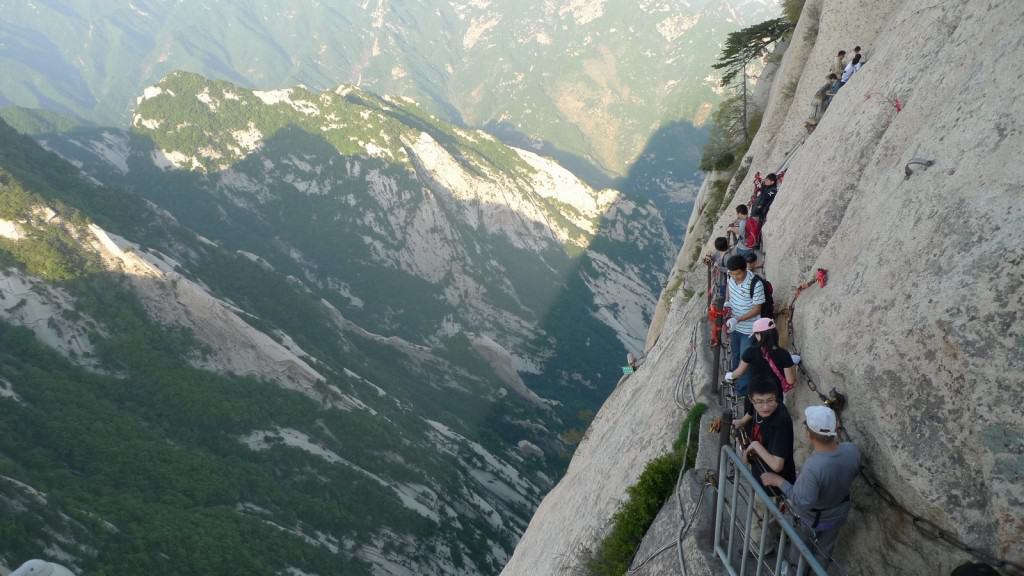
- HOTELS – When booking hotels in China, it’s totally different than how it is in North America. Agoda and Ctrip reign supreme. I loved how with Agoda specifically that I could pay with Paypal. Keep in mind that there are additional service fees tacked on at the top at the end so to know the real price, always go to the final page.
- FLIGHTS – Ctrip was the easiest for us to book flights within China.
- TRAIN – We ended up getting our private guides to buy our train tickets but a great resource to figure out train schedules is Travel China Guide .
- GUIDES – How did we find the guides we used? TripAdvisor ended up being the best resource for local guides in both Luoyang and Xi’an. Yes, guides can buy train tickets for you in advance which is a good idea especially if travelling around when any China holidays are. All they need is a scan of your passport.
What you should read next
- Competitours 2015 – Follow Team Awesome Duo
- 2 Day Xi’an Itinerary – What To See in this Walled City of China
- Journey To the Terracotta Warriors Extended Cut
- How To Visit Shaolin Temple – Birthplace of Kung Fu
- How To Visit the Terracotta Army In Xi’an, China
About William Tang
William Tang is the Chief of Awesome behind the award-winning Going Awesome Places which is focused on outdoor adventure, and experiential travel. His true passion lies in telling stories, inspiring photography and videos, and writing detailed itineraries and travel guides. He is a member of Travel Media Association of Canada (TMAC), Society of American Travel Writers (SATW), Adventure Travel Trade Association (ATTA), and Travel Massive. He has also been featured in publications such as Reader's Digest, Entrepreneur, Men's Journal, and Haute Living. Make sure to learn more about William Tang to find out his story and how Going Awesome Places started.
Find us on social media

How to Visit the Terracotta Warriors Xi’An, China
I’m usually one who always opts out of the guided tours and goes at it on my own. I like to figure it out, be able to write about the process so that I can share it with you, not be on a strict time schedule, and its always a bonus to save few bucks. With that being said, I highly recommend getting a private guide (around $20 USD) on arrival or booking a small (max 4 people) Terracotta Warriors tour when seeing this site.
Visiting the Terracotta Warriors
For full transparency, I have sprinkled some affiliate links in this post which gives me a small commission at no extra cost to you if you decided to make a purchase. As always, I would never recommend a product or service that I didn't truely believe in. If you find this post useful, you can also treat Jess to a cup coffee by clicking the icon on the bottom of the page. This will allow me to continue to create more content for you to enjoy ☕️.
How to Get to the Terracotta Warriors
The Terracotta Warriors are located about an hours drive outside of Xi’An . You can reach the tombs by rental car, public bus, take a cab or DiDi (the Uber of China), or with one of the many tourist buses.
It cost 150 Yen, roughly $20 USD to enter . If you have a student ID then it is half the price.
Opening hours are from 8:30 a.m. -5:30 p.m during the months of December-February and till 5 pm the rest of the year.
By Bus: If you’re taking public buses from the Xi’An Train Station head to the Eastern car park and take one of the air-conditioned green or blue, English labelled ‘Terracotta Warriors’ buses. 8 Yen, it takes one hour and leaves every ten minutes.

Follow me on social media

Hi, we’re Jess (& Joe). We hope you’re enjoying our free travel guides and tips. If so please consider buying us a coffee ☕️. We appreciate your support!

🎥 Do you follow us on You Tube? Subscribe to follow along on our adventures!

Popular Posts
Rachel Meets China

How To Visit the Terracotta Warriors of Xi’an
The Terracotta Army depicts the armies of the first emperor of China, Qin Shi Huang. They were buried with the emperor in 210-209 BCE with the purpose of protecting him in his afterlife. The figures were discovered in 1974 by local farmers outside of Xi’an, and the warriors are now considered an 8th World Wonder.

How to Visit the Terracotta Warriors
The Terracotta Warriors are located around 30 kilometers east of Xi’an, the capitol of Shaanxi Province. There are a few ways to visit the Terracotta Warriors:
Take a bus to the Terracotta Warriors
Depending on where you are coming from, there are many buses that you can take. If you are coming from the Xi’an Railway Station, North Train Station, or the Xi’an Xianyang International Airport, you can see which buses to take here.
Take a tour van to the Terracotta Warriors
There are many travel agencies and tour groups that arrange trips to see the Terracotta Warriors. They will usually arrange a van to take you and possibly a few other customers, depending on if you book a private tour or not.
- China Highlights
- Top China Travel
Take a taxi/didi to the Terracotta Warriors
Alternatively, if you don’t want to take a bus or book with a tour group, you can take a taxi or call a Didi to take you.

Buying Tickets for the Terracotta Warriors
The museum is usually open from 8:00 AM to 6:00 PM. The ticket will cost you RMB150 ($21 USD) per person. This price includes entry to the vaults and museum, plus the documentary film of the warriors and their excavation.
You can buy tickets at the site, or ahead of time if you book with a tour group. Our group bought tickets on site, but it’s recommended you do some research and double check before you go.
We had to pay in cash for our tickets, so make sure you bring extra along – or there is an ATM there.

The 3 Pits at the Terracotta Warriors
There are 3 pits you can visit to see at the Terracotta Warrior Museum. Most people will usually follow the set path from Pit 1 to Pit 3 to Pit 2.
Pit 1 is the biggest pit and contains more than 2,000 figures.
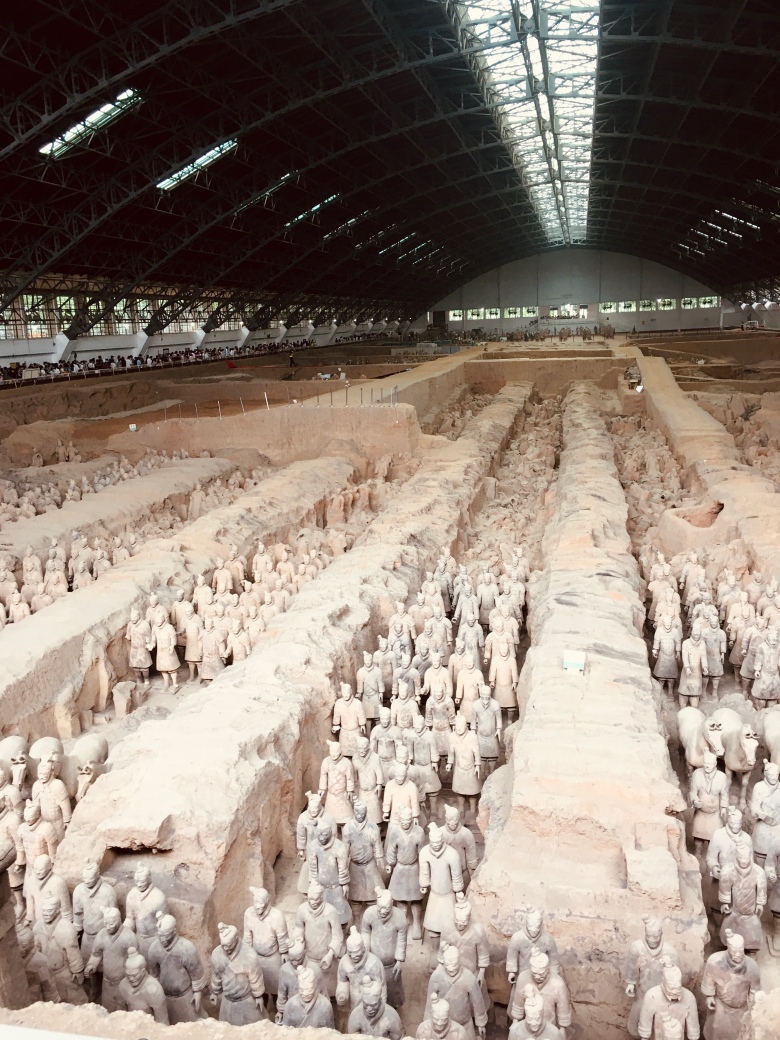
Pit 3 is the command post where the high ranking officers can be seen. It is the smallest pit to walk around.
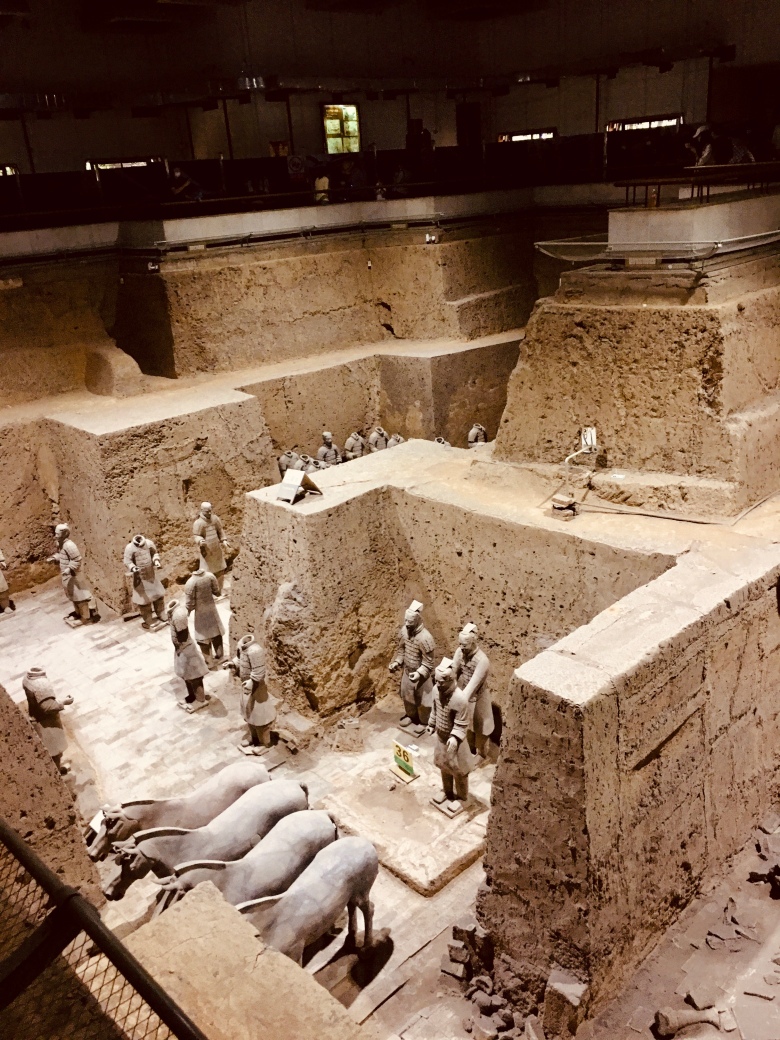
Pit 2 has mostly been excavated. It is large, but does not feature many sculptures.

Tips for Visiting the Terracotta Warriors:
- Arrive early in the day, before the crowds arrive around 10am. Alternatively you can arrive around 12pm when many people leave for lunch.
- Usually a few hours is enough time to see all the pits.
- If you don’t have a guide with you, you can rent an audio guide (in English) to listen to as you walk through the pits.
- Many vendors will be walking around trying to sell sculptures and figures. If you want to buy from them, you should barter with them to lower the prices.

Visit the Terracotta Warriors in Xi’an
The Terracotta Warriors are a must see when visiting Xi’an! Take the opportunity to see one of the wonders of the world!
After a trip to the Terracotta Warrior Museum, check out these 5 Must Eat Dishes at the Muslim Quarter in Xi’an

Share this:
I loved seeing the terracotta warriors! Great post!
WOW. The warriors have been high on my bucket list for a long time, along with The Great Wall and some of the thousand-step climbs. Great tour Rachel.
Leave a comment Cancel reply

- Already have a WordPress.com account? Log in now.
- Subscribe Subscribed
- Copy shortlink
- Report this content
- View post in Reader
- Manage subscriptions
- Collapse this bar
- 86-19138970032 (GMT+8 18:00~09:00)

- Beijing Xian Tours
- Shanghai Beijing Tours
- Hong Kong Guilin Tours
- Hangzhou Suzhou Tours
- Kunming Lijiang Tours
- Shanghai Yangtze Cruise Tours
- Chengdu Tibet Tours
- More Short Stay Tours
- China Tours in January
- China Tours in February
- China Tours in March
- China Tours in April
- China Tours in May
- China Tours in June
- China Tours in July
- China Tours in August
- China Tours in September
- China Tours in October
- China Tours in November
- China Tours in December

- High Speed Trains
- China Yangtze Cruise Tour
- Photography
- Desert Adventure
- Ethnic Villages
- Biking Tours
- Kung Fu Tours
- Heritage Sites Exploration
- China Spring Tours
- China Summer Tours
- China Autumn Tours
- China Winter Tours
Notice! 2024 available cruise routes include 4~5 days Chongqing-Yichang(most classic) and 11~12 days Chongqing-Yichang-Shanghai(limited).

- Best-value Yangtze Cruises
- Top Family-friendly Cruise Ships
- Top 3 Luxury Yangtze River Cruises
- Yangtze River Highlights
- Yangtze River Cruise Routes
- Upstream or Downstream?
- Dining & Drinking
- Accommodations
- On-board Activities
- Yangtze Cruise Booking Steps

- Inner Mongolia

- Fanjingshan
- How to Plan Your First China Tour
- How to Plan Beijing Tour
- How to Plan Xian Tour
- How to Plan Shanghai Tour
- How to Plan Guilin Tour
- How to Plan Sichuan Tour
- How to Plan Family Tour
- 2024 China Travel Ideas
- Best Time to Visit China
- What to Pack for Your China Journey
- Updated China Travel News
- Ultimate Chinese Visa Guide
- Chinese Visa Types
- Chinese Visa Requirements
- Do I Need a Visa for China
- Chinese Visa Application
- Chinese Visa Exemptions
- 144-hour Visa Free
- Shenzhen Visa on Arrival
- Hainan 30-day Visa Free
- Embassies & Consulates
- Invitation Letter
- Useful Visa FAQs & Tips
- Entry Regulations
- Baggage Allowance
- Customs Declaration
- Exit Regulation
- How to Book Train Tickets
- How to Collect Train Tickets
- How to Cancel & Alter Train Tickets
- How to Read Train Tickets
- China High Speed Train Types
- Seats Class & How to Choose
- Friendly Facilities on the Train
- The Train Station Departure Process
- Available Food and Drinks on the Train
- Western Toilets on the Train
- Luggage Racks & Baggage Allowance
- Beijing Train Stations
- Shanghai Train Stations
- Guilin Train Stations
- Xian Train Stations
- Chengdu Train Stations
- Hong Kong West Kowloon Railway Station
- Beijing - Xian
- Beijing - Shanghai
- Guangzhou - Shanghai
- Shenzhen - Shanghai
- Chengdu - Xian
- Shanghai - Hangzhou
- Shanghai - Xian
- Chengdu - Chongqing
- Kunming - Lijiang
- Beijing Capital International
- Beijing Daxing International
- Shanghai Pudong International
- Shanghai Hongqiao International
- Guangzhou Baiyun International
- Hangzhou Xiaoshan International
- Chengdu Tianfu International
- Chengdu Shuangliu International
- Xian Xianyang International
- Shanghai - Beijing
- Hong Kong - Shanghai
- Guangzhou - Beijing
- Chengdu - Lhasa
- Shanghai - Guilin
- Shanghai - Sanya
- Travel in Spring Season
- Travel in Summer Season
- Travel in Autumn Season
- Travel in Winter Season
- Weather in January
- Weather in February
- Weather in March
- Weather in April
- Weather in May
- Weather in June
- Weather in July
- Weather in August
- Weather in September
- Weather in October
- Weather in November
- Weather in December
- Top 10 China Destinations
- Top 15 Things to Do
- China World Heritage Sites
- Top 10 Best Natural Beauties
- Top 10 Museums in China
- Top 10 Old Towns & Villages
- Five Great Mountains in China
- Top 10 Monasteries & Temples
- Top 10 Ski Resorts
- Top 10 Beautiful Lakes in China
- 7 Best Beaches in Sanya
- Top 6 Beautiful Waterfalls
- Panda Volunteering
- Having fun on Ice and Snow Festival
- About Us Who We Are Our Team Why Travel with Us Feedback & Reviews Travel Stories Travelers' Gallery Payment Guide Customer Support Contact Us
- Tour Experiences
Destinations
- Travel Guide
Terracotta Warriors and Horses - Officially Emperor Qinshihuang's Mausoleum Site Museum
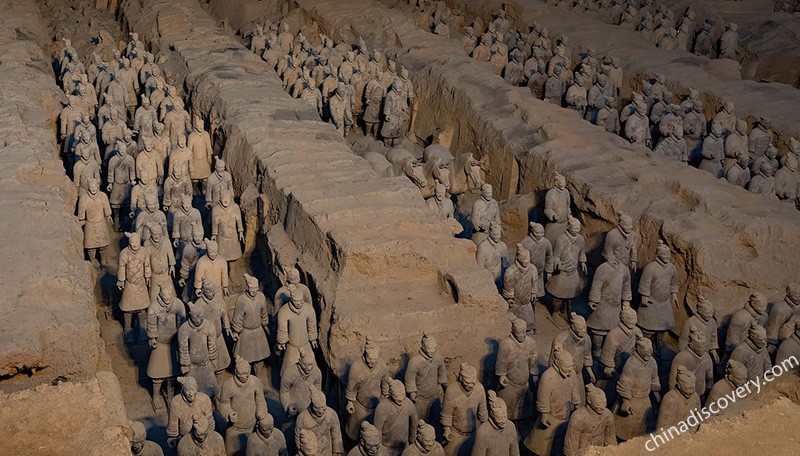
About Terracotta Warriors and Horses
They call it the eighth wonder of the world, and they're right. Discovered in 1974, Terracotta Warriors and Horses, officially named as Emperor Qinshihuang's Mausoleum Site Museum, is one of the greatest archeological finds in 20th century, and it definitely should be on your bucket list.
Type: World Heritage Site, Historical Site, Specialty Museum
Best Seasons: All Seasons
Recommended Visiting Time: 3~5 hours
Opening Hours: March 16th – November 15th: 8:30 – 18:30 / November 16th – March 15th: 8:30 – 18:00
Ticket: CNY 120/person
Address: Qinling North Road, Lintong District, Xi'an 710600, China
Why Is Terracotta Warriors and Horses Important
Reputed as one of the greatest archaeological finds in the twentieth century and the eighth wonder of the world , buried at 1.5 km east of Qinshihuang’s Mausoleum, Terracotta Army or Terracotta Warriors and Horses (兵马俑) is the funerary object of Emperor Qinshihuang (259~210 BC), the first Emperor of China. In ancient China, people believed in after-world, thus, Emperor Qinshihuang built the Terracotta Warriors and Horses as his underground army to protect his soul in the after-world.
In 1979, Qin Terracotta Warriors and Horses Museum was open to the public on the excavation site. In 1987, the museum, together with the Mausoleum of the First Qin Emperor (they were combined into Emperor Qinshihuang’s Mausoleum Site Museum in 2009, the museum was selected by Trip Advisor as the top 25 museum in the world , the only Asian museum on the list) were listed as World Heritage Sites by UNESCO. After being buried in the ground for over 2,200 year, the Terracotta Army was finally accessible to public.
Latest Updates from Terracotta Warriors and Horses
From 2009 to 2022, the Qin Shihuang Mausoleum Museum conducted the third formal excavation of Pit 1, located in the T23 and T24 quadrants of Pit 1. The excavation included the third part of the pit, including four passageways (G8-G11), three partition walls (Q8-Q10), and the north wall of the pit. The excavation area was approximately 430 square meters. A total of over 220 pottery figures and 16 pottery horses were cleared, as well as four chariots, two drums, one drumstick, one lacquered shield, three quivers, multiple spear shafts, multiple bows, crossbows, and arrow quivers. In addition, a variety of vehicle and weapon components, as well as production tools, were discovered, totaling over a thousand items. The third excavation yielded a number of important discoveries and new insights.
Specifically, the third excavation revealed the following:
The discovery of a new type of pottery figure, a "spearman with shield," which is armed with a spear and a shield. This is the first time that this type of figure has been discovered in Pit 1.
The discovery of a new type of pottery horse, a "four-horse chariot horse," which is larger and more muscular than the previous type of chariot horse. This suggests that the Qin army used larger and more powerful chariots than previously thought.
The discovery of a new type of weapon, a "glaive," which is a long, curved sword. This is the first time that this type of weapon has been discovered in Pit 1.
These discoveries provide new insights into the Qin army, its weapons and equipment, and its military tactics. They also help to shed light on the culture and society of the Qin dynasty.
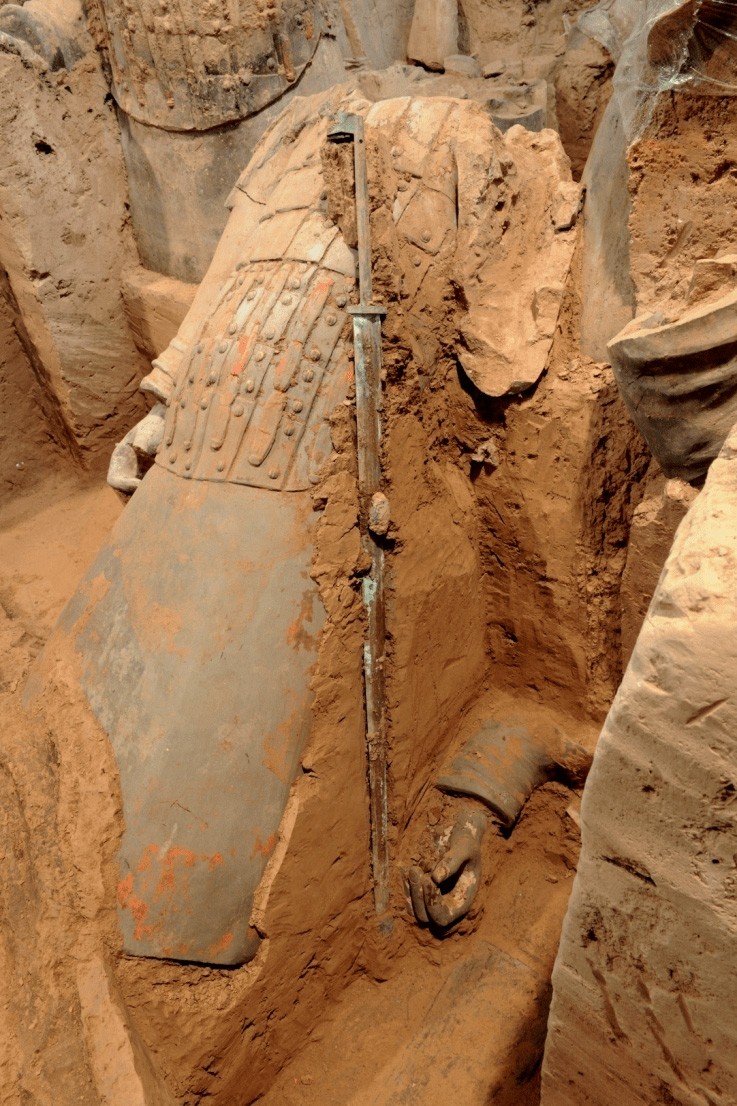
Discovery of Terracotta Warriors and Horses
There is a small village called Xiyang Village and located 1.5km east to the Qinshihuang’s Mausoleum. The southern part of the village was once a persimmon forest. In March 1974, the villagers of Xiyang Village were planned to dig a well in the persimmon forest to fight the drought. During the digging, they found several wrecked terracotta figures and some bronze weapons. The Villagers stopped the digging and informed the local authority immediately. In July 1974, an archaeological team was sent to excavate the discovery site, thus, the magnificent Terracotta Warriors and Horses started to reveal its true face to the public.
The first discovered terracotta warriors pit was called Pit One. In 1976, the State Council decided to establish an exhibition hall on the Pit 1. In the construction progress, Pit 2 was found in the north of the eastern part of the Pit 1. In May of the same year, Pit 3 was found in the north of the western part of the Pit 1. Now, three Pits are all opened to the public, and you can even see the site excavation on the Pit Two.
No matter when you come to Xian, visiting the Terracotta Warriors and Horses is the No. 1 thing to do in Xian. Below are 3 recommended Xian Tour Packages including the Terracotta Warriors and Horses
- 2 Days Xian City Break - 3 Days Classic Xian Tour - 4 Days Xian Highlights Tour with Mount Huashan Hiking
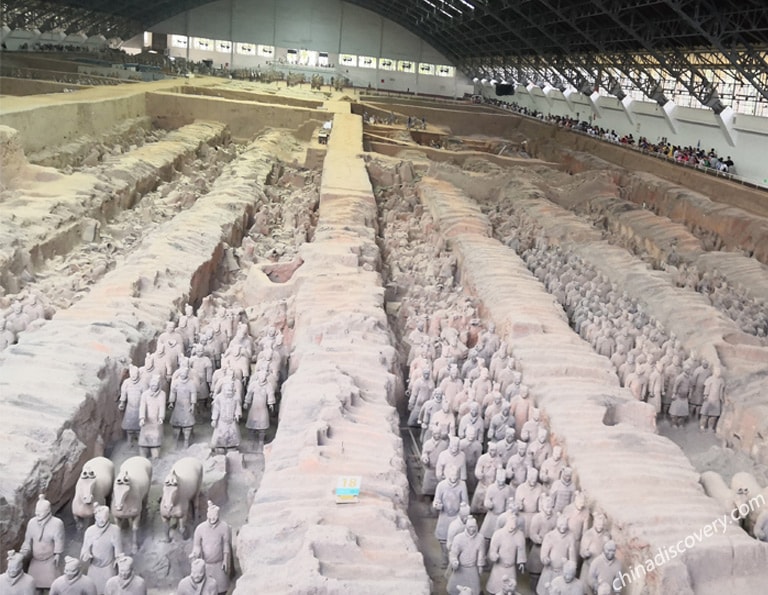
Terracotta Warriors and Horses Location and Transportation
The Terracotta Warriors is situated at Qinling North Road, Litong District, Xian City, Shaanxi Province (陕西省), Northwest China which neighbors with many inland provinces including Inner Mongolia in the north, Shanxi and Henan Provinces in the east, Chongqing, Sichuan and Hubei Province in the south, Gansu and Ningxia in the west. Chinese address is: 西安市临潼区秦陵北路秦始皇兵马俑博物馆. It is about 40km from Xian downtown, about 66km from Xian Xianyang International Airport, about 66km from Xian Xianyang International Airport, about 48km from Xian North Railway Station.
To visit the Terracotta Warriors, you need to get to Xian by flight or train first. ( Get to Terracotta Warriors from Beijing | Get to Terracotta Warriors from Shanghai ) After arriving at Xian, you can take subway, tourist bus or taxi to get to the Terracotta Warriors.
- Xian City Center to Terracotta Warriors - Xian Airport to Terracotta Warriors - Xian Train Stations to Terracotta Warriors
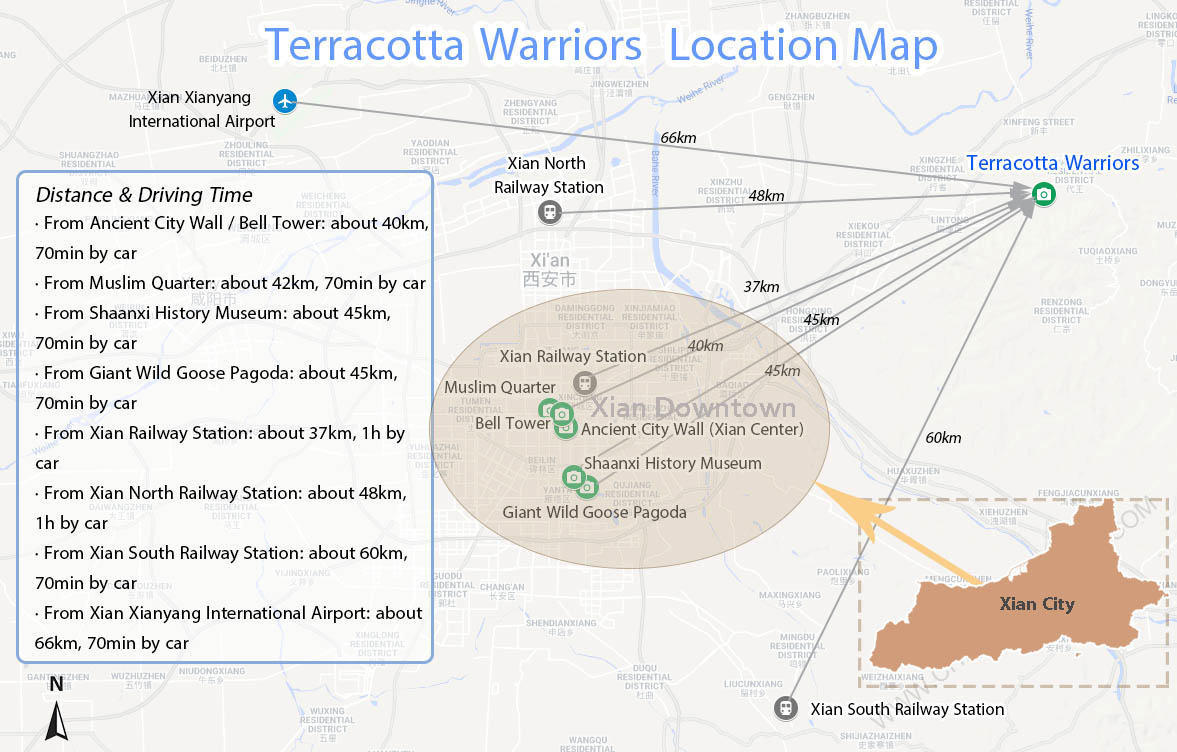
What to See in Terracotta Warriors and Horses?
The entry ticket is for Emperor Qinshihuang’s Mausoleum Site Museum, and the museum contains Qin Terracotta Warriors and Horses Museum and Mausoleum of the First Qin Emperor. Normally, it’s recommended to visit Terracotta Army first, and if you have extra time, you can take the free sightseeing bus (about 2.2km) to the Mausoleum.
As the highlight of the whole travel, Qin Terracotta Warriors and Horses Museum contains four parts, Pit 1, Pit 2, Pit 3 and the Exhibition Hall. To avoid detour, most visitors choose the following visiting route: Pit 1 – Pit 3 – Pit 2 – Exhibition Hall .
Pit 1 - largest number of warriors displayed
With a rectangular shape, Pit 1 is the largest of the three pits , 210m long and 61m wide, almost as large as two football fields . There are 10 partition walls (2.5m wide) in the pit to separate the army into different columns. At present, over 1000 terracotta warriors, 8 chariots, 32 terracotta horses and thousands of bronze weapons has been excavated from Pit 1. According to the density of this arrangement, it’s estimated that Pit 1 has over 6,000 terracotta warriors and horses in total. The terracotta warriors and horses in Pit 1 form an ancient battle array, which are composed of chariots and infantry. In the east end, three columns (68 warriors in each column) infantry facing to the east are the vanguard of the array; chariots and infantry behind the vanguard are the main part of the array; while in the south, north and west end, each has one column of infantry facing to the three directions, there are the wing guard and the rear guard of the array.
Pit 2 - go to watch Kneeling-standing Crossbowmen and General
Though smaller than Pit 1, Pit 2 is called the essence of the three pits for it has more complex battle array and more kinds of warriors. The discovery of the Pit 2 revealed the mystery of ancient battle array. Discovered in 1976, Pit 2 houses over 1,300 terracotta warrior and horses, and covers an area of 6000m2 and is made of four units.
The first unit is in the eastern part, composed by kneeling and standing crossbowmen. The second unit is the chariot array in the southern part. The third unit is the central array, composed by chariot, infantry and cavalry. And the fourth unit is the cavalry array in the northern part. Organic combination of the four units forms an unassailable army array, highly efficient in attack and defense.
Pit 3 - Command center of the army
Only 520m2 large, 17.6m from east to west and 21.4m from south to north, Pit 3 is the smallest one. It has 72 terracotta warriors and horses in total. According to the arrangement in the pit, archaeologists believe that Pit 3 is the command center of Pit 1 and Pit 2. Also, Pit 3 is the only pit surviving fire attack in history , thus, the terracotta warriors reserved more colors when they were unearthed.
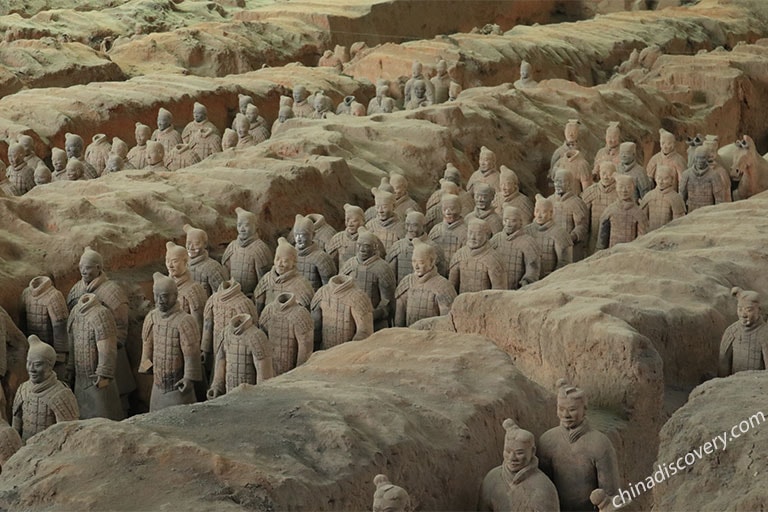
Exhibition Hall
The Exhibition Hall has three display rooms to exhibit various articles from Qin Dynasty. The most famous one is the Bronze Chariot and Horses . In 1980, archaeologists discovered two sets of bronze chariots and horses from 20m west of the Mausoleum of the First Qin Emperor. Each chariot was equipped with four bronze horses, and they are the half size of the real imperial chariots for the Emperor Qinshihuang. Made of over 3,000 components, the shape and structure of the Bronze Chariots and Horses are almost the same with the real one. Over 2,000 years, the carriage wheels can still rotate, while the halter and the rein are still flexible, how amazing it is! The Bronze Chariots and Horses are the largest and most completed ancient carriage unearthed in history, such reputed as the Crown of the Bronze Works.
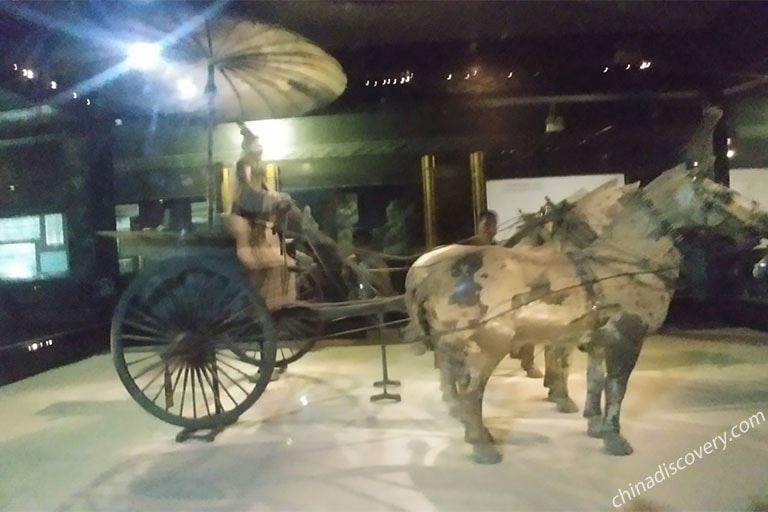
Funny Facts about Terracotta Warriors and Horses
Different facial expression and posture.
It’s said that no two terracotta warriors are alike. Facial expression, hair style, moustache style, costume and hand gesture are various from each other . Qin terracotta warriors were made using realistic style. So, after the unification of China, soldiers in Qin Army were from different areas and technics; besides, craftsmen were varied with different life experiences and skill, thus, no two terracotta warrior are the same.
Colorful Terracotta Warriors
Since most of the terracotta warriors are look white grey today, it’s hard to imagine that they were painted with different colors in the past. The original terracotta warriors were painted with skin color on the face and hand, and their costumes were also painted with various vivid colors . However, when they were unearthed, the terracotta warriors were oxidized and all colors just turned into white grey in few minutes. The good news is that after a decade’s efforts, with the help of Germany scientists, the color of the terracotta can be reserved now.
Life-sized Terracotta Warriors
The average height of terracotta warriors is about 180cm; however, the average height of Qin people is about 170cm. Why is the difference? According to the archaeologist, after Emperor Qinshihuang unified China, it’s easy to choose tall and strong soldiers from all over the country. On the one hand, Qin was famous for its strong military force; of course the army would recruit taller and stronger ones as its warriors. On the other hand, Emperor Qinshihaung craved for greatness and success, and he preferred more magnificent and delicate works.
Bronze Weapons
Tens of thousands of bronze weapons were unearthed with the discovery of the Terracotta Warriors and Horses. The bronze weapons were all actual combat weapons in Qin Dynasty. After being buried in the ground for over 2,000 years, no corrosion had happened to the weapons . The craftsmen at that time had conducted chemical treatment to the bronze weapons, thus formed a chromium oxidation layer to keep the weapon from corrosion. You will be surprised when knowing that the similar technology was invented by the US in the 50s of 20th century .
>> Terracotta Warriors Facts - 10 Questions about The Terracotta Army
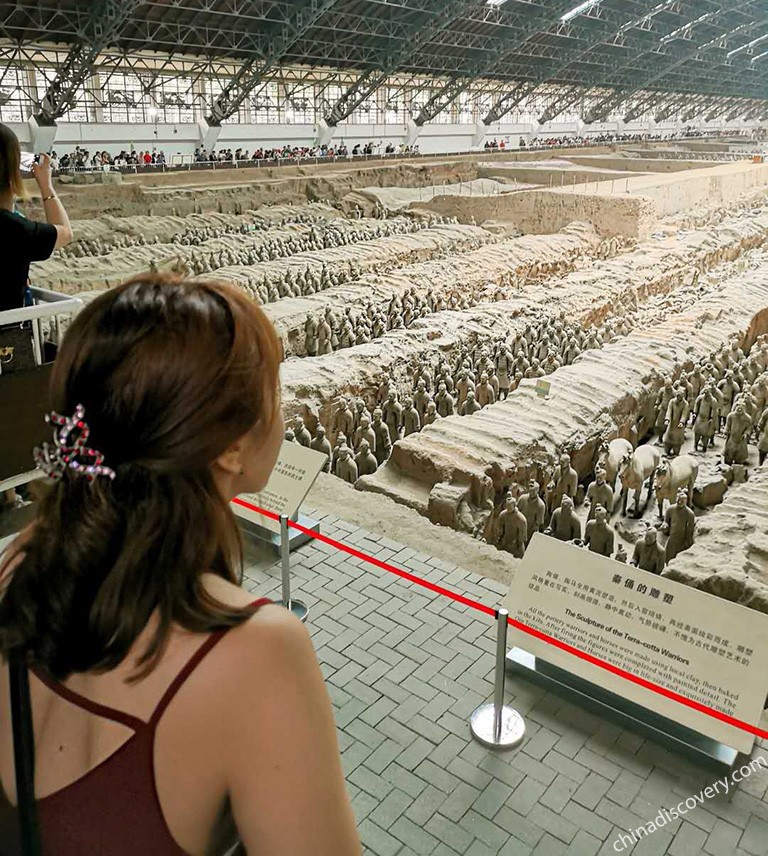
Emperor Qinshihuang and his Terracotta Army
Qinshihuang (秦始皇 259 – 210BC), known as the first emperor in China , whose name was Ying Zheng (嬴政), came to the throne of Qin State when he was 13, then from 236 BC to 221 BC, Qin army defeated all other States and united China. From then, he established the first united centralized feudal state in Chinese history – Qin Dynasty (秦朝), and Ying Zheng was then called Qinshihuang or Qin Shi Huang (Qin: Qin Dynasty; Shi: first; Huang: emperor). Since then, the title emperor (huangdi, 皇帝) was continually used by the highest ruler of China for over two thousand years.
Since he became the king of Qin in 13 year old, Qinshihuang stated to build his mausoleum, and according to the historical records, Qinshihuang put over 700,000 workers (the figure is larger than any city of the world at that time) to the construction and the whole project lasted 37 years. The whole mausoleum imitated the layout of Xianyang, the capital city of Qin for the first Emperor wanted to continue his reign in the after world. Terracotta Warriors and Horses is an important part of the mausoleum, and most scholars believe that the Terracotta Army symbolizes the defensive army stationed outside the capital city.
Except for the highly skillful sculpture art, the importance of Terracotta Army also lies in its reflection of Qin’s military technology. The Terracotta Army stimulates the ancient battle array, forms a magnificent military scene, and reveals the true face of Qin army.
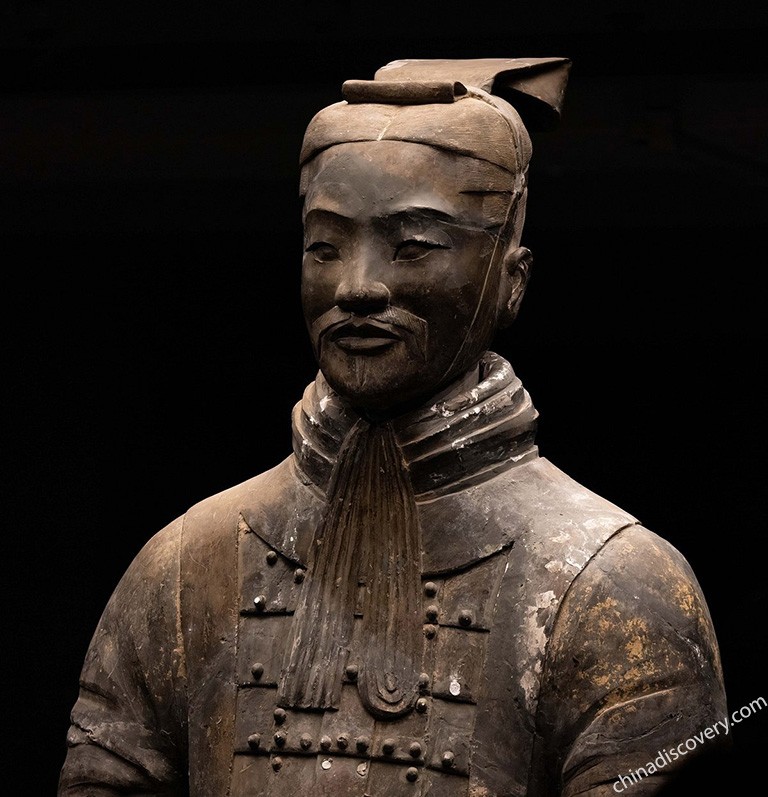
Terracotta Warriors and Horses Visiting Tips
1. tickets & opening hours.
Tickets: ¥120 / person / time Sightseeing bus: free
Opening Hours:
March 16th – November 15th: 8:30-18:30 (no selling after 17:00)
November 16th – March 15th: 8:30-18:00 (no selling after 16:30)
Note : In order to control the number of visitors, there may limit the flow of visitors, so you'd better buy tickets in advance and make a reservation.
2. Tourist Service Center
There are three Tourist Service Centers, and they are located in the east of ticket hall, the south of the square before Pit 1, and the east of the landscape stone of Lishanyuan (丽山园). The service center can accept complaints, and provide medical assistance, consultant, wheelchair and stroller for free, and tourists can charge their mobile phone and take a rest at the service center.
There are free toilets in the museum. As for the specific location, please refer to the guide indicator.
4. Guide Service
The museum provides professional guide service in Chinese, English and Japanese, and tourist can make a reservation for the guide service of the expert in the museum. There are also non-scheduled free consulting services provided by volunteers.
5. Photography Notice
To protect the Terracotta Warriors and Horses, please turn off the flash of your camera when you take photos.
6. Weather Tips
The weather of Xi’an is very dry, drink more water and use some moisturizer to help your skin retain moisture. If you come in summer, use some sun block to protect your skin from the strong UV of Xi’an.
7. Replicas Shopping
If you are keen on the terracotta warriors, you can buy some terracotta replicas outside of the museum. Many souvenir shops in Xi’an city center also sell terracotta replicas.
How to Plan a Xi'an Terracotta Warriors Tour
Xian has a lot of places to visit. Terracotta Warriors and Horses is definitely the No.1 must-see. After that, take a stroll or rent a bike on the Ancient City Wall , the largest and best-preserved ancient city wall in China, to enjoy panoramic views of modern Xi’an. Then try some local snacks at the bustling and lively Muslim Quarter . On the next day, you can go to visit Da Cien Temple and Giant Wild Goose Pagoda to feel the Buddhist culture, then get a deeper understanding of the past of this city in Shaanxi History Museum . If you are interested in mountain climbing, don’t miss the challenging Mount Huashan which is famous for lofty peaks and steep paths. If you have other ideas or questions about a Xian tour, please feel free to contact us . We are also specialized in customized tours according to your own requirements, interests, travelling budgets, etc.
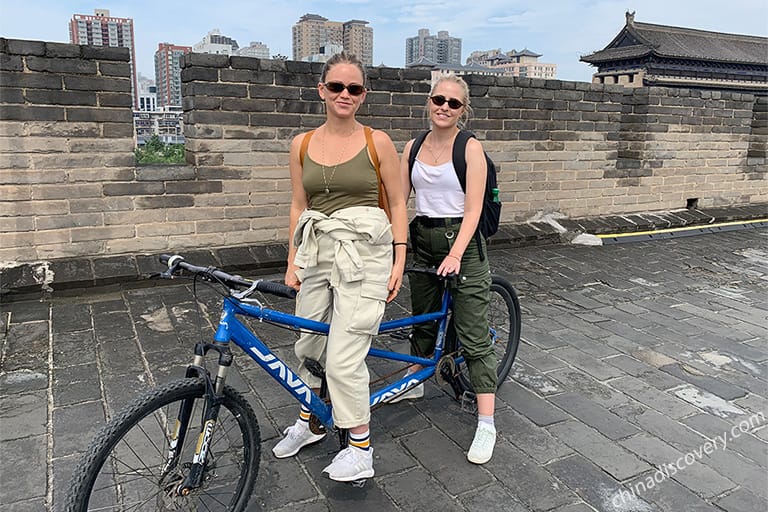
12 Important Things to Know about the Terracotta Army
It’s always a truth to do some homework before visiting a great cultural spot, same to the Terracotta Army. During the short trip, knowing relevant introduction and travel tips helps you understand the heritage better and memorize more interesting details tour guide may communicate with you. Otherwise, the finally-realized dream tour might be end up in taking tourists photos, watching yellow clay figurines you still knows basically from online. Below are very useful articles we picked for you, hope you refresh a Terracotta Army tour and return with nice memories.

Terracotta Warriors Tours
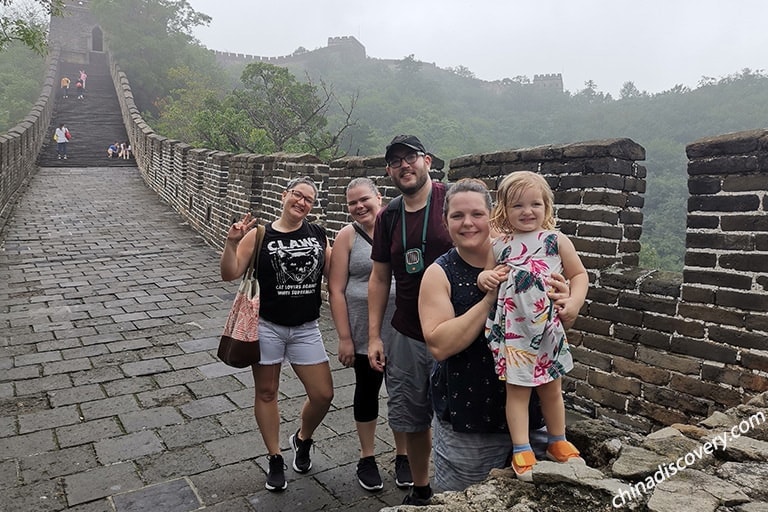
Beijing to Terracotta Warriors
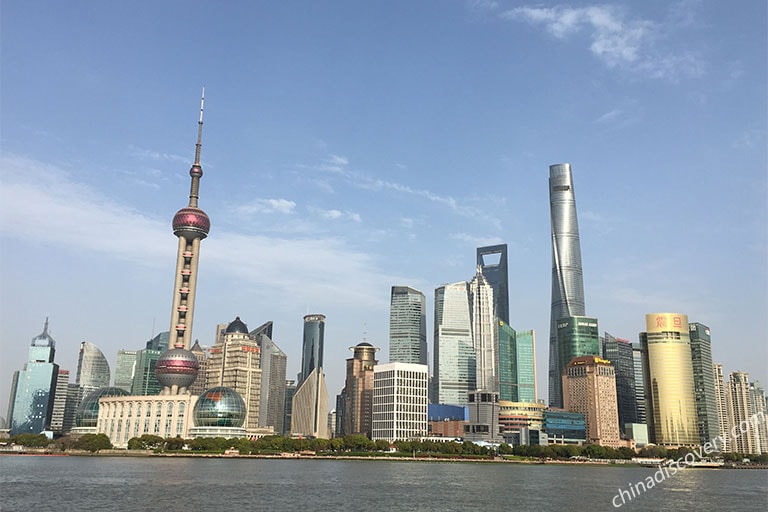
Shanghai to Terracotta Warriors

Buy Terracotta Warriors Tickets
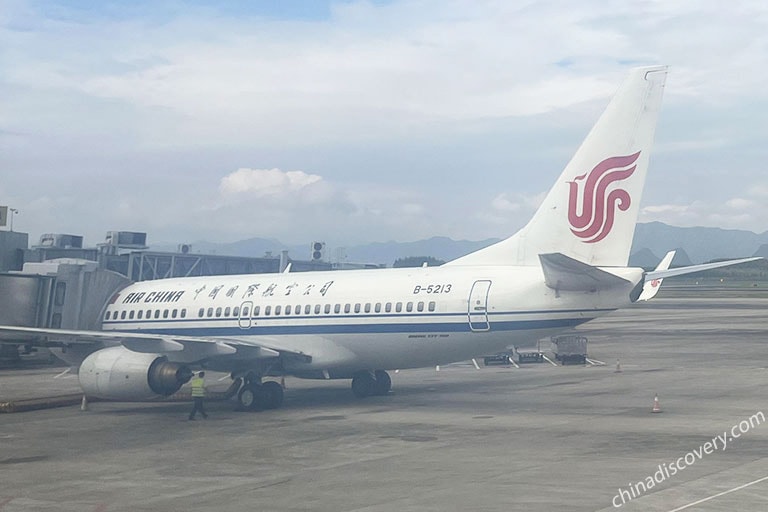
Airport to Terracotta Warriors
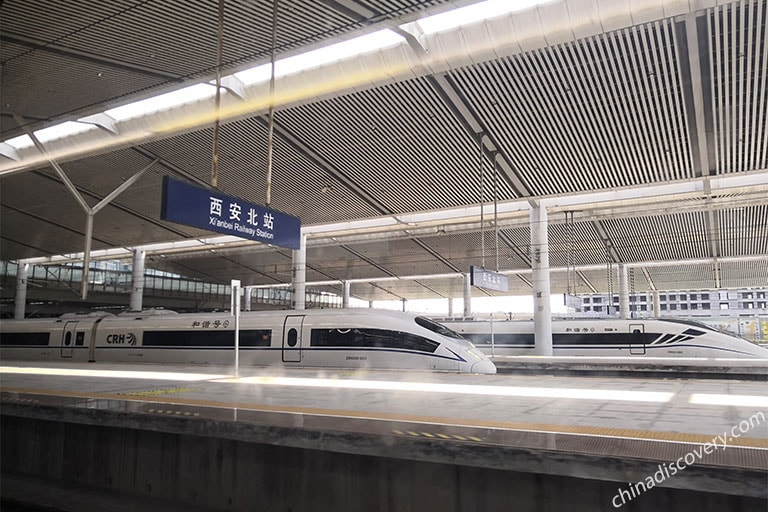
Train Station to Terracotta Army

Hotels Near Terracotta Warriors

10 Terracotta Warriors Facts

Terracotta Warriors for Sale

Terracotta Warriors Photos

Useful Terracotta Warriors Maps

Terracotta Warriors Location
- Beijing Terracotta Warriors Tours
- Shanghai Terracotta Warriors Tours
- Downtown Xian to Terracotta Warriors
Xian Essential Travel Guide
- Xian Travel Guide
- Xian Trip Planner
- Xian Sightseeing
- How to Spend 2 Days in Xian
- How to Spend 3 Days in Xian
- How to Spend 4 Days in Xian
- Top Attractions in Xian
- Xian Transportation
- Xian Weather & Seasons
- Recommended Xian Hotels
- Xian Visa Free
- Xian Food and Snacks
- Xian Nightlife
- Xian Tourism Board
Keep Reading on Xian Tours
- Xian City Tour
- Terricotta Warriors Tours
- Xian Huashan Tours
- Shanghai Xian Tours
- Beijing Xian Shanghai Tours
- Xian Chengdu Tours
- Xian Luoyang Tours
- Xian Silk Road Tours
Recommended Xian Tours
Top 3 Xian tours chosen by most customers to explore Xian in the best way. Check the detailed itinerary, or tailor your own trip now with us.
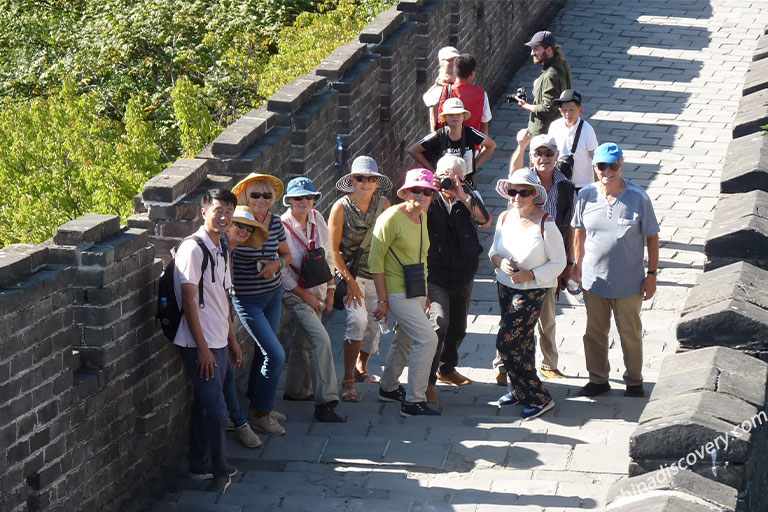
6 Days Classic Beijing Xian High-speed Train Tour (Most Valuable)
Beijing / Xian
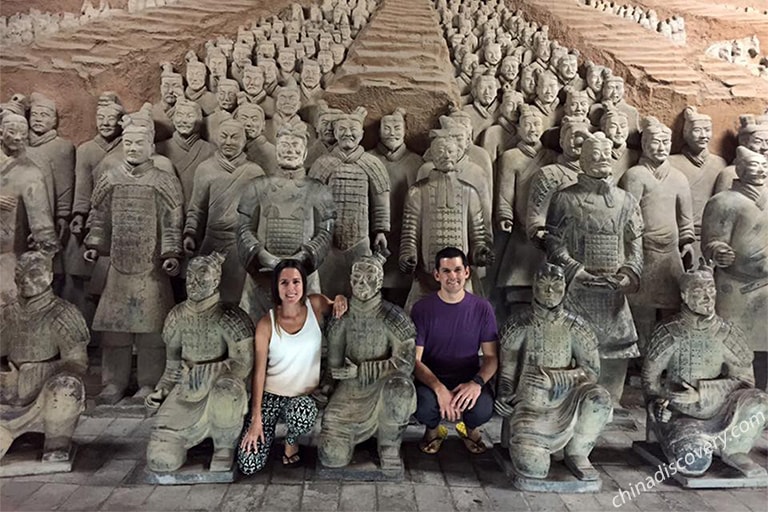
3 Days Classic Xian Tour (Best Highlights Plus Enjoyable Pace)
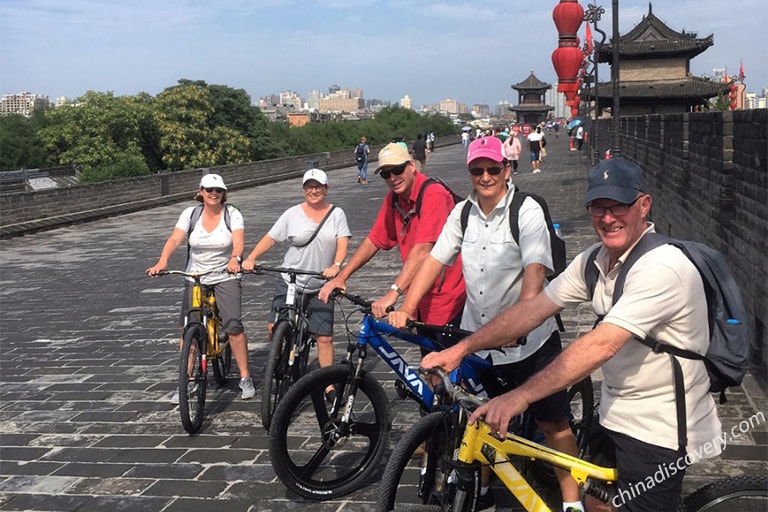
2 Days Xian City Break (Pick Up from Hotel, Train Station or Airport)
Start planning your tailor-made holiday to China by contacting one of our specialists. Once inquired, you’ll get a response within 0.5~23.5 hours.

Have a question? Get answers from our travel experts or guests
- Your Question:
- Your Email:
- Affordable and valuable price
- 100% tailor-made packages
- Highly rated customers reviews
- Efficient customer support
China Tours
- Top 10 China Tours
- Classic China Tours
- China Tours from Beijing
- China Tours from Shanghai
- China Tours from Hong Kong
- China Tours from Chengdu
- Short China Trips
- Customize China Tour
- China Panda Tours
- Family Tour with Kids
- High-Speed Train Tour
- Silk Road Travel
- Yangtze River Cruise
- Hiking & Trekking Tours
- Photography Tours
- China Minority Travel
- Beijing Shanghai Tours
- Shanghai Yangtze Tours
- Chengdu Jiuzhaigou Tours
- Chengdu Lhasa Tours
- Suzhou Hangzhou Tours
- Guilin & Yangshuo
- Zhangjiajie
“Very good experience”
“WONDERFUL 25 DAYS IN CHINA - PRIVATE TOUR”
“Awesome China tour from northeast to southwest”
Any questions, please email us at: [email protected] or call us at: 86-19138970032 (Monday-Friday 9 a.m. to 6 p.m. GMT+8)
- Terms & Condition
- Privacy Policy
- Customer Support
Copyright © 2011-2024. All rights reserved.
Cookie policy
We use cookies to give you the best experience on our website. Continue using our website means you agree with our cookie policy. For more info, please read here .

Change location
- Call us today from 9am 01993 838 925 01993 838 220 or
- REQUEST A QUOTE
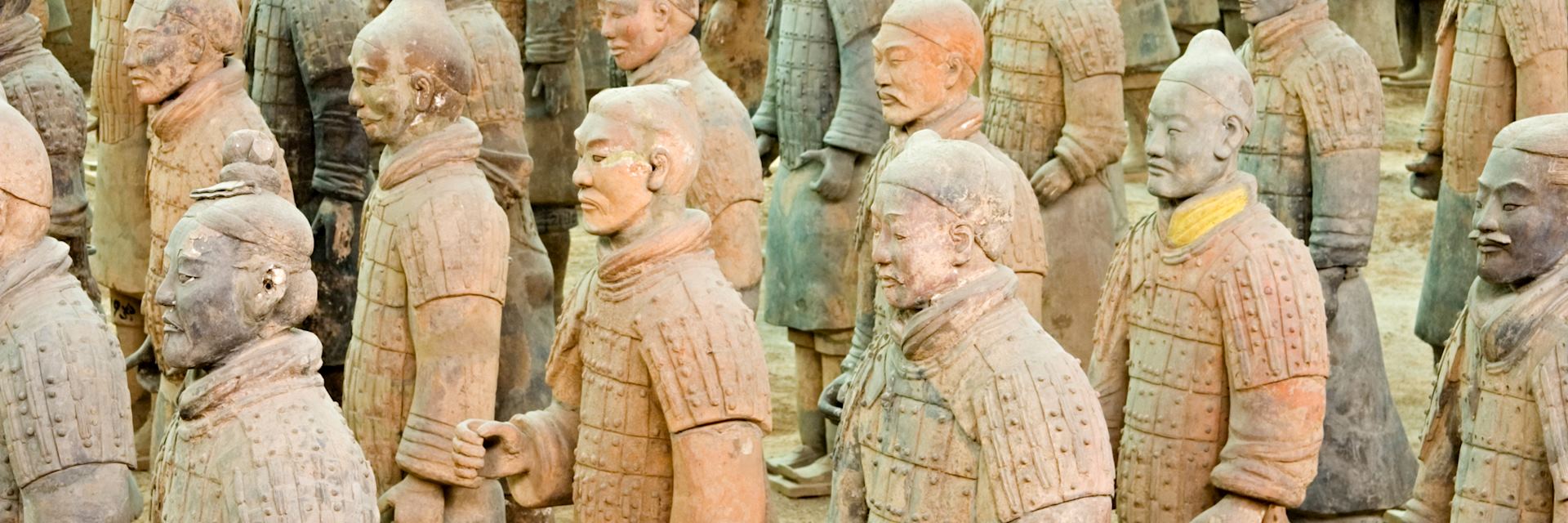
Our guide to exploring the Terracotta Army of Xian
By China specialist Chris
‘We’ve broken a Buddha,’ cried the farmers who stumbled across a pottery torso and head as they were digging a well near Xian, northern China. The year was 1974, and little did they know what they’d unearthed: a life-size army of 8,000 warriors and horses built to accompany China’s first emperor, Qin Shi Huang, in the afterlife. To date, only a fraction have been unearthed.
Today, the Terracotta Warriors rank high on many travel wish-lists. So, here’s my advice for how you can plan your visit in a way that will enhance your overall experience. And, don’t overlook Xian itself: there’s much more to China’s ancient capital than its archaeology.
Making the most of your visit to the Terracotta Army
A guide is essential for getting the most out of seeing the warriors . Not only will your guide go into detail about aspects that particularly interest you, but he or she will also point out elements that are little-known or not immediately apparent. Guides are also excellent at filling you in on the convoluted, soap-opera-like Qin dynasty politics.
The museum housing the warriors, located about an hour’s car ride from Xian, consists of three main ‘pits’ — vast underground chambers in which different sections of the army were discovered.

There’s a rush of noise, almost like the engine roar you hear on board a plane, as you step into the cavernous space of Pit One. And, appropriately enough, you’re standing in something more akin to an aircraft hangar than an exhibition hall. Your gaze tilts downward to the floor of the pit, and hones in immediately on row after row after row of austere, erect brown clay figures, staring intently ahead, battle-ready.
The size of grown men, their hands are curled around thin air, the halberd, spears and other arms they originally held having long since rusted away.
On a sweeping first glance, you might think that the warriors are carbon copies of each other. But look closer, and you’ll see subtle and not-so-subtle differences. After the initial impact of seeing the army face-on, my advice is to move to the sides of this vast room (where you won’t have to jostle the crowds for space) and spend several minutes studying a group of five or six warriors in detail.
What you don’t always get from pictures is how the warriors were purposely arranged to stand in imperial battle formation. There’s a vanguard of archers, flankers at the sides, charioteers in the middle (their wooden chariots are long gone, but their muscle-bound horses still accompany them) and a rearguard.
Different ranks and roles have different breastplates, hairstyles, and tunics. Some figures stand there like decapitated ghouls, their heads never located.
My guide, Leo, pointed out how the facial expressions of each warrior differ: some look solemn, some bellicose, some almost philosophical. A few seem to be breaking into a sly smile. Their physiques differ, too: some are stolid and barrel-chested, others slim and sinewy.
‘You know,’ said Leo, grinning shyly, ‘men from round here — people like me, whose families are from Xian — sometimes look at certain warriors and see our own faces reflected back at us. We think: hey, there’s my ancestor.’
You could spend hours in Pit One alone, but don’t miss (as many do) the ‘warrior hospital’ right at the rear. Here, you’re given a thrilling reminder that you’re visiting an active archaeological site, and you can witness the painstaking restoration work that’s still going on. Figures found broken into jigsaw-like fragments must be reassembled piece by piece.
Pits Two and Three
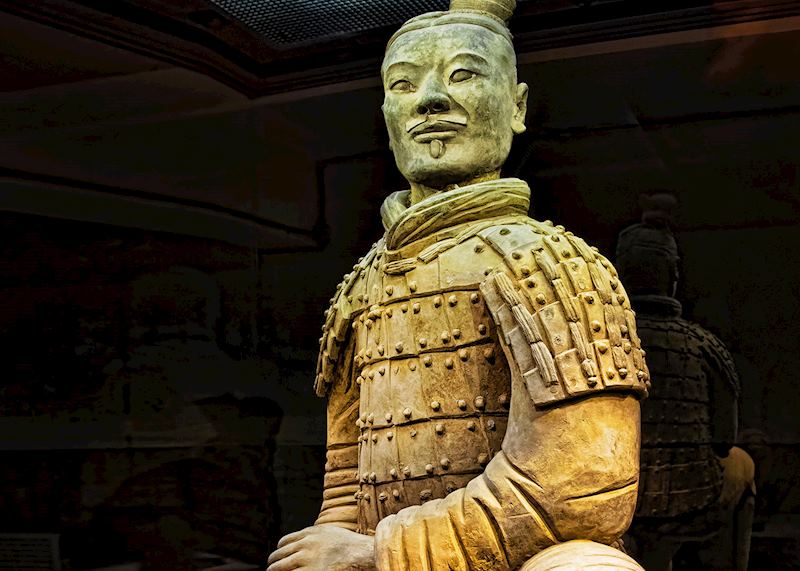
You can trust your guide to choose the quietest route for you around the complex. To that end, it can be a good idea to visit Pit Three before Pit Two. Although much smaller in size than Pits One and Two, Pit Three is like the Pentagon of the Terracotta Army. Here, you can get a good look at several immaculately restored generals in all their battle regalia (note their more elaborate double-knotted hairstyle, too).
A picture on the wall near Pit Three (easily missed) shows how the warriors were brightly painted until 32 seconds after they were unearthed, when the shades disappeared due to oxidation.
Like Pit Three, Pit Two is located in a large, darkened room. The pit itself is a mass of collapsed and petrified wooden beams, with broken figures and horses scattered pell-mell; it looks like they’ve just been brutally decimated in battle. (It also gives you a greater appreciation of the feat of the restoration work to date, as all the standing warriors were discovered in this state).
The main attractions in the Pit Two section are the statues displayed in individual glass cases, including a kneeling archer and a sage-looking military tactician. These displays allow you to inspect the details of the craftsmanship: you can see the ripple of muscle on the archer’s shoulder, and the tread on the sole of his boots.
Qin Shi Huang Emperor Tomb Artefact Exhibition Hall
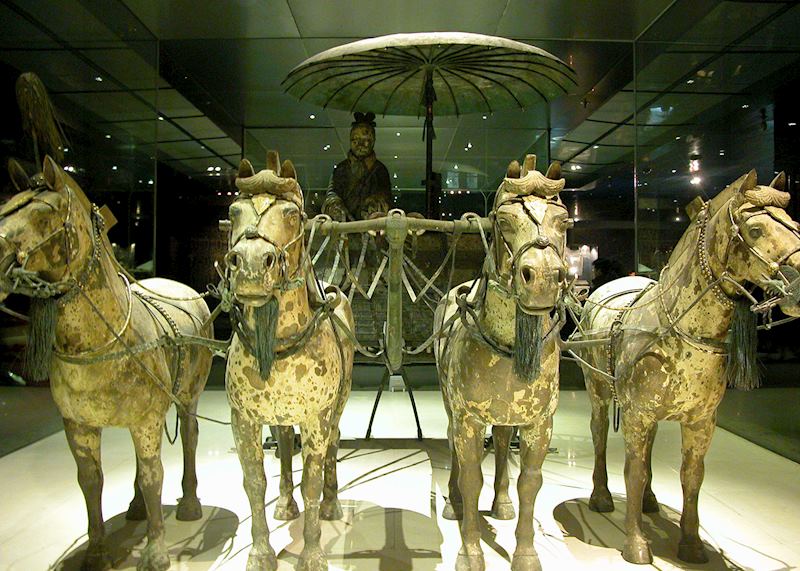
This darkened hall, separate to the main pits, displays some bronze chariots, horses and a sedan chair found 20 m (66 ft) west of the emperor’s tomb.
Although the metalwork is impressive (the horses, for example, wear delicate head ornaments), this room is often cramped and incredibly crowded. Unless you have a real interest in seeing these items, I suggest just passing through and having a peek. Better to reserve the lion’s share of your time for Pit One — and guides usually allow time for a second visit to this most imposing of pits before you leave the complex altogether.
Best time of day to visit the Terracotta Army
The truth is there will always be crowds when you visit the Terracotta Army. Chinese domestic tourism is booming and, understandably, the warriors are a prime attraction. If you can handle an early start, the best time to visit is when the museum opens at 8.30am.
Most visits last around two hours. Crowds swell as the day wears on, though, and you might still share your visit with several tour groups despite an early start. My advice is to be stoical about it all. This does mean accepting that, at some point, you might well be elbowed out of the way by someone brandishing a selfie stick and a smartphone.
Guides will help you get to the quieter spots and find you the best vantage points over the pits. On a private tour, you’ll find it much easier to weave your way through the big tour groups and the complex as a whole.
Where to stay in Xian

The museum housing the Terracotta Army is located right on the outskirts of Xian, and there’s little of interest in the immediate vicinity. I’d opt to stay at the Sofitel inside Xian’s old city walls — not only will you have access to some of the best restaurants, but you’ll be able to walk the city walls easily, as well as the night market in the Muslim Quarter.
What is the Terracotta Army?
The 8,000-odd warriors and horses were made out of fired clay and construction started in 246 BC.
The figures were found close to the site of Qin Shi Huang’s mausoleum, now a forested hump rising from the plains outside Xi’an. You might just glimpse it in the distance on your way to view the warriors in their purpose-built museum.
There’s a grisly backstory to their existence: before Qin Shi Huang, combatants would be buried alive alongside their leader on his decease. Seeing this as a waste of human resources, Emperor Qin decided to engage a huge taskforce in creating sculptures modelled precisely on his own imperial army.
Reputed to be a tyrant in life (despite his considerable achievements, such as standardising Chinese writing), one theory goes that he desired an army to defend him in death.
Read more about trips to China
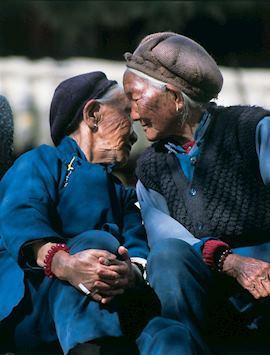
Highlights of China: Beijing, Xian, Guilin & Shanghai
12 days from £3,995pp
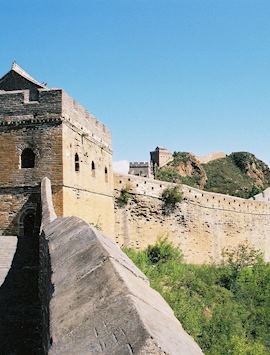
Classic China tour
15 days from £4,585pp
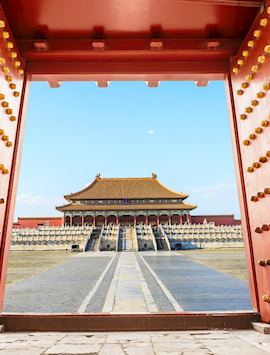
China in style: luxury Yangtze cruise
12 days from £9,170pp
Start thinking about your experience. These itineraries are simply suggestions for how you could enjoy some of the same experiences as our specialists. They’re just for inspiration, because your trip will be created around your particular tastes.
Further reading
- What to do in China: our highlights guide
- The Great Wall of China: taking a quieter path
- A guide to Chinese food (and where to find it)
Plan your trip
Tell us about your plans and one of our specialists will plan a unique trip for you...
Request our brochure, The World Your Way

Order your digital copy via email.

One Day Private Tour to Terracotta Warriors
- Code XA01-01
- Tour Style Private
- We Promise No Shopping
- Free Cancellation 24-hour Before
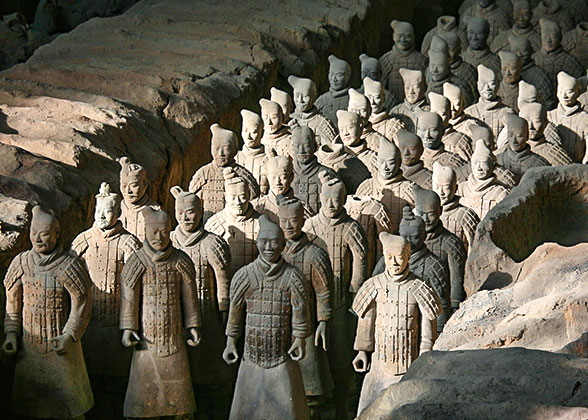
Finish the morning visit, and you will have some free time to enjoy lunch at your own expense. It is suggested to go back to downtown area for more and better lunch options. Your guide will be glad to offer some local food suggestions, like the popular Chinese hamburger, Rou Jia Mo, which has been listed as the Intangible Culture Heritage of Xian. Since you may have lunch at a later time, having a big breakfast at the hotel is necessary! After lunch, we will head to visit the Small Wild Goose Pagoda , a delicate 13-floor Buddhist pagoda surviving for over 1,300 years from the Tang Dynasty (618 – 907 AD). With a nice park around, you can take a leisurely stroll while enjoying the ancient Chinese architecture. You will then be guided to visit the encircled ancient City Wall , on which you can take a leisure walk and enjoy the city view from a unique perspective. Bikes, single and tandem, are also available to rent for pedaling around. It may be energy-consuming, so we leave the choice on you. If you are interested, your guide will help you with bike renting. Today's last stop is the well-known Muslim Quarter , boasting various interesting shops and a wide range of local foods. The busy community is full of local atmosphere and you will be amazed by its lively ambience. Try authentic local specialties like lamb pita bread soup, beef and lamb BBQ, and nice noodles. The 500-meter (546-yard) long main street paved with blue stones and under the shade of large trees is definitely worth having a nice and delicious evening stroll. Finally, we will send you back to the hotel. Your one-day Xi'an Terracotta Army tour just comes to an end here, and we hope you can enjoy it!
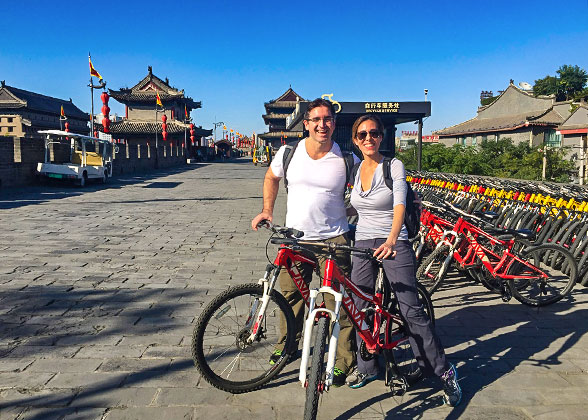
- Pick-up & drop-off from your hotel
- Entrance fees as indicated above
- Professional English speaking guide
- Experienced driver & air conditioned vehicle
- Two bottles of mineral water per person
- Bicycle hire
- Tips or gratuities for guide and driver
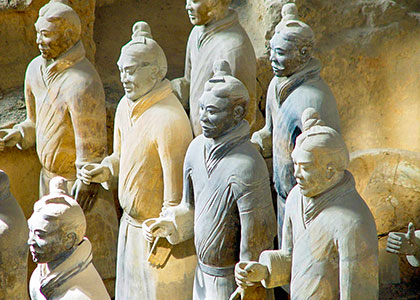
- Inquiry Form

Terra Cotta Warriors Tours & Travel Packages 2024/2025
Our 24 most popular terra cotta warriors trips. compare tour itineraries from 22 tour companies. 27 reviews. 4.8/5 avg rating., popular terra cotta warriors tours.

Majestic China & Yangtze River 14 Days 12 Nights
- Visit the Great Wall, which is one of the man-built architectures
- Visit to the world-famous and historic Tiananmen Square
- Explore Yichang,the cultural and economic center of the western Hubei Province
- Explore the Three Gorges Dam Site, located in the middle of the Xiling Gorge
- Enjoy a memorable excursion to cruise along the serenely beautiful gorges of the Yangtze

China Sampler
- With only 16 guests or fewer, you’ll have a better vantage and more time at the Terra Cotta Army.
- Feel the ancient rhythms of Xian as you explore the Muslim market with an engaging, savvy resident.
- Delve into the traditional ways of China when you meet tea farmers at their home near Hangzhou.
- An intimate stroll along historic Pingjiang Road is the best way to appreciate the splendor of Suzhou’s centuries-old Song Dynasty architecture.

China Special Value Tour
- Explore Beijing, China's political and cultural centre
- Visit impressive Tiananmen Square and Tiananmen Square
- Visit Xian's magnificent city wall and Wild Goose Pagoda
- See the awesome Shanghai Museum - an ultra-modern repository for 5,000 years of history and culture

The Silk Road Aboard the Golden Eagle & Shangri-La Express
- 4,000 miles along the Silk Road between Moscow and Beijing, with Turkmenistan, Uzbekistan and Kazakhstan
- Ride camels in the Gobi Desert, marvel at the Terracotta Warriors, and soak up Islamic architecture in Khiva
- Opt for an abridged 13-day trip aboard the Golden Eagle from Moscow to Almaty (or reverse)

Roof of the world
- Experience 6-day Yangtze River cruise in veranda stateroom
- Visit 5 UNESCO World Heritage Sites
- Culture Curriculum: Enjoy tea with a Tibetan family; attend lectures on the Yangtze River, Mao Zedong & China’s current affairs; practice tai chi every morning aboard.
- Enjoy a concert of the Hubei Bells
- Learn a few Chinese words

Highlights Of China
- Explore Terracotta Warriors
- Explore the exotic streets of the Muslim Quarter
- Discover Tiananmen Square
- Visit to Forbidden City

Incredible Zhangjiajie
- Must-see sights in China -the Great Wall, Forbidden City, Terracotta Warriors
- See the floating mountains of Avatar in reality in Zhangjiajie Forest Park
- Have an exciting walk on the world's highest and longest glass bridge
- View the soaring city skylines and feel the pulse of modern Shanghai

Secret China: Zhangjiaji, Zhangye, Dunhuang & Beyond
- Discover Beijing
- Visit Temple of Heaven, Beijing Zoo, Lama Temple
- Experience the Architectural tour to Yu Garden, Jewish Quarter
- Explore Terracotta Solider and Horse Museum Shanxi Historical Museum
- Visit Fenghuang Ancient Town
All Terra Cotta Warriors , expedition cruises, self guided adventures and vacation packages. Find the best guided and expert planned vacation and holiday packages. Read more about Terra Cotta Warriors

Small Group Terra Cotta Warriors Tours

China Dreams
- Enjoy Beijing city tour See Tiananmen Square, the biggest square in the world Visit the Great Wall at Mutianyu, a post along the wall offering breathtaking views Visit the Summer Palace, which includes a grand collection of lakes, gardens Explore Terracotta Warriors, a stunning collection of ten thousand life size statues Visit to the Shaanxi Museum which houses over a quarter of a million artefacts on display Discover Zhujiajiao, an ancient water town with a history

Pandas & Yangtze Cruise
- Must-see sights - the Great Wall, Forbidden City, Terracotta Army, Giant Pandas
- Fantastic cruise tour on the Li River from Guilin to rural Yangshuo
- Have a once in a lifetime chance to get close to the incredibly cute treasure -Pandas
- Take in the impressive skylines of Shanghai as you walk along the Bund

Golden Triangle & Yangtze
- Must-see sights in China - the Great Wall, Forbidden City, Terracotta Warriors
- Unwind with a Yangtze River cruise tour & see the Three Gorges
- Walk into a local Chinese family, interact & dine with the hosts in their home

Impression China
- See the giant pandas up close in the Panda Breeding and Research Center
- Soften and scent your body from head to toe on Yangtze River cruise

Classic China
- Opportunity to cruise Li River is the essence of landscape
- Explore Guilin
- Visit to Tiananmen Square and Forbidden City
- Discover Shanghai
- See the amazing Badaling Great Wall
Best Terra Cotta Warriors Tours by Duration
Tours, Cruises & Private Trips
Best Terra Cotta Warriors Tours by Price
Top Terra Cotta Warriors Attractions & Experiences
Terra Cotta Warriors Tours & Travel Guide
Terra Cotta Warriors Attractions & Landmarks Guide
The Terra Cotta Warriors are a quintessential attraction to visit while visiting China . The collection of army figures was discovered in 1974. They were designed to depict the army of Qin Shi Huang, the first emperor of China, and are situated in his tomb, as a funerary gesture - they are there to protect him in the afterlife. You can visit the tomb, and it makes for some excellent photos!
Terra Cotta Warriors Reviews & Ratings
Small Group Tour to China Cancelled
Paid In Full to Go Nowhere
I chose the small group China Sampler and paid in full in December 2018 for the April 2020 departure to get the $300 discount. After that it was just waiting and wa...
Bucket list gal
They took very good care of me as I was a woman traveling alone, never once did I ...
Unforgettable experiences
During our one-month long honeymoon across China we booked two tours with TCG. The first was a 5-days tour in Zhangjiajie visiting the glass bridge, the national par...
We had an incredible journey
We had an incredible journey in China! First, we want to thank TCG for obtaining our permit. It was delivered to our hotel in advance of our journey into Tibet and w...
It was all good organized
First of all I would like to say that we enjoyed our holiday a lot. It was all good organized and we didn't have to worry about anything. We could just enjoy and rel...
See all Terra Cotta Warriors reviews
Terra Cotta Warriors Tours FAQ
1. Does Travelstride have all the tour operators?
2. How does the Member Savings program save me money?
3. Can I trust the tour operator and trip reviews on Travelstride?
4. What does ‘Stride Preferred’ mean?

IMAGES
VIDEO
COMMENTS
The Terracotta Army in Xi'an, aka Terracotta Warriors and Horses, is a super large collection of life-size terra cotta sculptures in battle formations, reproducing the mega imperial guard troops of Emperor Qin Shi Huang (259 - 210BC), the first emperor of the first unified dynasty of Imperial China. Being the most significant archeological ...
Most visitors will travel to Xi'an first, stay a night at a hotel in downtown for a good rest, and then take a one-day tour to the Terracotta Army on the next day. 1. Learn some basic facts before visiting Terracotta Army. Location: in Lintong District of Xi'an, about 40 km (25 mi) from downtown.
The Terracotta Warriors are located in the city of Xi'an, in the Shaanxi province of China. Specifically, they are housed in the Qin Shi Huang Mausoleum, which is situated about 1.5 kilometers east of the Emperor's burial site. The mausoleum complex includes three main pits where the Terracotta Army is displayed.
Tips for Visiting the Terracotta Army. 1. Consider walking from the parking lot to the entrance. The parking lot is about 1 km from the entrance. There are shared golf carts running from the parking lot to the entrance. As you need to queue for them (in the busy travel season from May to October), we recommend you walk the 15 minutes or so ...
Learn about the history, construction, and significance of the Terracotta Army, a collection of more than 8,000 terracotta warriors and horses built to protect the tomb of Emperor Qin Shihuang. Find out how to visit the museum, see the pits, and explore the stories behind this ancient wonder.
The site of the Terracotta Army Museum is approximately 40 km from Xi'an city center but can easily be reached by bus or car. There is an affordable tourist bus that leaves from Xi'an Railway Station at regular times throughout the day; the bus costs 7 CNY and takes about an hour to reach the museum site. You can also take a taxi from Xi'an for ...
The history of Terracotta Army dates back over 2,200 years. It was built from 247BC or 246BC to 208BC for the purpose of protecting Emperor Qin Shi Huang in his afterlife. It has suffered a number of natural disasters and man-made destructions. In 1974 this man-made wonder was discovered by local farmers when digging a well, then excavated and ...
Attraction name: The Qin Tomb Terracotta Warriors and Horses Chinese: 秦陵兵马俑 Qínlíng Bīngmǎyǒng /chin-ling bing-maa-yong/ Features: hundreds of life-size terracotta soldiers, horses, and chariots in battle array Construction: 246-206 BC.With the tomb of Emperor Qin Shihuang it took 720,000 builders. Time needed: half a day Suited for: history and Chinese culture enthusiasts
There are three major pits for the Qin Terracotta Army, covering over 20, 000 square meters (5 acres) in total. Nearly 8,000 pieces of terracotta warriors are unearthed from the three pits, all being the same size of a real man and horse. Meanwhile, the bronze chariots and horses, and Qin weaponry are also very stunning to see.
Best Time to Visit Terracotta Warriors & How to Avoid Crowds. The Terracotta Warriors is an indoor attraction, making it accessible year-round without being affected by weather conditions.However, the Terracotta Warriors Museum is one of the must-see attractions in China, and its popularity among tourists can lead to crowding, especially during peak travel seasons.
Location . A visit to the terracotta army is made from Xi'an (pronounced She-ahn), the capital of Shaanxi province. Xi'an lies to the southwest of Beijing.It is approximately a one-hour flight, or an overnight train ride from Beijing, and is easy to add on if you are already visiting Beijing.
Here are some explanations. 1. The Terracotta Army is an important part of the mausoleum of the first emperor in Chinese history. The Terracotta Army has been proved to be a part of the mausoleum of Emperor Qin Shi Huang, the first emperor in Chinese history. On one hand, it stands out of imperial tombs through all dynasties in terms of size ...
Hire an audioguide - This costs ¥40 but you'll need another ¥200 for a deposit. The guide is a little dull and rather limited. Hire a guide at the entrance - There are plenty of English speaking guides available and thy charge a variable rate, but usually, it is around ¥150. Chat to a few to find out if you like them.
The Terracotta Warrior Army site is located about 50km from the centre of Xi'an. Many visitors opt to take a guided tour of the site, which offers in-depth insights about the culture, history and archaeology of the site. There are also city buses that run from Xi'an Railway Station to the site, taking about an hour, and official tour guides ...
Episode 2: Shaolin Temple - Birthplace of Kung Fu. Episode 3: Yuntai Mountain Geo Park. Episode 4: Luoyang - Peony, Temples and Grottoes. Episode 5: Xi'an - Terracotta Warriors Museum. Episode 6: Mount Hua and Plank Walk. Episode 7: Xi'an - 2 Day Itinerary in the City. Episode 8: Xi'an - Tomb of Emperor Jingdi and Yuan Jia Cun.
The Terracotta Warriors is located in Lintong District, about 40 kilometers (25 miles) to the northeast of Xi'an downtown. Currently, travelers can take metro line 9 to Huaqing Pool Station from Fangzhicheng and then transfer to Lintong Bus 602 or Lintong Tourist Bus Line 613 to Terracotta Army; or take Tourist Bus No. 5 (306) from Fangzhicheng to get there directly.
How to Get to the Terracotta Warriors. The Terracotta Warriors are located about an hours drive outside of Xi'An. You can reach the tombs by rental car, public bus, take a cab or DiDi (the Uber of China), or with one of the many tourist buses. It cost 150 Yen, roughly $20 USD to enter. If you have a student ID then it is half the price.
Buying Tickets for the Terracotta Warriors. The museum is usually open from 8:00 AM to 6:00 PM. The ticket will cost you RMB150 ($21 USD) per person. This price includes entry to the vaults and museum, plus the documentary film of the warriors and their excavation. You can buy tickets at the site, or ahead of time if you book with a tour group.
Our guide to exploring the Terracotta Army of Xian. By China specialist Chris. 'We've broken a Buddha,' cried the farmers who stumbled across a pottery torso and head as they were digging a well near Xian, northern China. The year was 1974, and little did they know what they'd unearthed: a life-size army of 8,000 warriors and horses ...
Why Is Terracotta Warriors and Horses Important. Reputed as one of the greatest archaeological finds in the twentieth century and the eighth wonder of the world, buried at 1.5 km east of Qinshihuang's Mausoleum, Terracotta Army or Terracotta Warriors and Horses (兵马俑) is the funerary object of Emperor Qinshihuang (259~210 BC), the first Emperor of China.
Terracotta Warriors, Xian. By China specialist Chris. 'We've broken a Buddha,' cried the farmers who stumbled across a pottery torso and head as they were digging a well near Xian, northern China. The year was 1974, and little did they know what they'd unearthed: a life-size army of 8,000 warriors and horses built to accompany China's ...
Bell and Drum Towers - Stone Steles Museum - Banpo Museum - Shaanxi History Museum - Big Wild Goose Pagoda from USD119. One Day to Mt. Huashan from USD179. Join our Terracotta Army tour, you will be escorted by expert guide to get close to Terracotta Warriors, enjoy the Small Wild Goose Pagoda with Museum, and walk or cycle on the Xian City Wall.
The Terra Cotta Warriors are a quintessential attraction to visit while visiting China. The collection of army figures was discovered in 1974. They were designed to depict the army of Qin Shi Huang, the first emperor of China, and are situated in his tomb, as a funerary gesture - they are there to protect him in the afterlife.